Get monthly coaching and support to FINALLY gain momentum in your business without burning out in the process. 🦄 Learn more about WAIM Unlimited.




Welcome to our series called Growing Through It where we makeover a member of our community’s business (and you get to follow along and learn tips and strategies for your own business).

We’re going to offer suggestions of how you can take advantage of this collective slow down that we’re all going through and come back even more strategic and even better when this is all over. If you’re a business owner trying to figure out what the heck to work on right now, we want to help you strengthen the foundation of your business with this series.
In this first installment of Growing Through It, you’ll meet Eman. Eman runs a copywriting business called InkHouse and is currently trying to transition her business to focus on helping online course creators with their sales copy and sales emails.
Here’s, specifically, what we’ll go through in this case study:
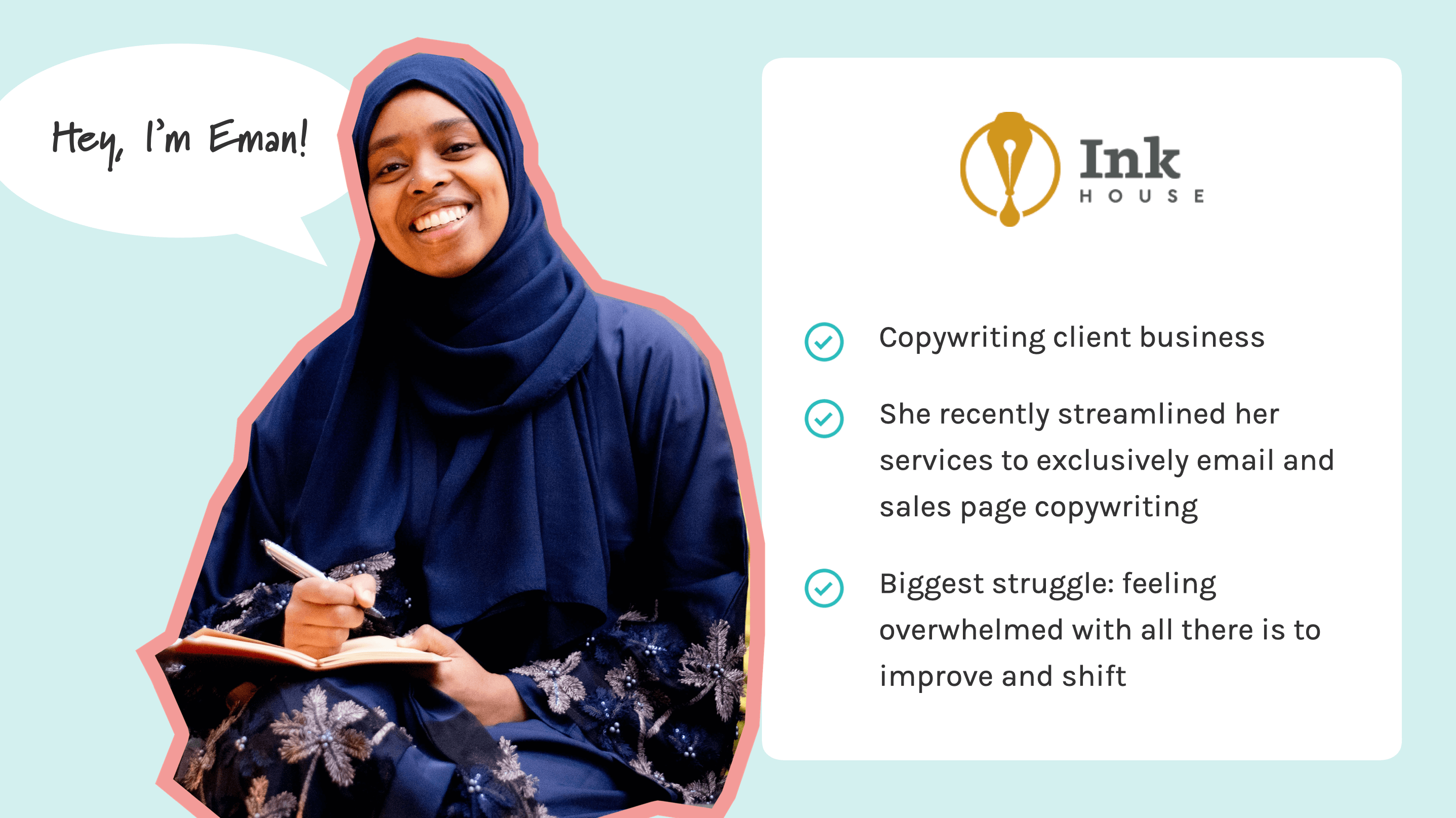
If you’re a video fan, watch the entire case study unfold in the embedded video below. Otherwise, you can keep scrolling and we’ve written everything out for you. 👍👍

Eman is the owner of InkHouse, a copywriting client business.
Eman has a number of existing services right now, but she plans to pivot her business and streamline her services to exclusively offer sales page and sales email copywriting. That’s where we step in!
Can you relate to Eman? Are your current client-service offerings no longer working? Or do you want to make a jump in a different direction with your business?
We hope the recommendations we make for Eman throughout this case study are steps that can help YOU rethink and re-evaluate your own situation with a bit less overwhelm.

When it comes to your brand foundation, your brand isn’t just your logo and your colors. It’s about having clarity on who you help, why you want to help those people, what you do to help them, and how you help them.
Note: We WILL get to some simple branding and design tweaks in Step #5.
One of the first things we did with Eman’s business was to try to answer these questions and then share the tweaks we’d make to build a more compelling brand foundation.
After looking at Eman’s website home page, there was a headline that read, “helping you grow your brand.” It wasn’t immediately clear who the who (hah!) was on the first page of her site. We moved on to the about page, and found a section mentioning a startup owner, an owner of an established business, a nonprofit or a marketing professional.
Eman was falling into the “who” trap that we see so many business owners fall into, trying to serve too many different customers.
When you cast your net too wide it becomes hard for people to see you as the expert they need to hire to solve their problems. People want to know definitively that YOU are the answer they’ve been looking for.
🔥 HOT TIP 🔥 If you offer a broad service like copywriting or design, try to narrow down your audience to just ONE specific type of client. It may feel limiting at first but trust us, the more focused you can get on who you help, the easier it will be to get more paying clients.
To stop casting that wide net and to attract more of her ideal customers (and knowing that she plans to streamline her services to sales page and email campaign copy), we recommend Eman narrow her focus to online course creators moving forward. This gives her a specific type of business owner to attract—one that she knows has a need for her specific copywriting services.
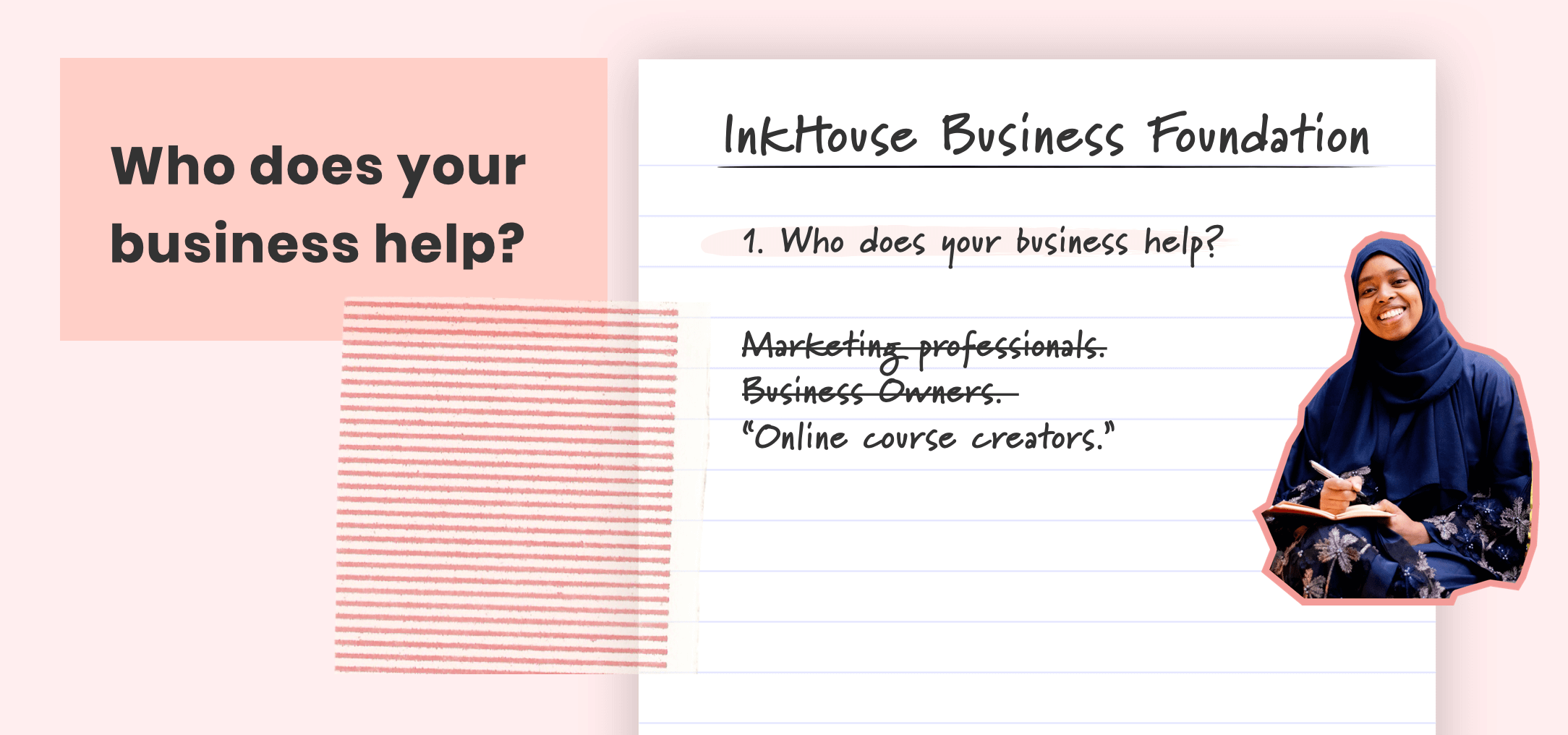
We like to think about the “why” question in two ways:
As we looked at Eman’s website, there wasn’t a crystal clear why being shared. We found a section that said, “You’re doing something amazing and your audience deserves to know about it.” This is OKAY but we know Eman could go deeper and really hook her potential customer in.
🔥 HOT TIP 🔥 If you can connect your brand’s existence to something that’s bigger than just you, you can forge a stronger connection with customers who feel your mission aligns with their values.
For Eman’s mission, we believe a strong why would be something like: My mission is to help you get your course into the hands of more people to amplify your impact and improve the lives of as many people as possible.
By thinking about her target audience and what their mission would be, Eman can make her mission about being a facilitator for what her target wants. If she knows they crave impacting more students, aligning with that makes her a compelling collaborator.
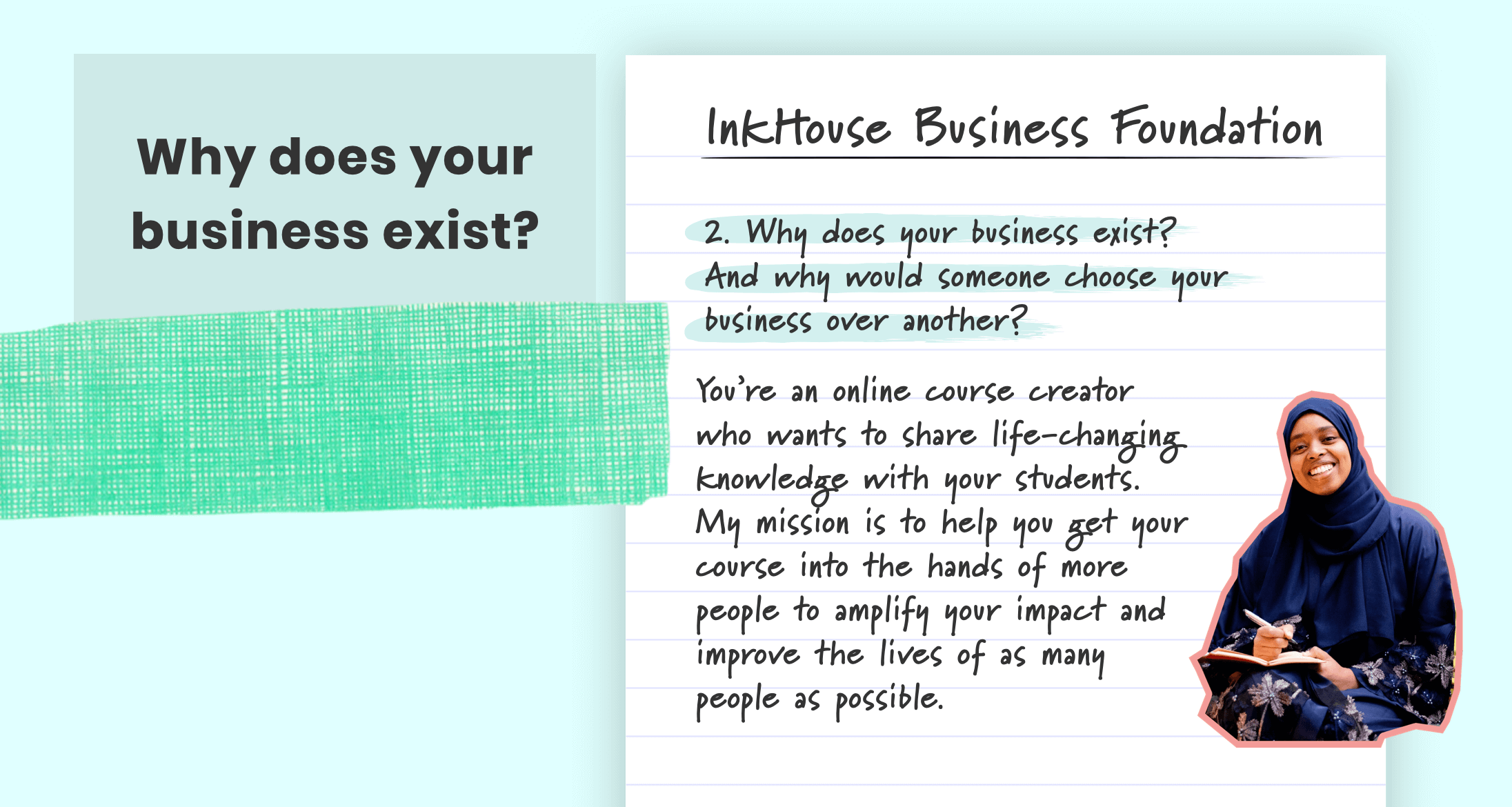
Most people get this question wrong by listing out all the features of the service they offer (it’s a common mistake we’ve made in the past too!) The better version of the what question at this point is: What specific outcome does your business provide your customer?
For Eman, the closest “what” answer we could find was the, “helps you grow your brand through my copy” line. But what exactly does that mean if you think about it from the customer’s perspective? How can you put that in terms way more tangible and specific?
🔥 HOT TIP 🔥 Paint the picture of the life you want your customer/client to have after they hire you. What specifically will happen in their lives that your product or service is going to provide to them?
To really grab her customer’s attention, we would say Eman’s what is: With clearer, more compelling copy, my clients are able to grab the limited attention of their audience to forge a stronger connection and increase their sales.
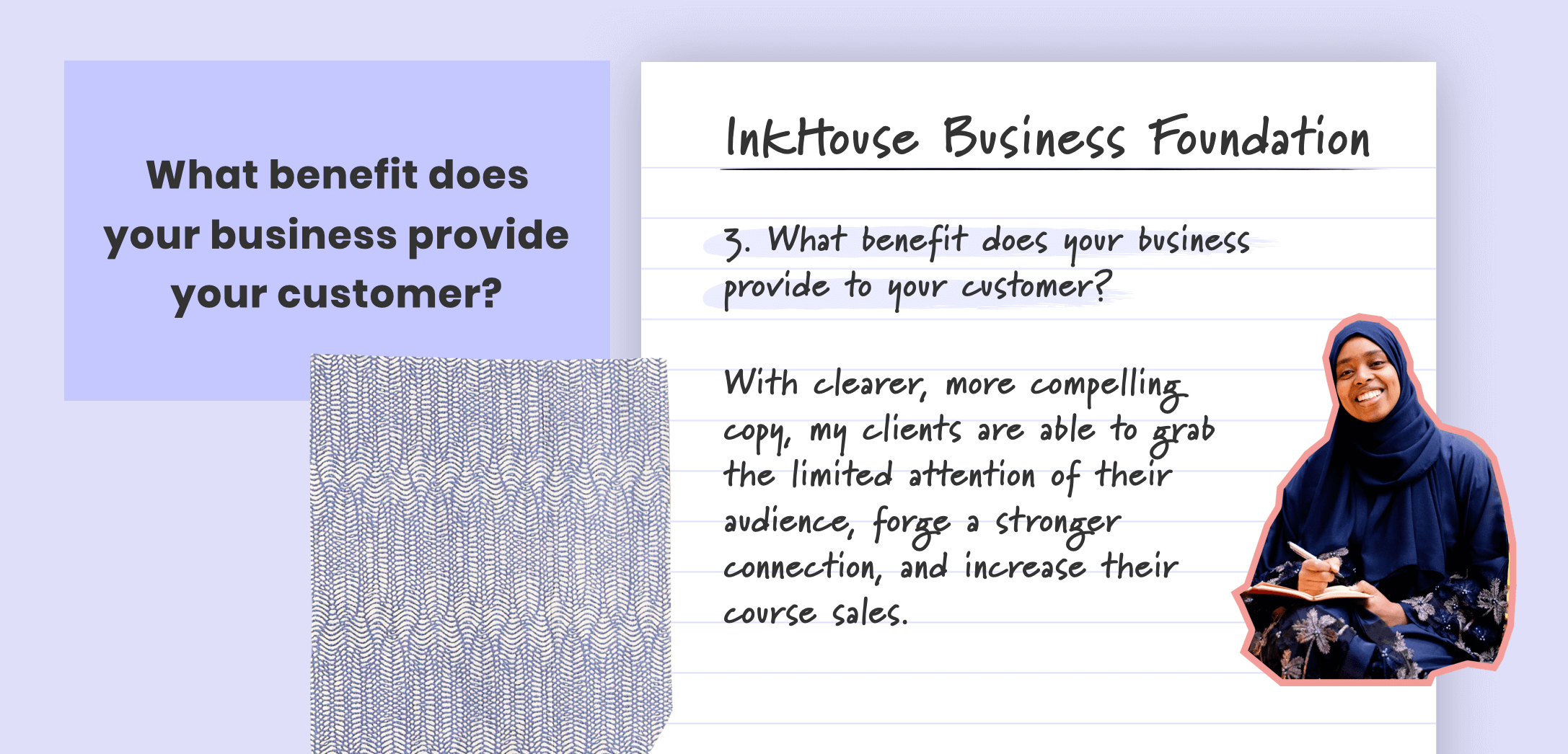
Remember those features we just mentioned in the what question? Now is the time to bring those puppies in! Your how refers to how you deliver on the benefit you’re promising. It’s your offering.
On Eman’s website, we found a few different ways she delivers the benefit. There was web copy, email writing, blog post creation, and writing workshops, to name a few. Having this variety on your website might seem appealing but to your potential client it’s just too many options and Eman already told us that with this pivot, what she really wanted was to narrow down to writing conversion-boosting sales and landing pages as well as click-worthy email campaigns.
And while that was one step closer, we thought she could still get more specific with her offerings.
🔥 HOT TIP 🔥 Your potential client/customer shouldn’t have to fill in the blanks of exactly what you can do to help them. They are searching for an answer to a specific problem, so make sure what you do is that answer and display it clearly.
Our shift for Eman is going to focus on writing sales pages and sales emails. Every course creator needs these copywriting tasks (and most loathe doing them!)
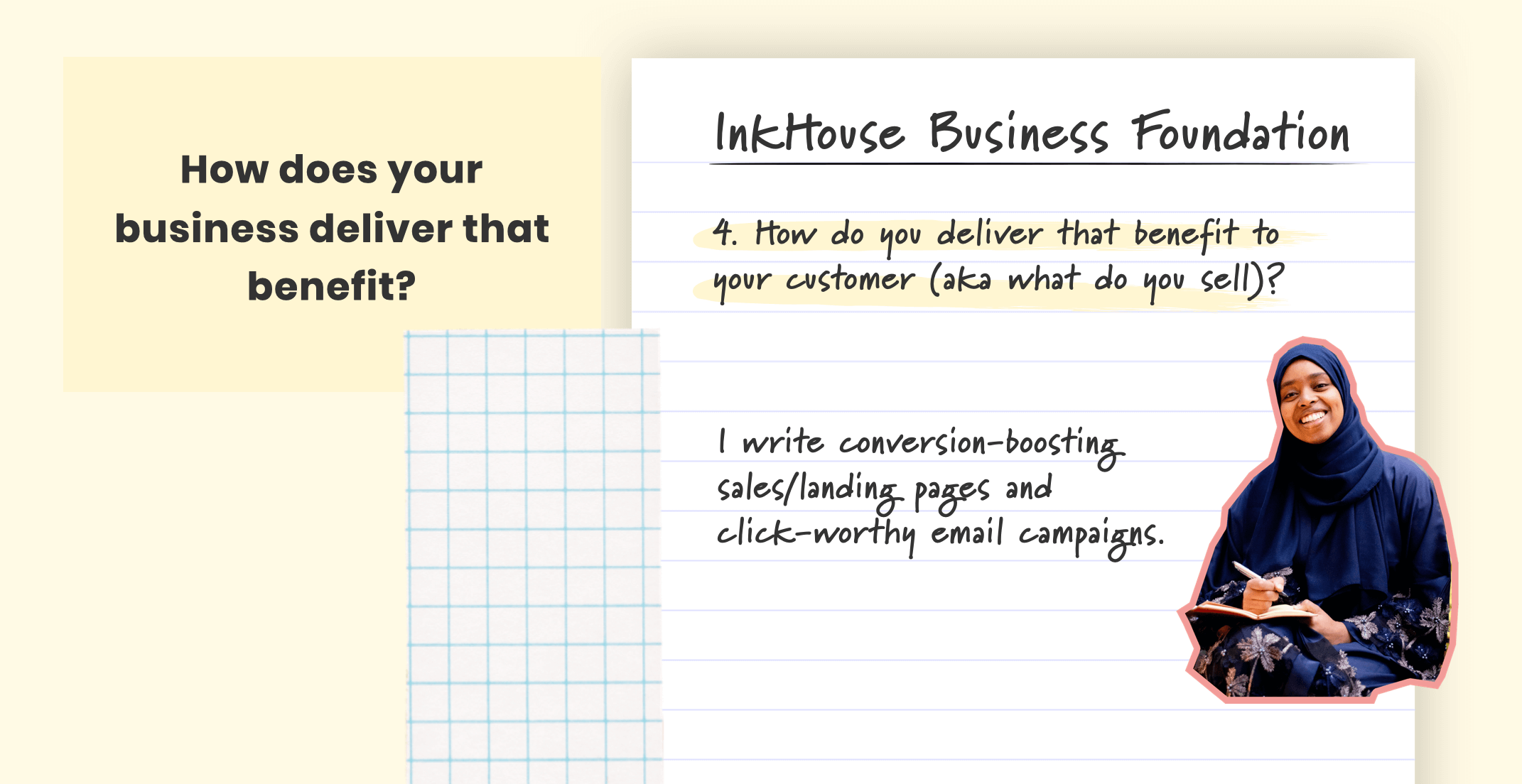
👥WHO: Eman’s audience is going to be online course creators.
🧭WHY: Her mission is to amplify the impact of passionate course creators.
⚡️WHAT: Her benefit is to increase audience engagement and boost course sales.
📝HOW: Her offering is copywriting services in the form of sales page copy and sales email campaign copy.
These four questions now clearly define Eman’s business foundation, and they give her some clear messaging points to move forward with. We can use this information to go through the next four steps on our 5-step checklist!
⚡️ ACTION STEP FOR YOU ⚡️ Answer the Who, Why, What, and How questions for your own business. Keep these answers in a Google Doc, Note, or PDF you can reference often. You’ll want to have them handy as we move forward in our 5-step process.


The product or service you sell is your castle. And this castle of yours sits on an island in the middle of the ocean. As much as you may want to tell people your castle exists, your product or service offering must be in tip-top shape before you start leading people to it.
Your castle is your “how” from Step 1. It’s the thing you do that people can pay you for. This will most likely be a Services page for all you client-based biz owners reading this.
On Eman’s website, we ventured to her Services page and were quickly met with a dropdown full of options (six of them, in fact). Now, there’s nothing inherently wrong with having multiple service offerings and Eman may be able to offer all these services, but when you have too many options your potential customer will have analysis paralysis.

With the shift Eman is making in her offering to help online course creators write better sales pages and email sales campaigns to sell their courses, there is no reason she needs all these options. Additionally, we recommend having ONE singular overview page of your services so a potential client can quickly understand what you offer at a glance.
🔥 HOT TIP 🔥 Dropdown menus in navigation aren’t the friendliest experience on mobile. Your website is likely to get 50% of its traffic from a mobile device which is also why we highly recommend a single Services page.
Our recommendation for Eman is to create three simple copywriting packages for online course creators. These packages are closely related and could be a natural upsell between them (which is awesome!)
The three new offering packages we came up with are as follows:
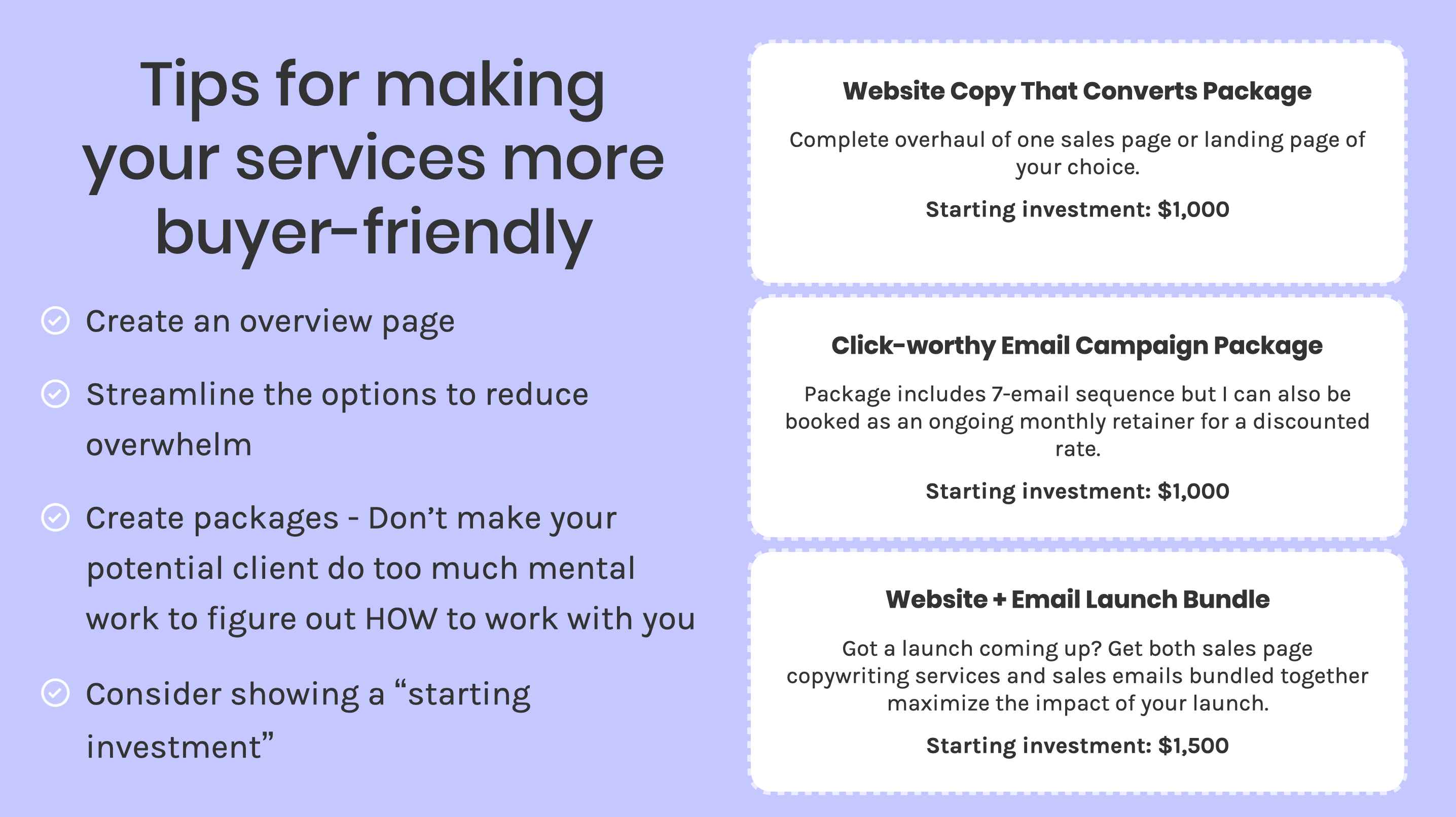
One additional tip after streamlining the offerings is to use a phrase like “Starting Investment…” listed next to the packages. This starting price will help weed out the customers who can’t afford to work with you (or Eman in this case!).
Eman’s previous way of landing clients included a “Discovery Call.” We are all for this strategy and we’ll talk more about this marketing bridge in a moment. But, if she were to put herself in her customer’s shoes she might find that a discovery call is a big commitment that someone may not be ready to make, even if they are interested in working with her.
We see this often on people’s websites where the buying process has a point of friction that is slowing down the flow of new inquiries.
Our recommendation is to add a simple contact form to the bottom of the Services page. If people aren’t ready to hop on a discovery call but might have a question they need answered before becoming a customer, this makes that process easy for THEM.
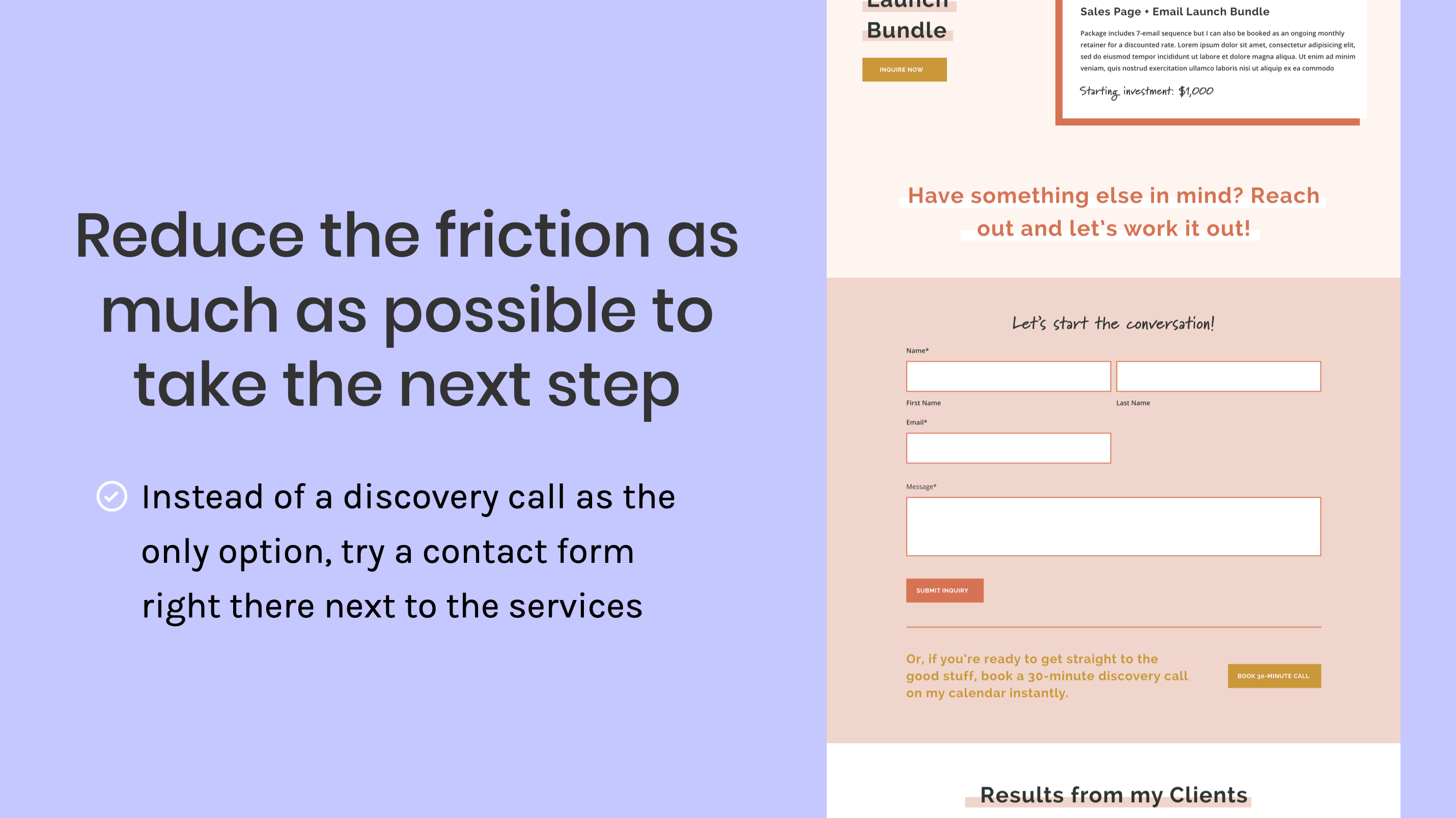
Streamline your offering(s) as much as you possibly can. Consider creating one Services page and put yourself in the shoes of your customer. Is their ability to start working with you frictionless? Could you give them an option to contact you if they’re not quite ready to buy (or just have questions)?
Make sure your offering is clear, focuses on the specific needs of your ideal customer, and doesn’t require too much effort on their part to make a decision.
⚡️ ACTION STEP FOR YOU ⚡️ Take a look at your current Services (or Products) page/pages. Do you currently have too many options that might be causing analysis paralysis? Simplify your offerings into ONE page and make them extremely specific for your ideal customer’s problems.

There’s a crucial mistake we’ve made many times in business, and it’s one we see people making all the time: We spend 95% of our time creating our offering (or doing our work) and then 5% of the time promoting our offering.
Unfortunately, this is why so many client-based business owners have trouble getting consistent clients. All their time is spent doing the work, and not enough time is spent creating what we call “marketing bridges.”
Marketing bridges are what allow people from the Mainland (aka where everyone is hanging out online: social media, searching Google, reading blogs, listening to podcasts, etc) to discover your business and usher them over to your castle (to pay you!)
We can best sum this up in this fun little GIF:

We want to give Eman a LOT of credit here! Most people don’t have a solid marketing bridge in place. After a quick peruse of her website, we discovered Eman’s method of converting strangers to customers was already in place 👏👏👏 (yay Eman!)
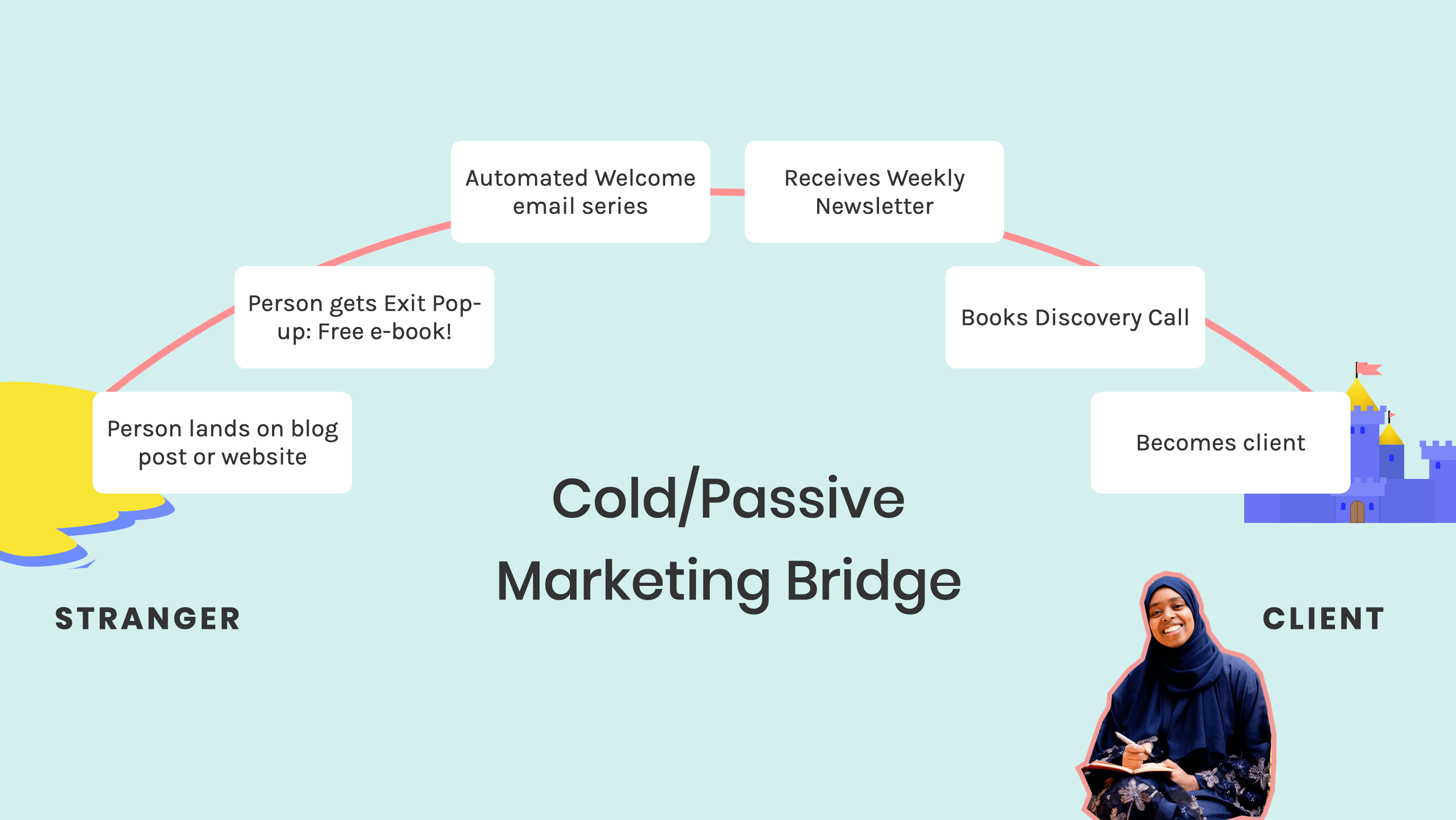
WHAT’S GREAT: We call this the “lead magnet marketing bridge” and when done right (you GIVE a ton of value in the lead magnet itself) you can build trust and authority with your potential customer.
IMPROVEMENT: Ensure your lead magnet is speaking to your ideal customer and can help them immediately. Also, if you can create custom-tailored lead magnets on different parts of your site, that’s a bonus! (Example: creating a specific lead magnet related to a specific article.)
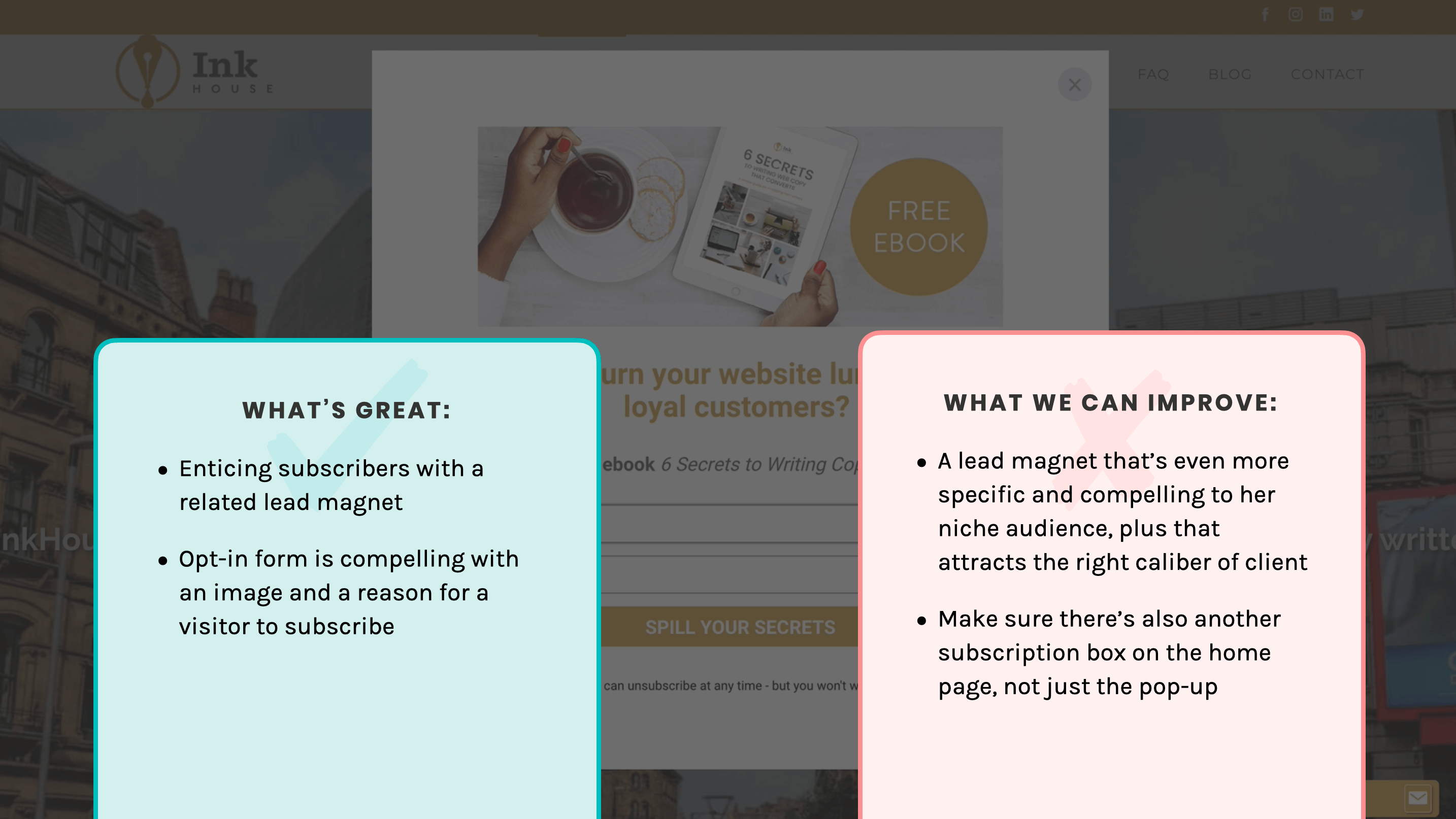
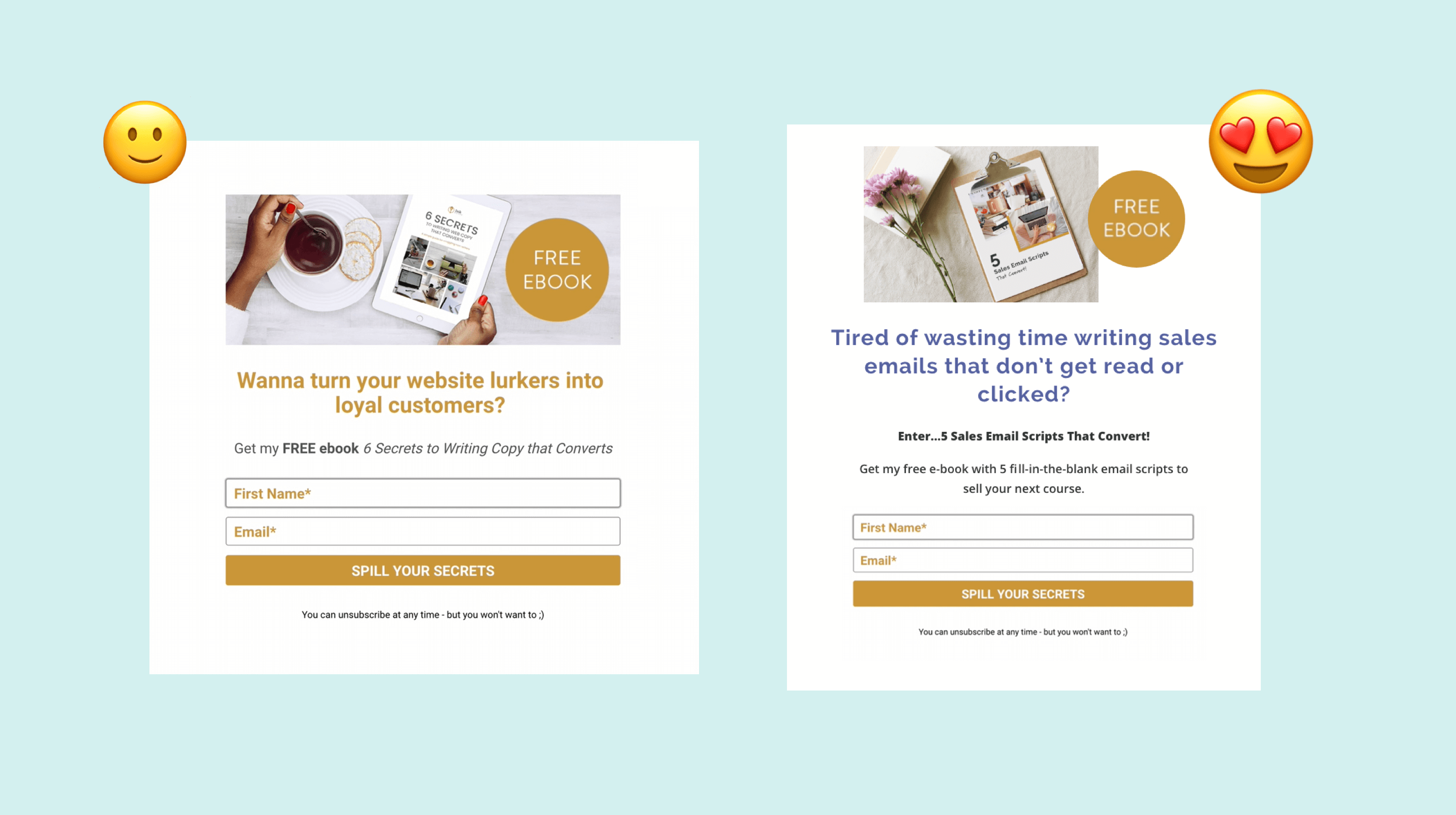
Additional note about lead magnets and email signup forms: Please please please don’t only use pop-ups on your site. If a website visitor uses a pop-up blocker or closes the pop-up quickly and you don’t have a lead magnet (or email signup form) embedded on your website somewhere else, they may never find your marketing bridge!
Having one good marketing bridge, especially for your more cold/passive potential customers is important. But there’s no reason not to try multiple marketing bridges and see which one converts the highest.
We put our heads together and whipped up a second marketing bridge idea for Eman. The idea behind the second marketing bridge is to target online course creators who know they lack clarity in communicating about their course but aren’t quite ready to take that step to book a discovery call. They want to see the value of good copywriting demonstrated. They want to “try before they buy!”
Instead of making the main call to action on her home page to book a discovery call, we developed a compelling low-investment (on Eman’s time) but high-value offer. A potential client would fill out a short survey to submit and Eman would email them with their free “Elevator Course Pitch” and try to then get them booked on a discovery call. This marketing bridge will put Eman in the driver’s seat to directly show her skillset by replying to each person that submits this short survey.
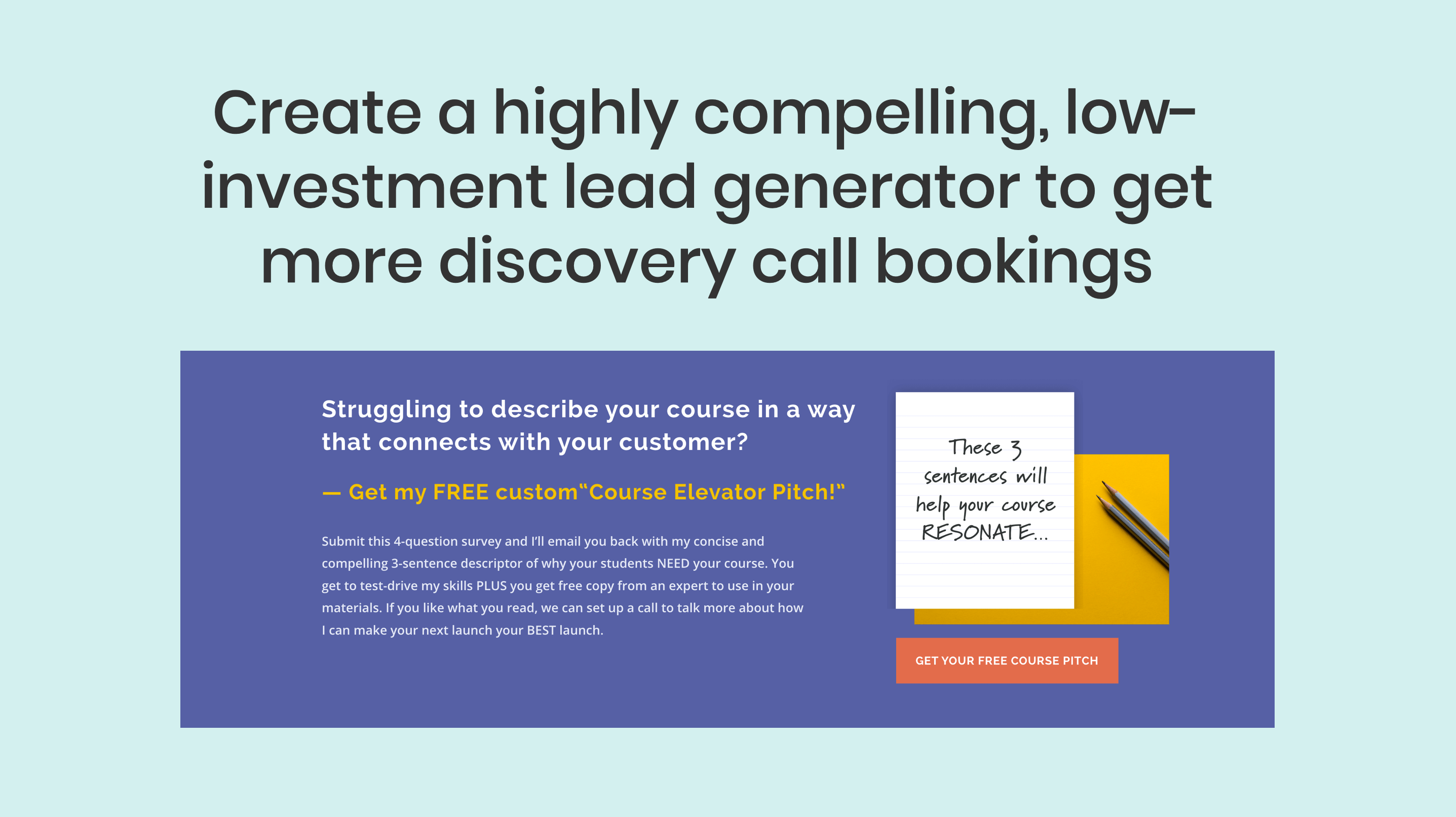
🔥 HOT TIP 🔥 Too often, client-based biz owners want to create a “set it and forget it” marketing bridge only to realize they’d land WAY MORE clients if they used a more high-touch bridge. If you aren’t getting clients right now, give a more direct connection as a marketing bridge a try and see how it goes.
First of all, you MUST have a marketing bridge of some type in place. We have 13 marketing bridge examples we wrote out for you if you don’t know where to start.
To make the most of your marketing bridges and have a high-converting customer journey from the Mainland to your castle:
⚡️ ACTION STEP FOR YOU ⚡️ If you don’t have a marketing bridge in place at all right now, you need one. If you currently have a marketing bridge but it isn’t helping get you more clients/customers, consider trying a new marketing bridge (maybe even a high-touch one!)

When it comes to getting more paying clients, they aren’t going to appear out of nowhere AND not every person that visits your website is going to pay you money right away. This probably isn’t breaking news to you.
We believe in a 3-pronged approach to building an audience, and it comes in the form of a salad metaphor. (Yep, salads. We keep it weird around here!)
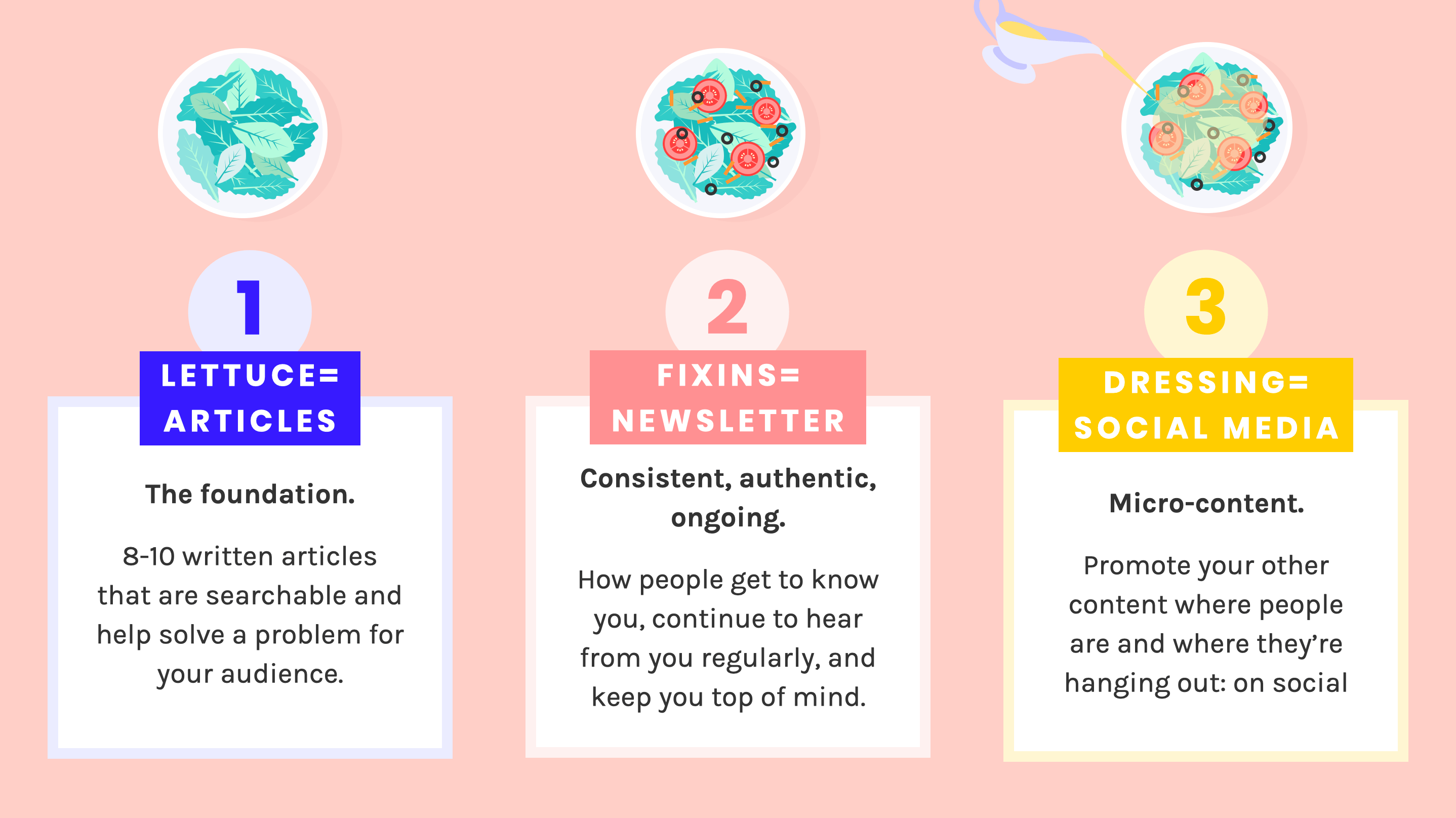
The great thing about Eman, she was already using our 3-pronged salad metaphor!
As her Brand Foundation focus changes to helping online course creators with sales copywriting, she’s going to need to adjust the first part of her salad.
It was great to find that Eman had written some solid articles. Her speaking voice comes through in her writing and she definitely knows her stuff. But, as she makes the pivot to focus on helping online course creators, we know she has some work ahead of her to optimize existing articles.
We took a look at a couple of article headlines on her blog and rewrote them to be A) more search-friendly and B) more laser-focused to online course creators.
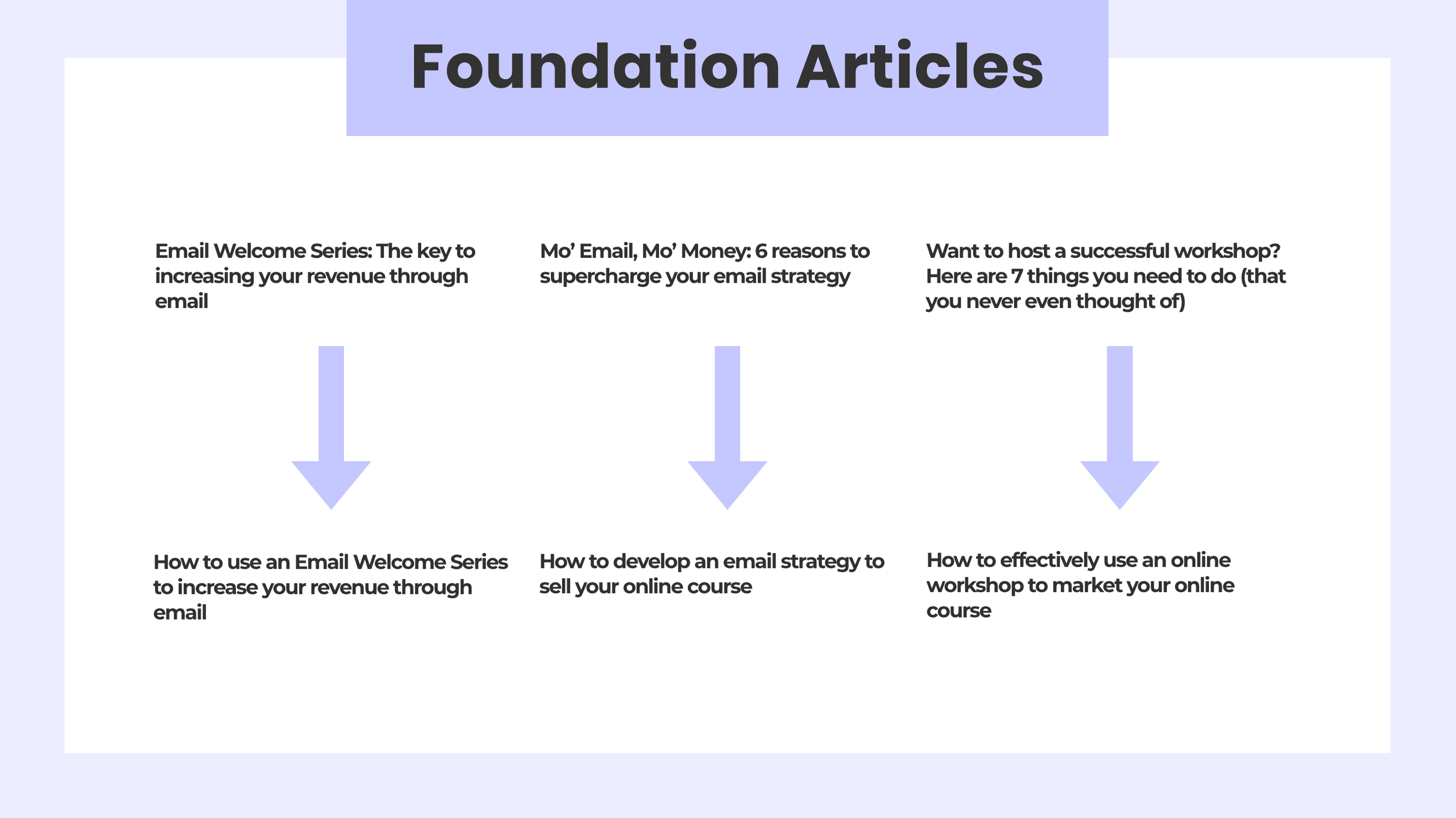
🔥 HOT TIP 🔥 Foundation articles are NOT etched onto stone tablets. You should check-in on your articles every 6 months and see if there’s room to improve or optimize them.
For copywriters like Eman, this is a no-brainer and a must-do. Good thing for us, Eman was already on top of this task too! She forwarded us a bunch of her automated emails and some of her newsletter examples.
However, if you’re not a copywriter, we still believe having a consistent email newsletter is a must-have to grow an audience.
WHAT’S GREAT: Eman already had an automated series of emails that get sent out after someone downloads her lead magnet. She also writes consistently every week to her subscribers. A+++ Eman!
IMPROVEMENT: Shifting the audience to be THE go-to newsletter for online course creators who want tips to communicate their offers better will greatly help her convert subscribers to customers. The more specific the email content, the better!
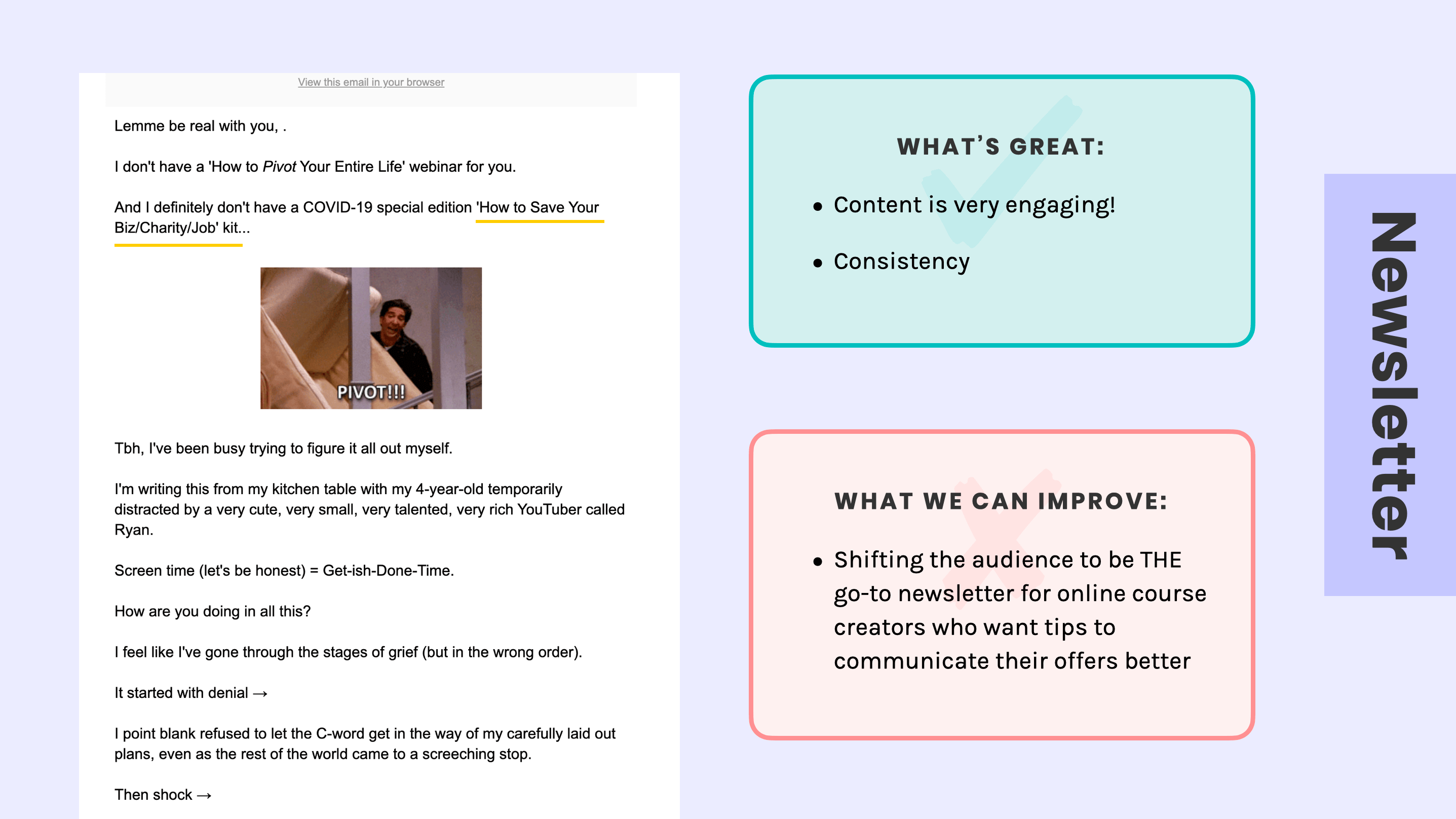
Social media is a giant topic and the advice we’d give varies on the channel, but we primarily focus our efforts on Instagram. Since Eman was on Instagram, we took a look at her feed and found some immediate things she could improve.
WHAT’S GREAT: She’s sharing micro-content to point back to her other articles, e-book, etc and she’s posting consistently.
IMPROVEMENT: Making sure each post delivers value in the app, not just promoting something else. Creating brand consistency would help her posts stand out in people’s feeds and build recognizability.
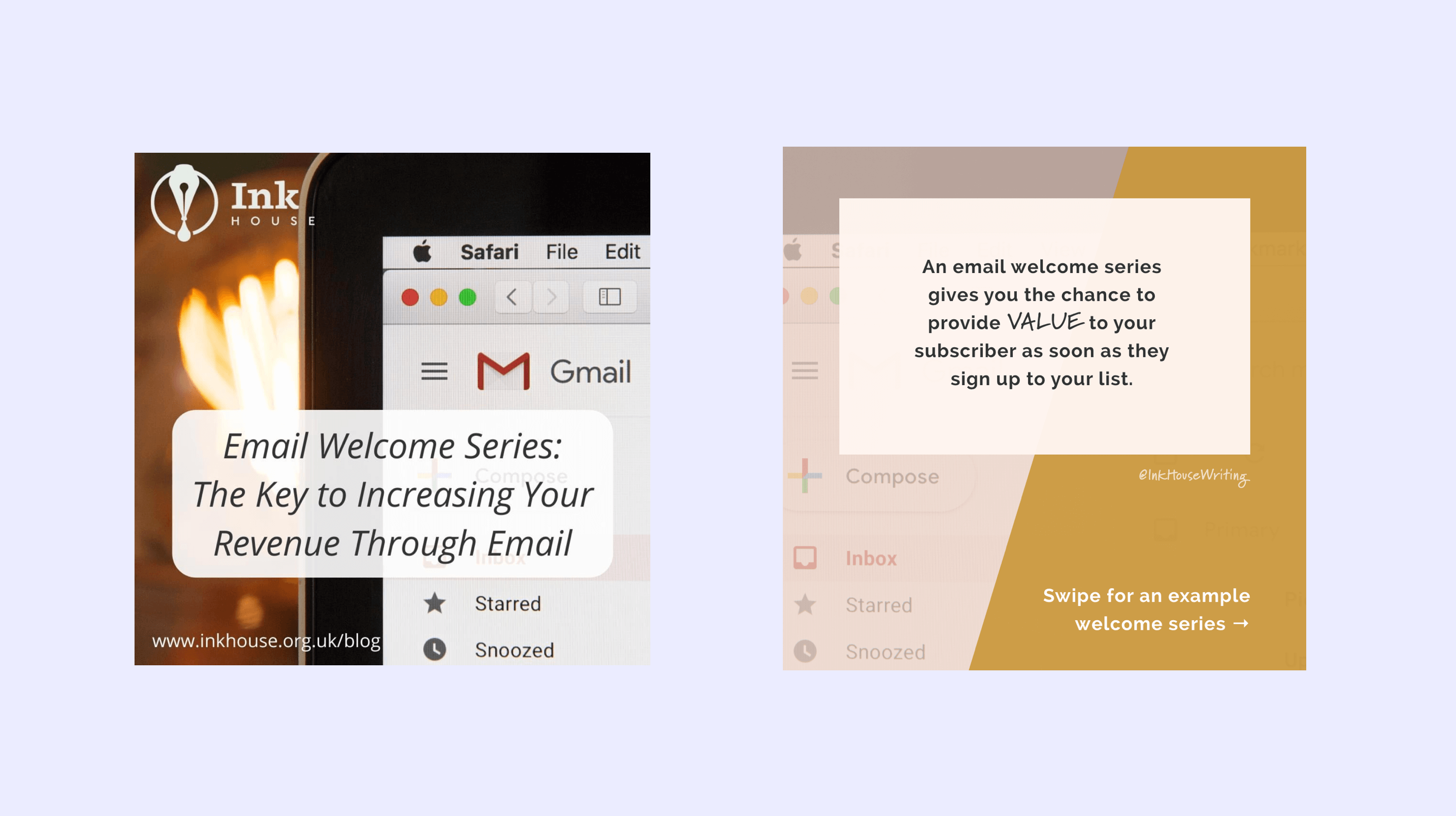
🔥 HOT TIP 🔥 Especially on Instagram, don’t simply create a post with the title of an article you recently wrote. Pluck out ONE AMAZING NUGGET that could help someone if they saw that post in their feed. Then, write in the caption that they can read more at the full post (#linkinbio).
Think of building an audience like building a (delicious… if that’s possible) salad. The key to constructing a salad you actually want to eat and an audience that actually grows is assembling things in the right order.
⚡️ ACTION STEP FOR YOU ⚡️ Your audience is not going to build itself. Focus less on perfection and more on consistency. Make sure you have 8-10 foundational articles. Then start sending out a helpful weekly email newsletter. THEN, create a consistent promotion schedule on the social media platform that makes the most sense for you and your ideal customer.

When Eman submitted our initial Growing Through It survey she wrote something we hear often from online biz owners. We’re paraphrasing, but it goes something like this:
Raise your hand if you’ve been there? 🙋🏻♀️🙋🏻♂️
Eman’s website had a great foundation before she reached out to us. But after going through the previous four steps, there are now some immediate improvements we could help her make.
Right off the bat, within 30 seconds or less, your website’s home page needs to answer four simple questions your ideal customer is thinking. Yes, we’re going to help you (and Eman) read minds. 👉🔮🧠
The four questions your home page needs to answer right away:
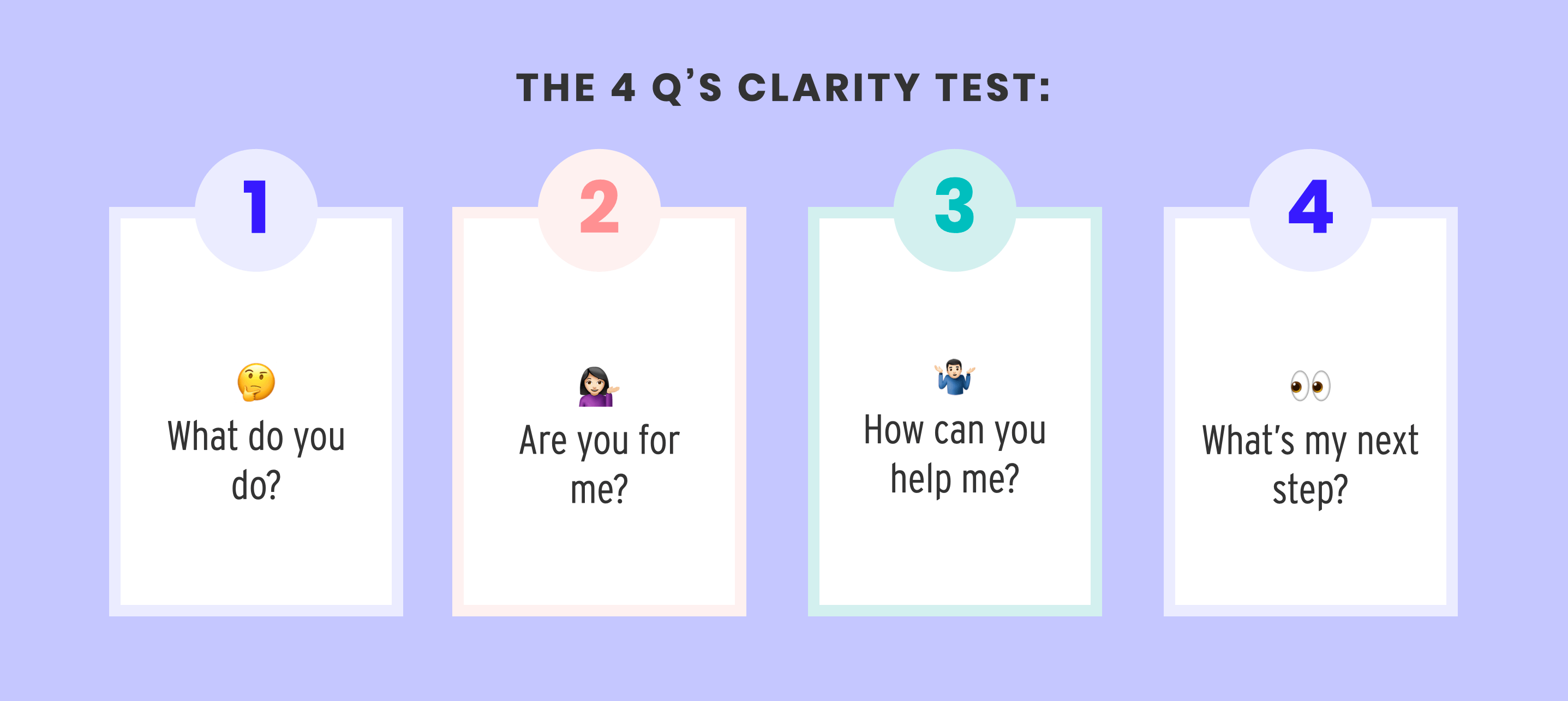
Now, how you go about answering those questions leads us into the second website evaluation exercise!
If you can’t tell, we love metaphors and acronyms around here. APSOSA stands for:
Eman’s current website was doing a good job of answering most of the 4Q’s, but we can lend a hand to make sure the messaging aligns with her new specific audience and really sells her copywriting services as the solution to their problem. Here’s the APSOSA Framework filled out for the new InkHouse home page:
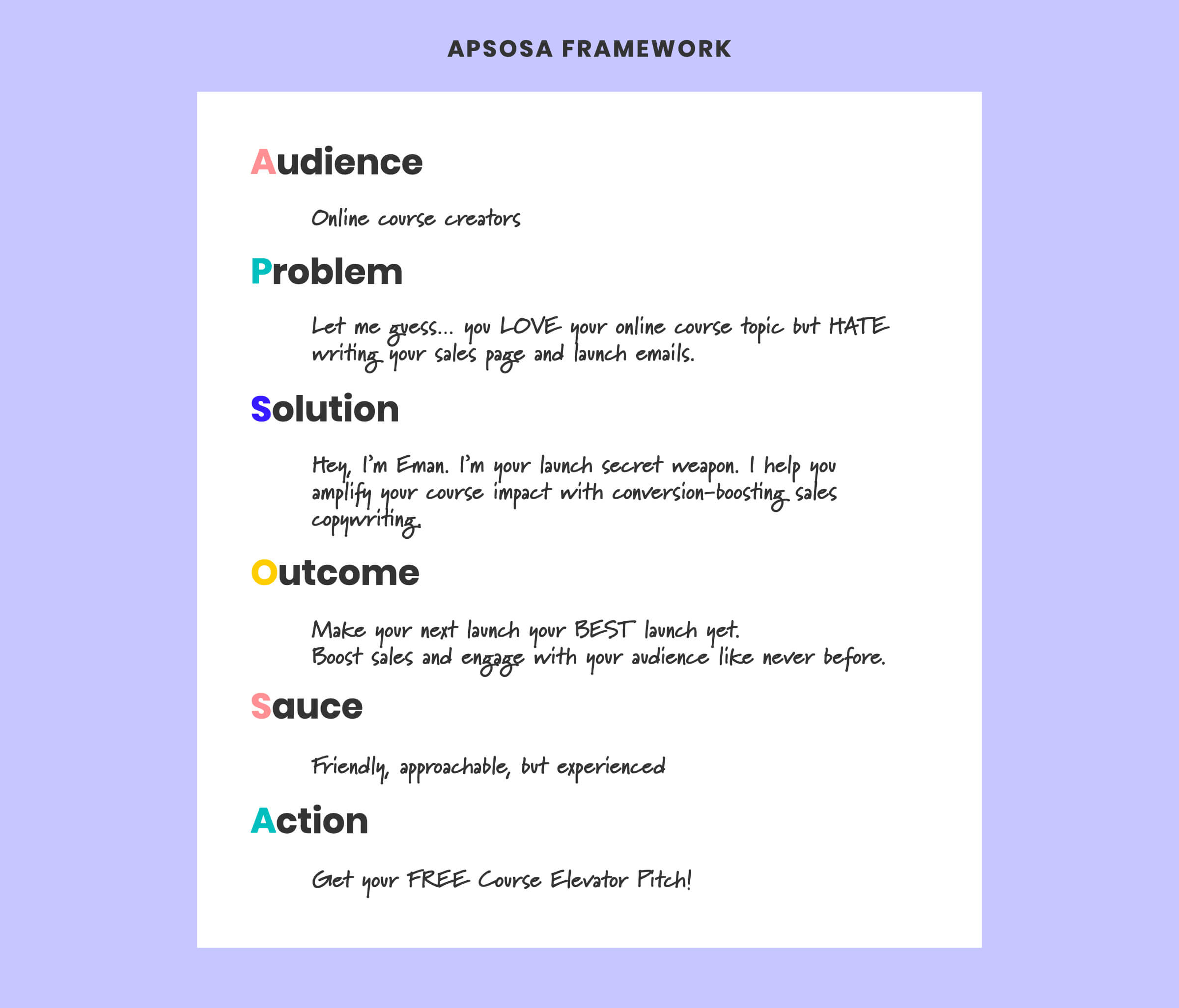
Writing out the “answers” to APSOSA helps with the four mind-reading questions. The next step is to take the APSOSA and 4Q’s answers and fit them into a journey a customer can take on a website’s home page. Things like bold headlines, section headers, callouts, etc, become the perfect places to use APSOSA answers!
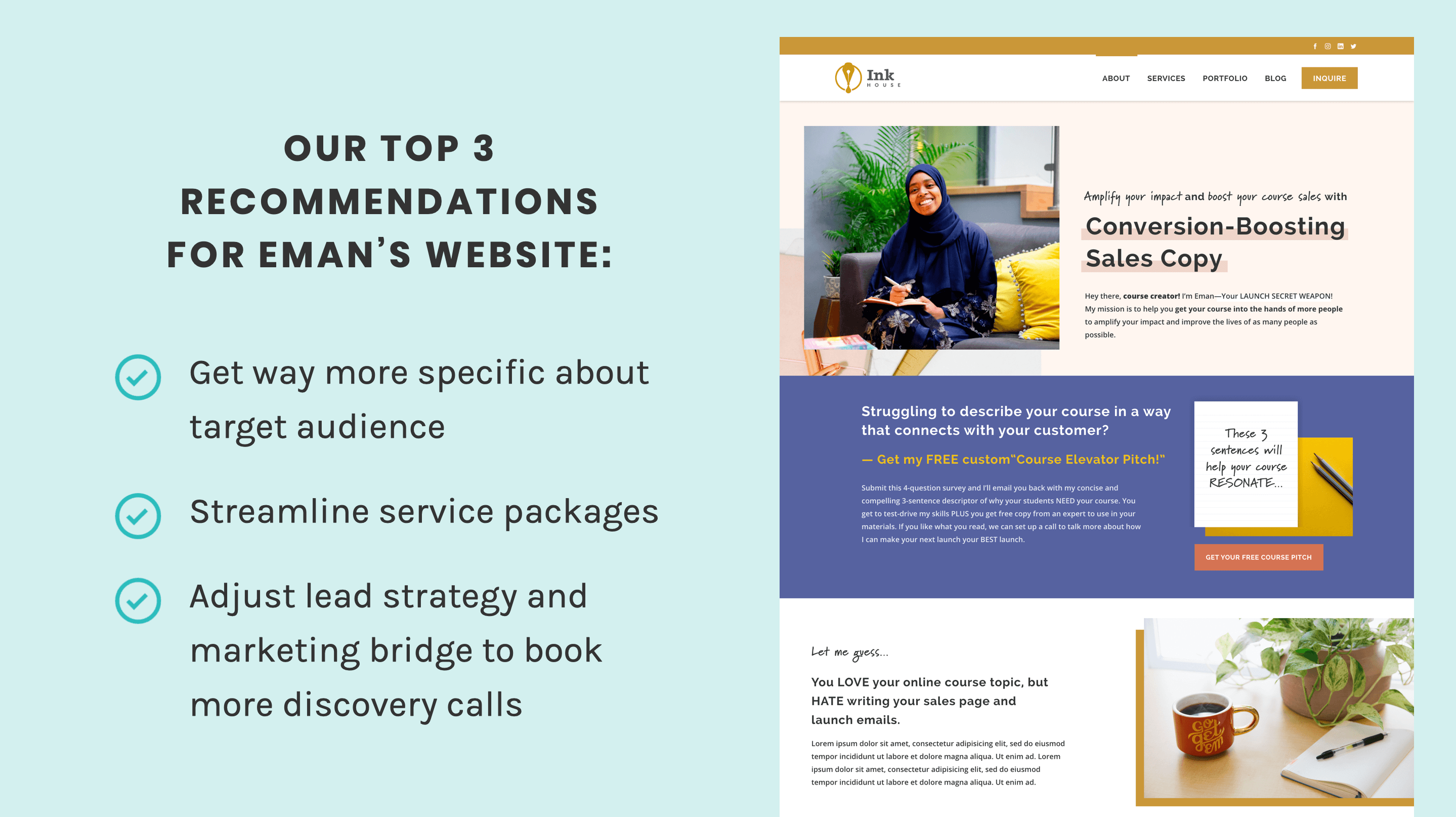
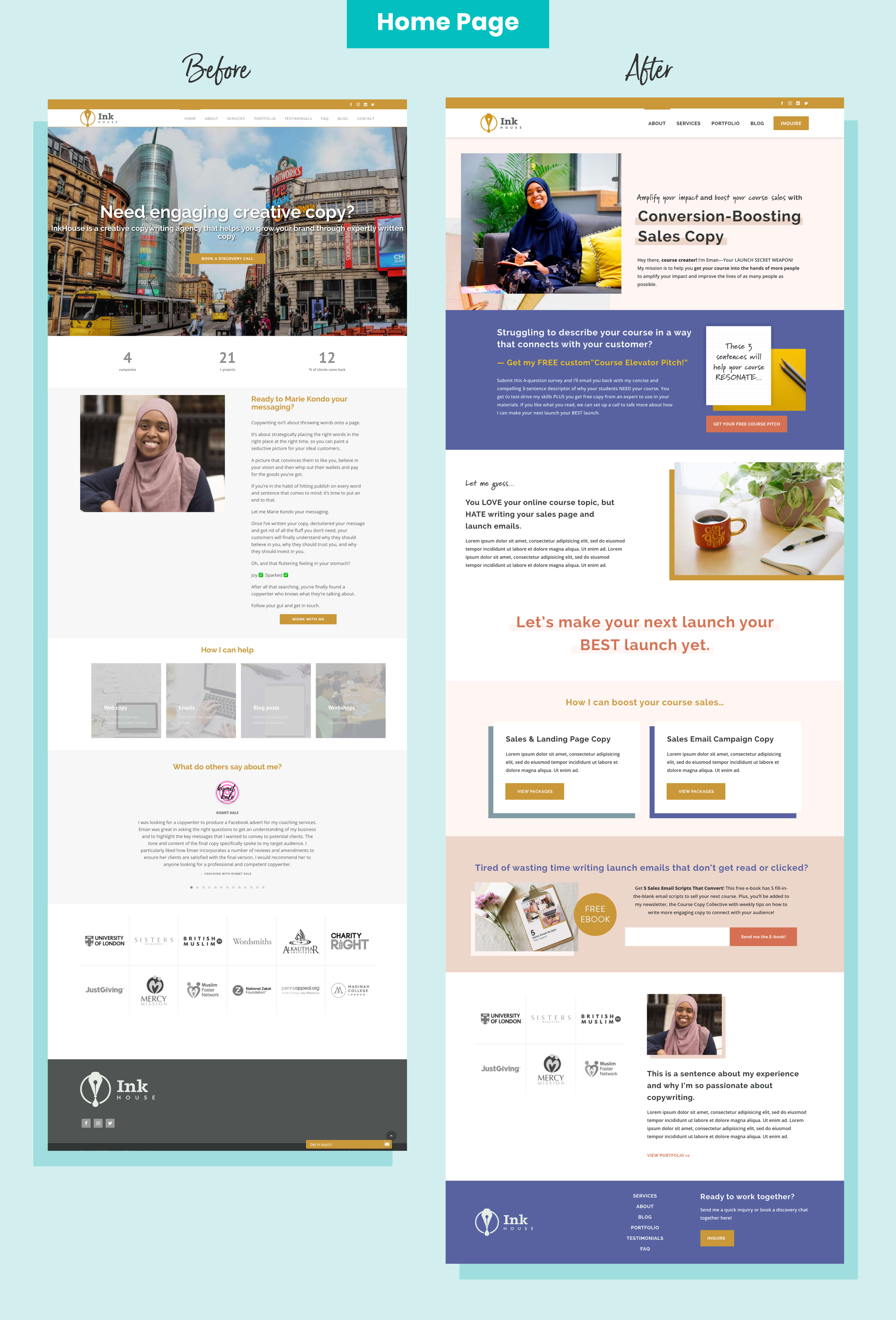
✋ HEADS UP ✋ We realize not everyone is a designer or has a solid grasp of web design. If that’s you and you know your website needs work, it’s absolutely worth the investment to pay a designer. Especially if you run an online business, your site needs to be a reflection of the amazing work you do!
As you can see, the new InkHouse homepage feels a lot more inviting. It feels more friendly and moves a visitors eye down the page rather than needing to read long bits of copy. It aligns more with Eman’s super-fun copywriting style and her personality.
We also took some of the work in the 4Q’s and APSOSA to add a big bold headline, section headers, and organize the elements that matter on her home page in an order that leads the potential customer through a journey to hire Eman.
We took her new offerings, put them all in one place, added the simple contact form we mentioned earlier, and grabbed a few helpful social proof items (since those are great on Services/Sales pages).
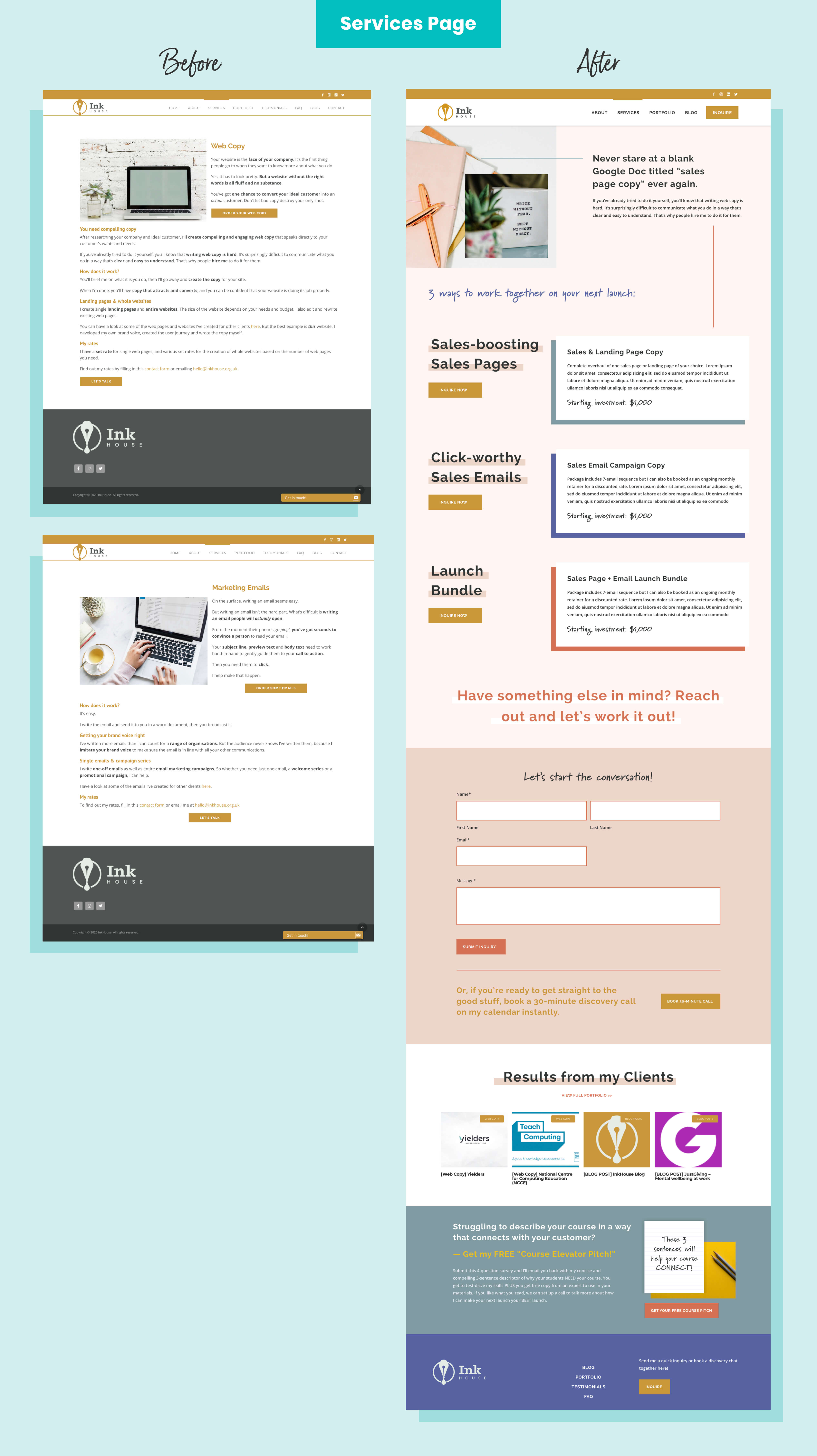
While design and branding are an important part of the website evaluation process, if you aren’t answering questions your ideal audience is thinking, you’re going to have a beautiful website that does nothing for you.
Our goal for Eman (and for you!) is to feel like her website is now working on her behalf! That the copy, images, calls to action, etc, are setting her up for success in the future.
⚡️ ACTION STEP FOR YOU ⚡️ Go through our 4Q’s Clarity Test and APSOSA Framework for your home page right now! Do you pass the 4Q’s test? Does your home page hit on all aspects of APSOSA?

We made it to the finish line, friends! And while we know this case study touched on a ton of elements of Eman’s business (and hopefully yours), it’s just one piece of the bigger online business puzzle.
👉 Eman still has to deliver on her offering.
👉 She still has to show up for her clients and help them reach the outcomes she’s promising them.
👉 She still has to continue to tweak and test various parts of her marketing and content strategy along the way.
🎉 But she GETS to do all of these things!
Running your own business gives you a ton of freedom but it can also be incredibly overwhelming.
Ready to make a few changes in your business? Go get after it, friend!
In this article, we’re going to go in-depth on these five important aspects of online business. There are certainly many more we could cover, but these five are the critical foundation pieces you need to have in place:
Great! Those are the five things we’re going to cover. However, before we move forward, this article comes with a B.F.C. (Big Fat Caveat)…
👋 Creating a successful online business doesn’t happen overnight after reading one article. You have to be willing to experiment, go through trial and error, and know that it takes time for your efforts to pay off.
(Anyone who is telling you they can help you “make 6-figs in your business in the next 14 days” is simply trying to sell you a load of hot-trash. Probably pricey hot-trash. Don’t buy expensive hot-trash, okay?)
Our goal with this article is to help you feel empowered with your business. We want you to feel less confusion and more clarity around exactly what you do, who you do it for, how you make money, and how you continue to grow a thriving business you enjoy.
Just to give you a bit more context, we’re a husband and wife team 👩🏻🦰👨🏻🦲 who have created multiple types of online businesses:
We share that information with you so you know we aren’t regurgitating someone else’s knowledge in this article. The information you’ll read below is from our own learned experiences, hard work, mistakes, and successes along the way.
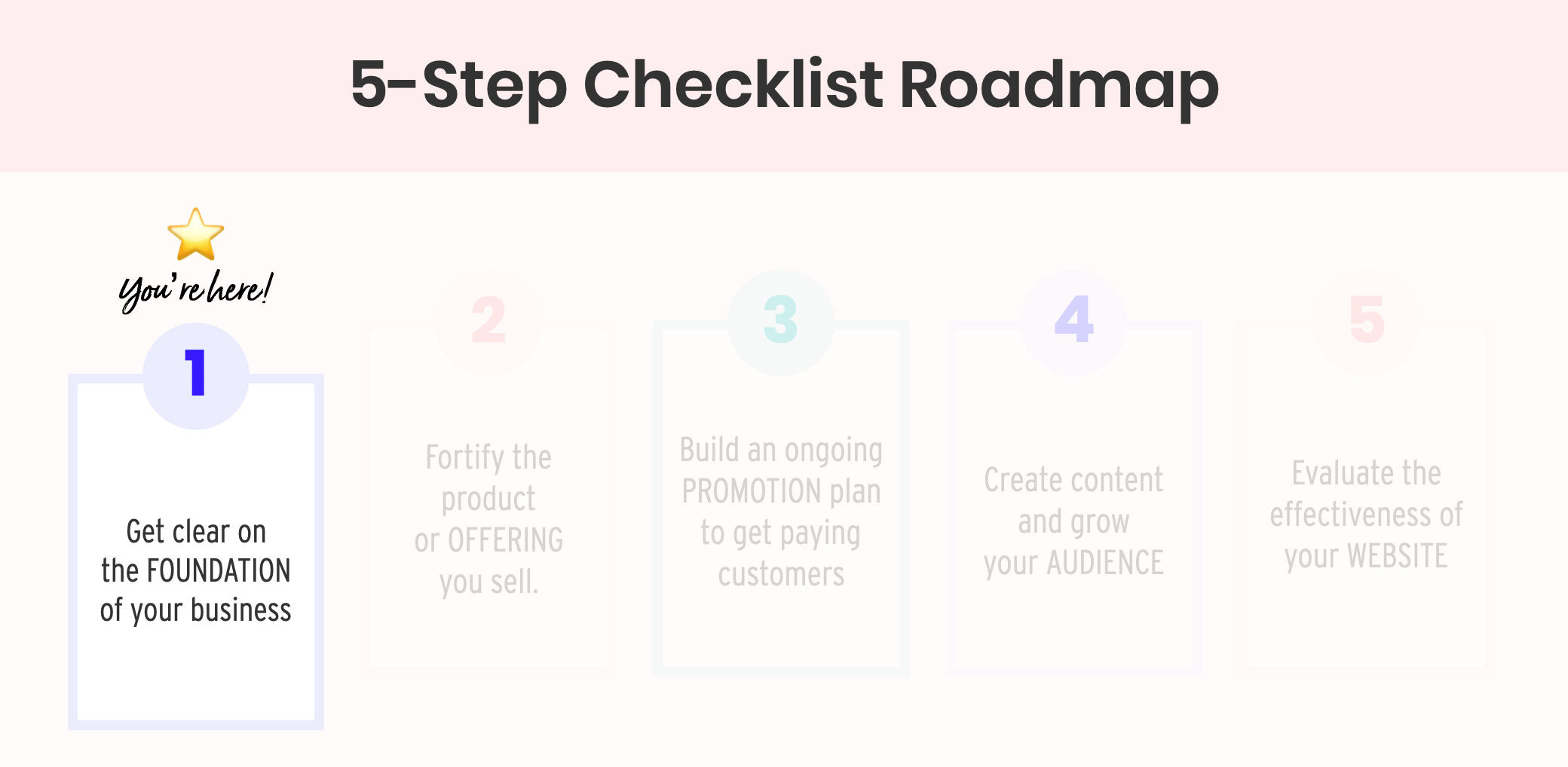
We’ve all been guilty of starting a business and diving straight into the deep end. We have a good idea, we see a need in the market, or we just want to dabble in a side project. Before we know it, we have a domain, a website, a logo, a product or service, a paying customer or two, and then we feel overwhelmed by our daily to-dos.
Most online business owners (us, included) rarely take the time to create a SOLID business foundation. We’re going to help you do that here in Step #1 with an exercise we like to call:
“If you’re trying to make something for everyone, you end up making something for no one.”
“If you’re trying to make something for everyone, you end up making something for no one.”
Variations of that quote get passed around a ton in the online biz world because it’s true. The more generic and broad your audience is, the harder it is to attract your ideal customer and prove to them you and your business are the right fit for them.
Let’s look at a BAD and GOOD example of answering the WHO question with a business “tagline”:
BAD TAGLINE – I design websites for businesses.
BETTER TAGLINE – I design websites for wellness businesses.
GREAT TAGLINE – I help yoga instructors by building beautiful websites that get them more paying customers.
The difference between the bad and good should be clear. Many online business owners don’t want to limit themselves to a smaller group of people (customers). But limitations when it comes to WHO you help are critically important.
Put yourself in the shoes (or yoga pants) of a yoga instructor who needs a new website for his/her business. Which “tagline” speaks more directly to you and your needs? Which of those taglines will make you go “oh man, that person is talking to me!”
⚡️ACTION STEP ⚡️ Answer the WHO question by writing your own business “tagline” using the formula of: I help <specific customer type> <your product or service> that get them <benefit of your product or service>.
This is your mission statement. It’s an often glossed-over part of running an online business because you can get going so quickly that you pass right by it.
This is the deeper reason why you do what you do and why your business exists in the first place.
Let’s look at a BAD and GOOD example of answering the WHY question:
BAD MISSION STATEMENT – I’m a web designer who likes designing Squarespace websites.
GOOD MISSION STATEMENT – I have experienced the healing power of yoga first-hand, which is why it’s my mission to help yoga instructors create thriving wellness businesses so more people can benefit from this transformative practice.
I don’t know about you, but I’m pumped to start my own design business that helps yoga instructors just after reading that GOOD mission statement. Pro-tip: A mission statement at the top of your business’s About Page is a great way to let your prospective customers know you’re the right fit for them.
⚡️ACTION STEP ⚡️ Answer the WHY question by writing your own mission statement: My mission is to help <specific customer type> <outcome you want for them> because <reason this personally motivates you>.
We’ve touched on this slightly already with the WHO and the WHY, but let’s make sure you’re crystal clear with your WHAT. It’s not enough to simply say, “I create beautiful websites” (for our ongoing example). You need to speak to the outcomes your customer wants for their own life and business. How will your business make their life better?
Let’s look at a BAD and GOOD example of answering the WHAT question with a benefit statement:
BAD BENEFIT STATEMENT – I’m a web designer who creates Squarespace sites for yoga instructors.
GOOD BENEFIT STATEMENT – By creating a beautiful and easy to navigate website, I help yoga instructors get more paying customers and create a stronger connection with their audience of students.
The key difference here is looking at your business from the perspective of your customer. Which person do you think a yoga instructor more wants to hire and give money to? The first example (BAD) or the second (GOOD) which speaks clearly to the outcome a yoga instructor wants?
⚡️ACTION STEP ⚡️ Answer the WHAT question by writing your benefit statement: By <specific thing you do>, I help <specific customer type> get <outcome(s) your business helps them achieve>.
Now, we’re going to go way deeper on your specific product or service later on in Step #2, but for gaining more clarity and strengthening your business’s foundation, let’s make sure you can concisely explain your offering(s).
Let’s look at a BAD and GOOD example of answering the HOW question:
BAD OFFERING DESCRIPTION – Website design.
GOOD OFFERING DESCRIPTION – I build beautiful and simple Squarespace websites through 3 design package tiers: A simple 1-page website starting at $500; a 5-page website starting at $1,500; and a 10+-page website starting at $2,500.
The important thing to note here is just to get clear and specific on what someone can buy from you or how they can hire you AND make the options well-defined to do so. Note: If you have a hard time being concise here, maybe that’s an indication that your customers are having a hard time understanding the complexity of what your business offers!
⚡️ACTION STEP ⚡️ Answer the HOW question by describing your offerings. There isn’t a specific formula to share here but try to be concise if you offer more than one package or option.
Alrighty, that’ll wrap up Step #1! Once you finish answering the 4Qs you can put them together in a nice recap image or PDF (if you’re feeling fancy, obviously).
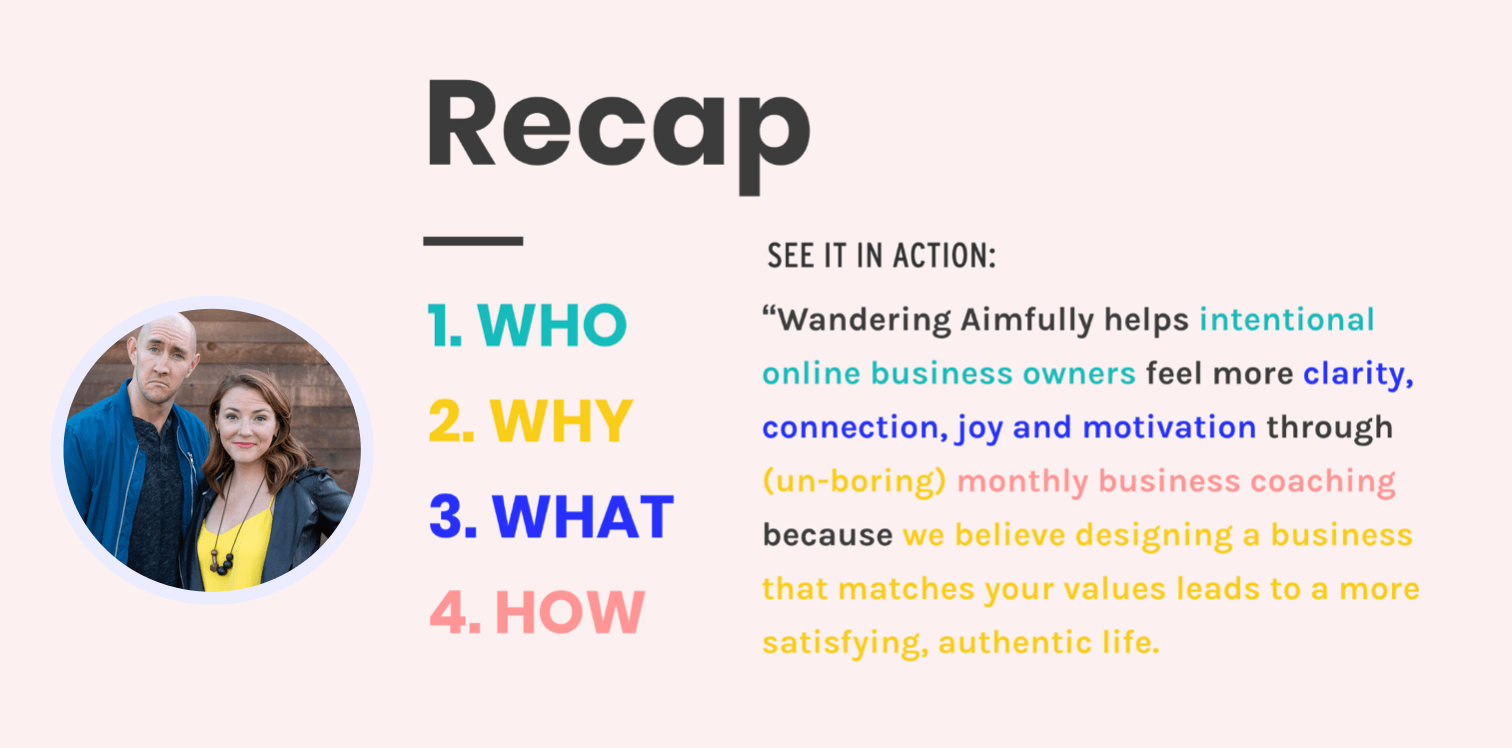
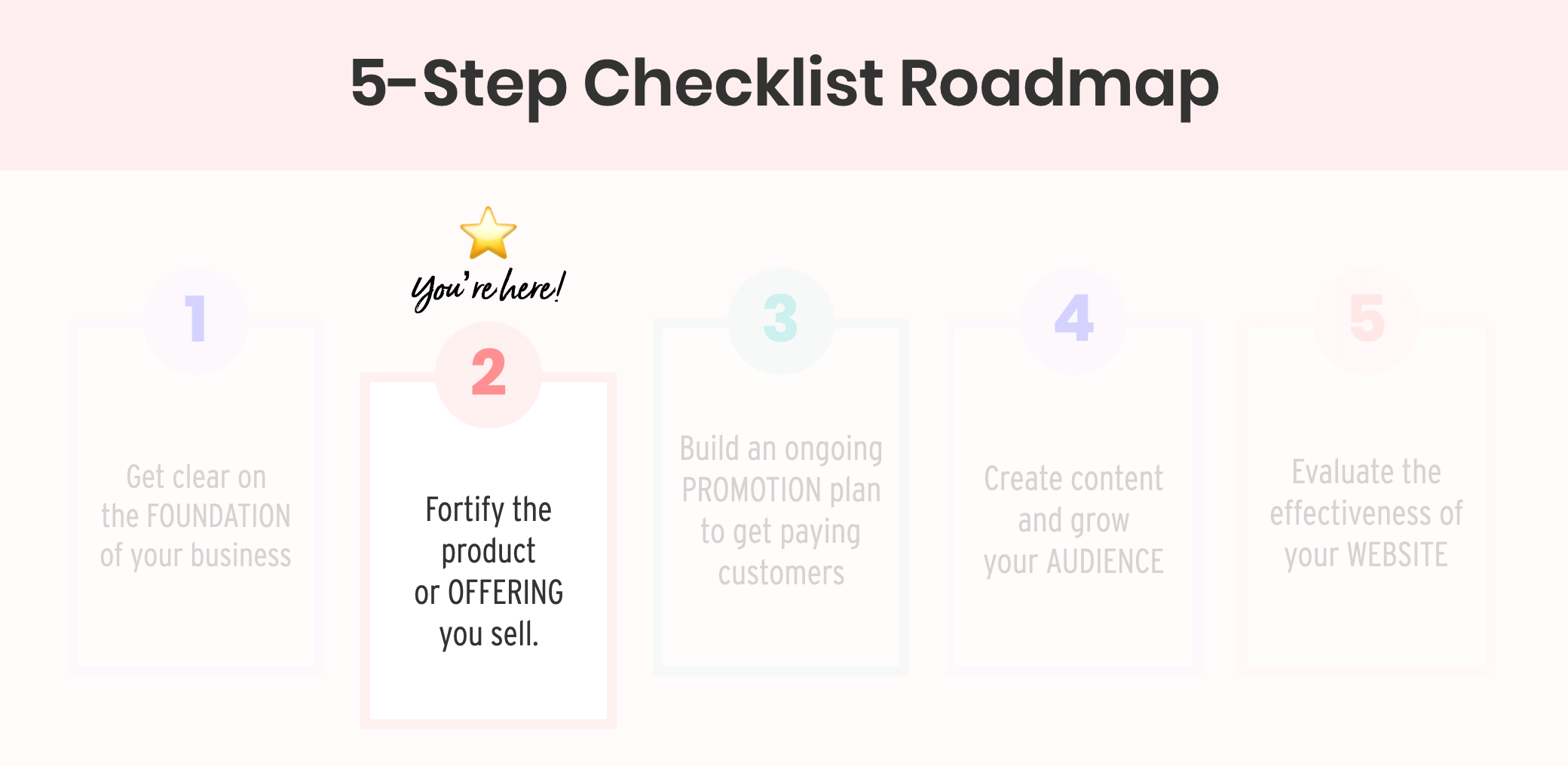
Next, we’re going to talk about your product or service offering. We like to refer to that thing you’re trying to sell as your “castle.” Think of your castle existing on an island floating out in the middle of the ocean. Your job is to get people over on the “mainland” to know your castle exists and show them how to find your castle (and pay you!)

You already defined what your offering is in the final Q of Step #1, so that should be clear as day. These next questions are really important to answer before you pour more effort into marketing and promoting what you sell:
Too often business owners create a services page or a sales page and because they’ve spent so much time working on it they don’t see the glaring issues with it. Once YOU feel your castle is in tip-top shape, it’s time to get a second opinion.
Put on your mental armor and lather up your thick skin (ew?), because the feedback you receive might sting a bit. That’s okay! You want people to point out any obvious issues with your services or sales page. You especially want this information before you invest valuable time and effort trying to get potential customers to buy from you.
🔥 HOT TIP 🔥 On average, 50% of your website traffic is going to come from a mobile device. Take a look at your services/sales page on a mobile device and ensure it’s in tip-top shape there too! It is easy to read? Is it formatted well? Is the mobile buying experience easy to use?

Think of the journey between the mainland and your castle like a broken bridge. If it’s not easy for someone to understand your services/sales page and to buy from you, you’re likely sending potential customers down a broken bridge to your castle!
Our vote, 99% of the time:
Why? You don’t want your potential customers to get fatigued as they click page after page around your site trying to find the service or product that fits their needs. You want to start by giving them a clear, concise overview of what you offer. THEN, if you need individual description pages to explain more about each option, you can do that, but at least you made the journey as easy as possible on your potential customer.
If you offer multiple packages or pricing options keep them together. We’ve all seen pricing boxes on websites and there’s a reason these are so common, they work!
*Additional note for the Purchase section: Whether you’re using multiple package boxes or not, don’t forget to remind someone why they are buying from you right next to the buy button. Reiterate the problem you are solving and the outcome you’ll deliver to your customer.
Here’s a video lesson taken from a program we include in our Un-Boring Group Coaching Program where we go further in-depth about creating a great sales/services page:
We would highly recommend building your services or sales page using the P.O.P.S.E.P. formula. As a reminder, we’ve sold many products and services over the years and made good money doing it. We have the experience and the data to back us up.
⚡️ACTION STEP ⚡️ Go through your current services/sales page and apply the P.O.P.S.E.P. formula to it. Make sure your packages or buying options are easy to understand. Then, share this page with colleagues for feedback (and test everything on mobile!)
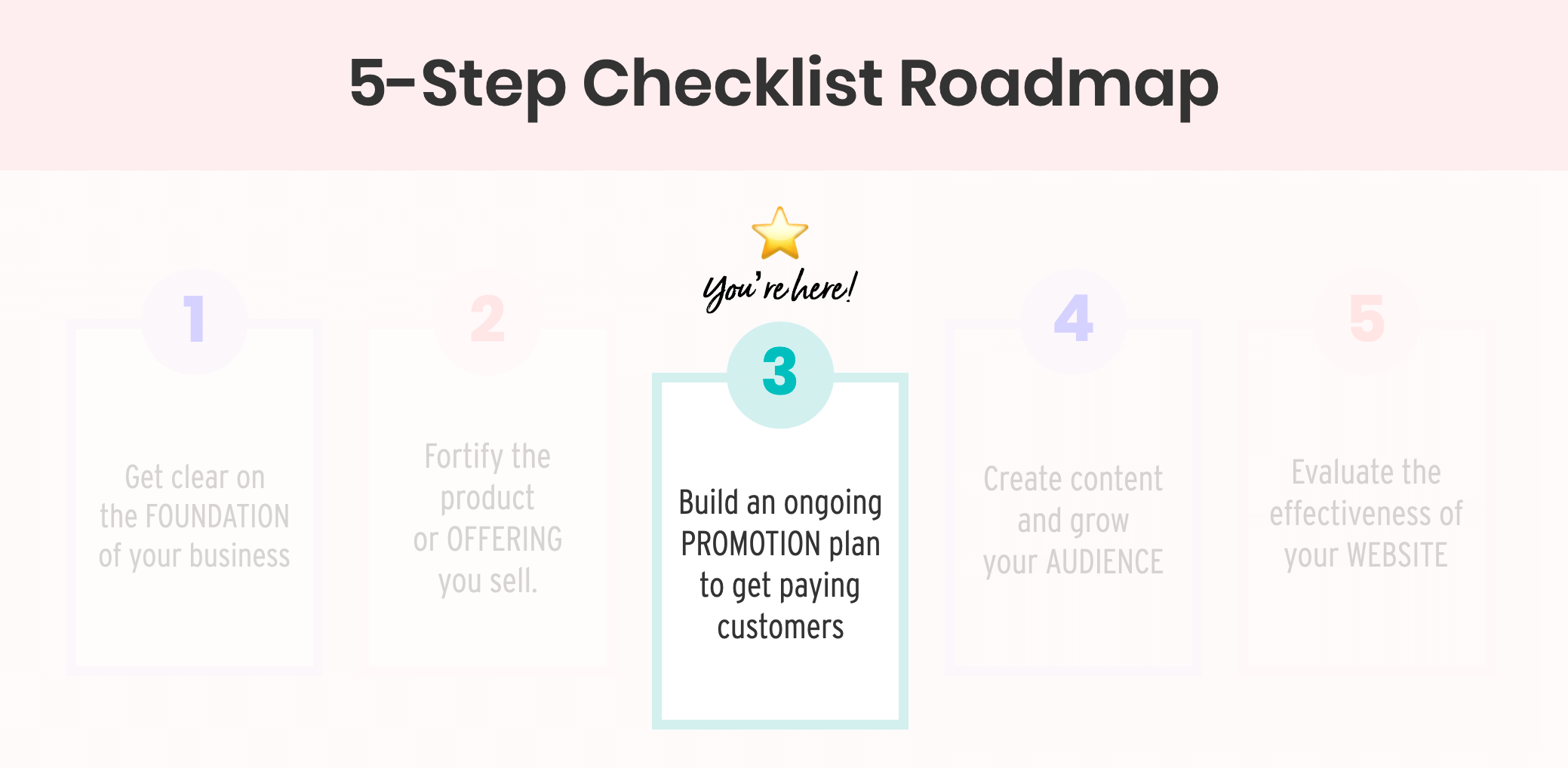
The foundation is set and your offering castle is now strong and just waiting for customers. But, how do they get to your castle? How does someone find out about your offering?
When it comes to promoting your online business, the strategy we often refer to is called “marketing bridges.”
What the heck is a “marketing bridge?” Simply put, a “marketing bridge” is what takes someone from a stranger to your business to a paying customer. It’s the journey they go on from discovering you exist to then paying you money. You have to build that bridge brick by brick to lead someone down the path to your castle.
Think of a marketing bridge as a journey to help guide your potential customer from the mainland to your castle. As much as we’d like to tell you that slapping a B.F.B.B. (Big Fat Buy Button) on your website’s homepage is enough, 99.9999% of the time it’s not.

A solid marketing bridge takes someone down a path:
🕵🏻♀️ FURTHER READING 🕵🏻♂️ For the sake of keeping this article from becoming as long as a Harry Potter book, we’re not going to go into great detail on all 13 of our marketing bridge examples here because we do that in this article right here!
We’ve compiled a list of 13 marketing bridges we’ve used over the years. There are likely many more to choose from but we’re sharing our specific marketing experiences. Feel free to click any of them to read more about each:
We DO want to touch on two different marketing bridges in this article, so let’s look at an example for a service-based/freelancer business (like a web designer) and digital product business (like an online course creator).
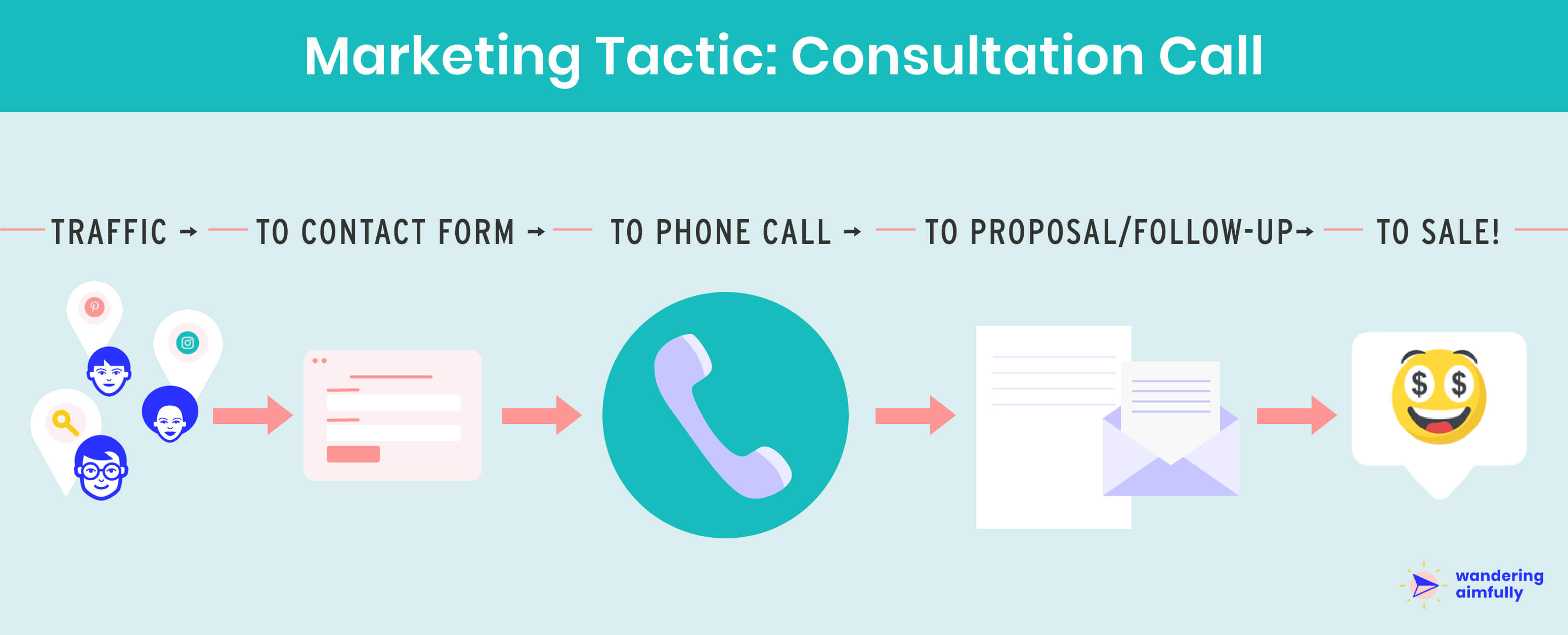
The concept: The “Consultation” marketing bridge is almost a must-have if you are a freelancer and are trying to get more clients. It can also work for digital product businesses that sell high-valued offerings too. Either way, the concept is that you hop on a 1-on-1 call with a prospective customer and discuss how your services (or products) can solve their problems.
Why this marketing bridge works: When you’re directly creating something custom for someone (ex: a Squarespace site for a yoga instructor) they want to know you are the right fit. This is where having the 4Qs answers (from Step #1) becomes incredibly helpful! This marketing bridge also works because it shows more effort than most people want to expend these days.
How to take this marketing bridge one step further: Want to add more pizzazz to this marketing bridge and potentially increase its effectiveness? Before having someone fill out a contact form or calendar scheduler, have them download a helpful PDF or have them opt-in to a short series of emails (two other types of marketing bridges). THEN offer the ability to do a consultation call with you, as this creates a more engaged and interested customer.
Our experience with this bridge: We haven’t worked as freelancers for many years but we have used consultation calls to sell digital products in the $1,000 – $2,000 range. When we used to offer client services, consultation calls were a critical part of the marketing process. The key with this marketing bridge is to have the consultation call sign-up process as efficient and straightforward as possible. And while the call itself is important, the follow-up pitch emails are where the final move across the marketing bridge and into your offering castle will happen!
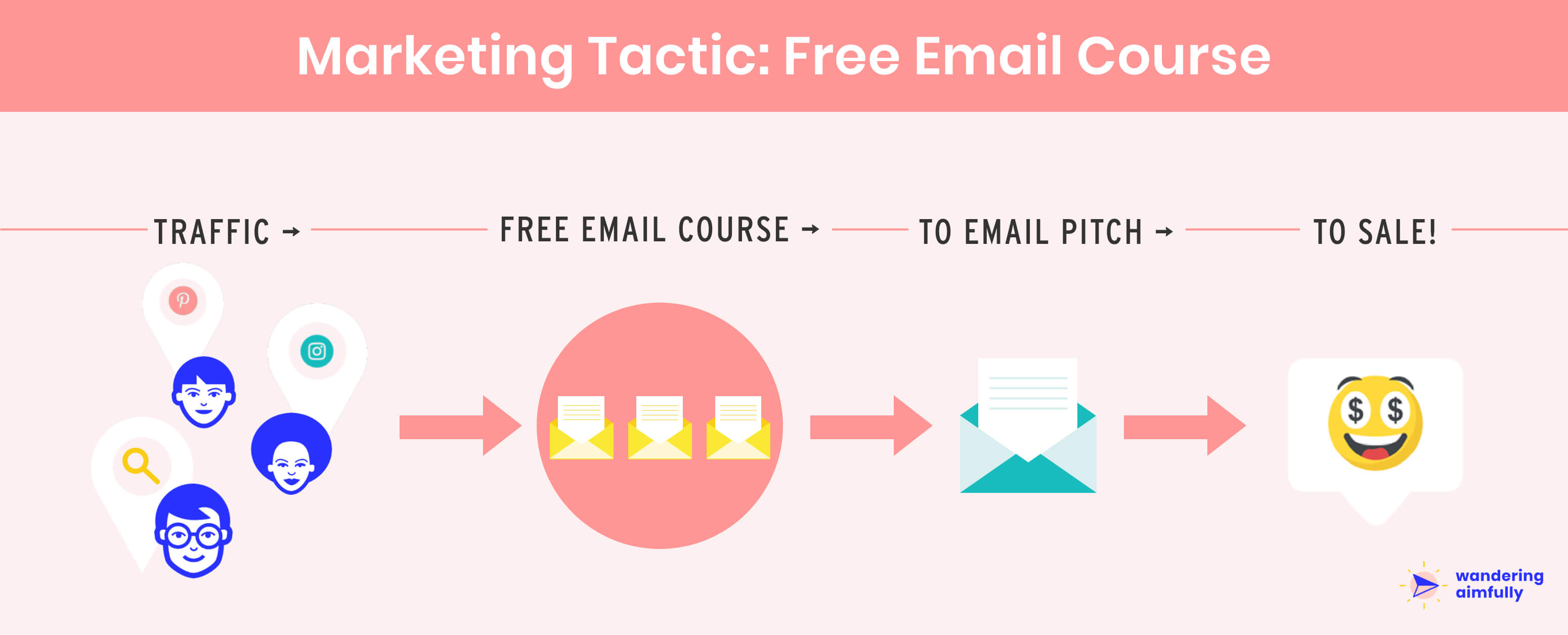
The concept: The “Email Course” marketing bridge is simple in concept. You send a series of emails around your offering topic and you soft sell in those emails, along with emails at the end of the sequence that are a sales pitch. Free email courses can take a good amount of experimentation (read: trial and a good amount of error) to get it converting people to paying customers.
Why this marketing bridge works: You probably aren’t a stranger to online courses but what most people don’t tell you is they can be hard to sell in the beginning (heck, even later on too!) The free email course marketing bridge works because it specifically shows HOW you teach and WHY you are the right person to learn from. If your potential customer gets a lot of value from the free email course, they’re extremely likely to buy your paid online course.
Our experience with this bridge: We absolutely love free email courses and think they are a solid way to build a lot of trust with your potential customers (from the mainland!) Over a few days you can help your potential customer solve problems around your email course topic and then show them how your offering speeds that process up or does some/all of the work for them. Email courses work well because they tend to be a great way to generate passive income (once you’ve tested out different emails, pitches, sales pages, etc).
👩🏻🦰 TRY US OUT 👨🏻🦲 If you want to sign up for one of our free email courses, check out Discover Your Differentiator, a free 7 lesson course designed to help you create more authentic branding by defining your Brand DNA, your ideal audience and your Brand Mission.
We’ve just given you a list of 13 different marketing ideas you can implement in your own business. There’s no guaranteed success with any of them but we have a sinking suspicion you haven’t tried 13 different marketing ideas in the past year.
Invest time each month in a new marketing tactic and see what bears the most fruit for you business!
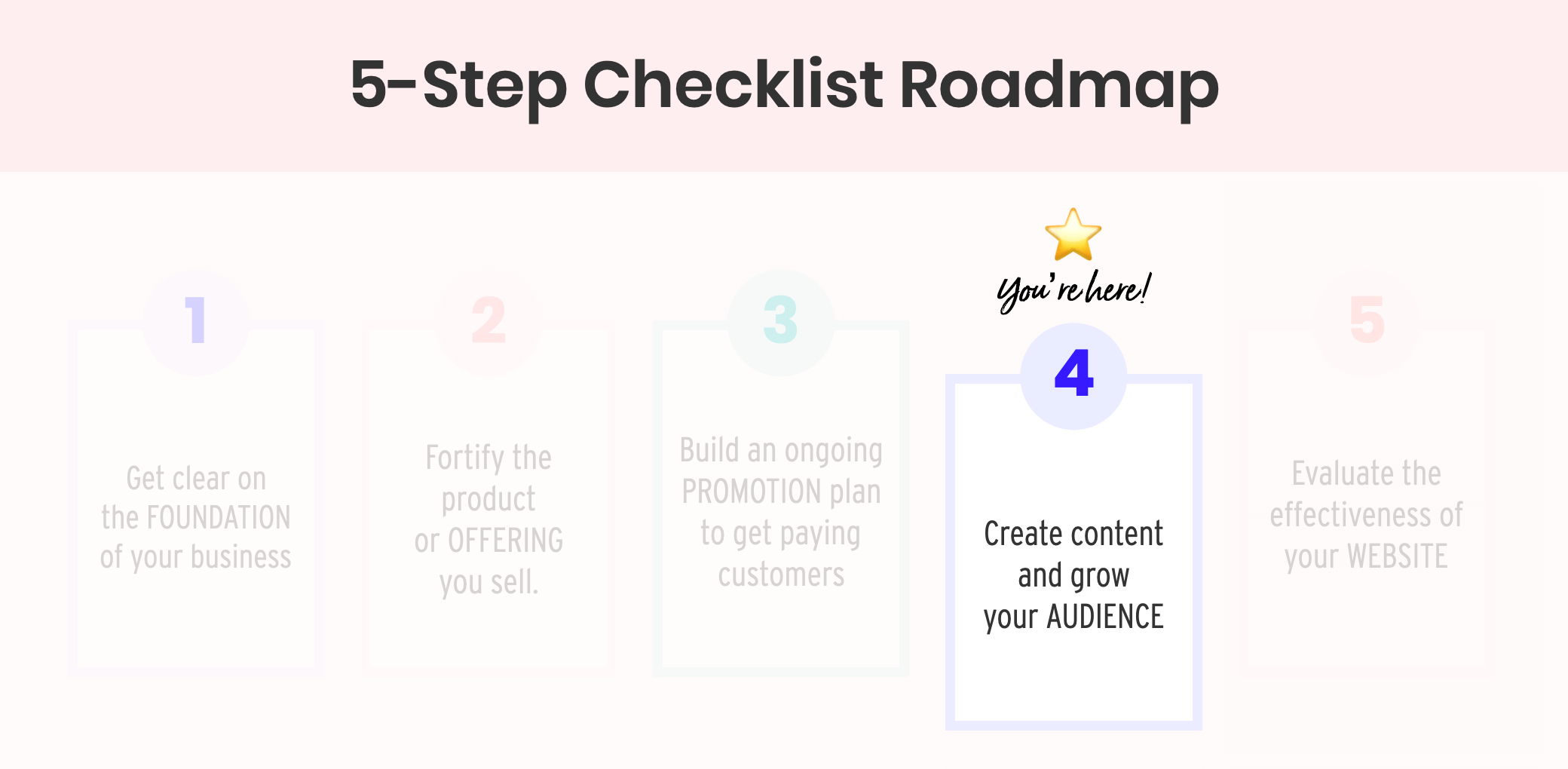
Slow, steady, and imperfect wins the audience growth race.
Since 2014 we’ve used an incredibly simple content marketing plan that’s helped us build highly engaged audiences that purchase from us. That plan involves:
We 100% believe in the methodology of slow, steady, and imperfect wins the audience growth race.
You might be shocked to learn that our email list has hovered around the 10,000 subscriber mark for years and our website traffic barely tips 50,000 visitors per month. But that amount of email subscribers and website traffic is enough to have us bring in (the coveted) multiple 6-figures* per year.
*Editor’s 👨🏻🦲note: Including this mention of our business income is not meant to brag or gloat. Unpopular opinion perhaps, but we don’t think you have to hit that coveted “6-fig” mark for your business to be deemed valuable or impressive. A successful business is one that makes enough money for you to do work you enjoy while living a satisfying life. We only share our results to reinforce that we’ve had financial success with very relatable and achievable audience numbers. We’re not JUST about money around here, but we acknowledge cash is oxygen for a business.
If you’re looking for a fast-track plan to skyrocket your audience growth overnight, you won’t find it here, friend. And honestly, unless you’re shelling out 💰💰💰on paid advertising (i.e. Facebook Ads), there is no overnight growth strategy other than sheer dumb luck.
Because we love metaphors, we’re going to share our content marketing and audience growth strategy by talking about salads. Did we say, salads?? Yes, salads 🥗.
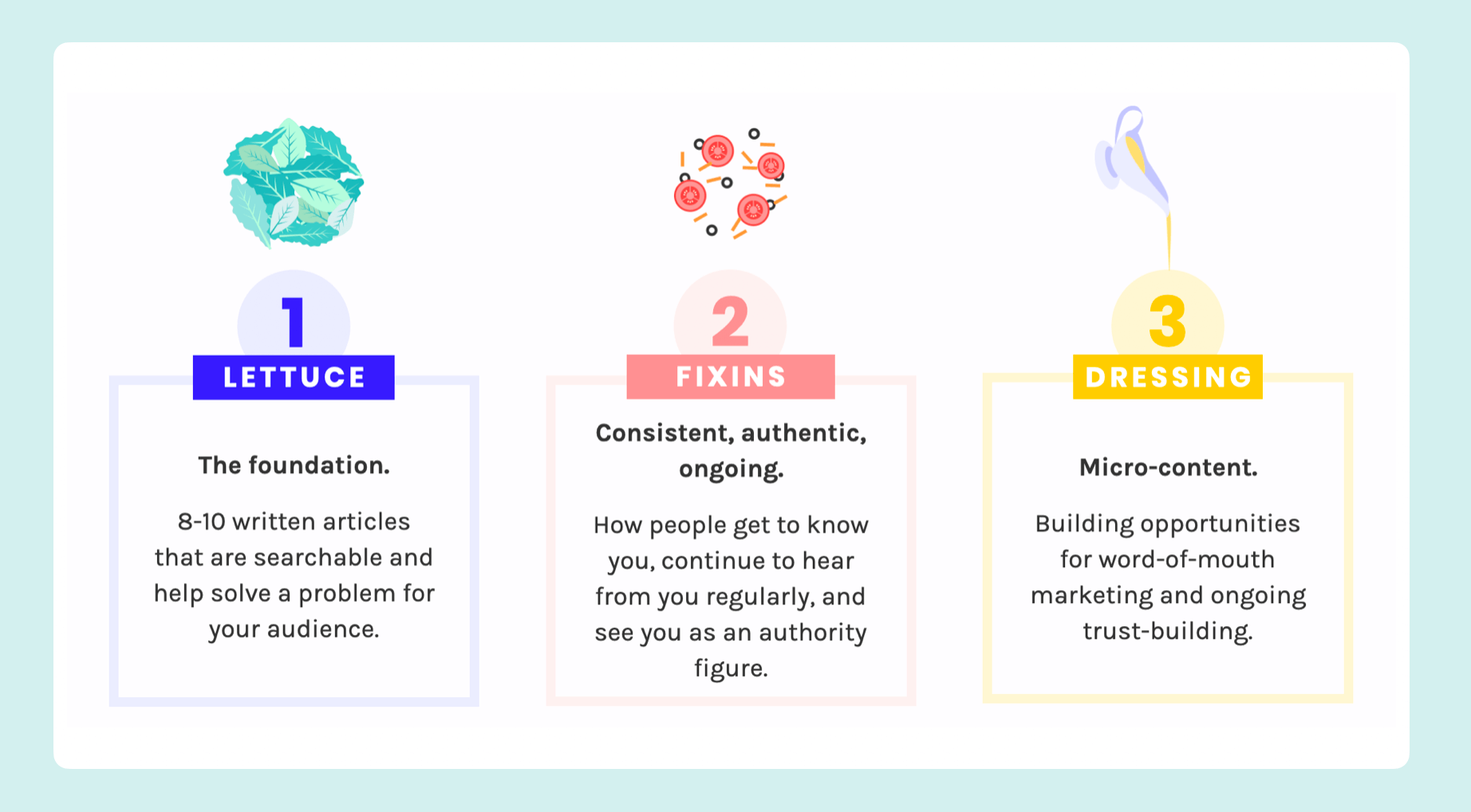
Foundation articles are the base of your content strategy, the lettuce of your salad. These are 8-10 searchable and helpful articles on your website that are related to your product/service topic. These articles help you build organic (search) traffic, attracting your ideal customer based on the problems they’re trying to solve.
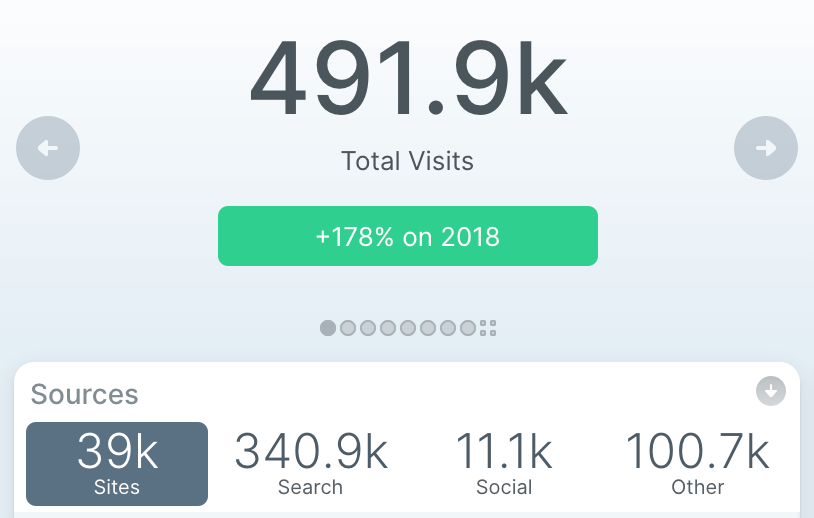
About 70% of our website traffic here at Wandering Aimfully comes from organic search. In 2019, that 70% number equated to over 340,000 people! Those people are searching for an answer to a problem (mostly in Google) and clicking on an article we’ve written to find the answer.
It’s important to note that we aren’t SEO experts, but we do consider ourselves good at writing imperfect articles that help people based on our experiences and knowledge. We employ a few basic SEO practices, but those can literally be summed up in a few bullet points:
That’s it. That’s our SEO strategy and it’s one we’ve used for over 400+ articles since 2014. We even used it on this article.
🕵🏻♀️ FURTHER READING 🕵🏻♂️ If you want to read everything we know and have learned about SEO, we have just the article for you. We’ve never paid an SEO specialist. We’ve never taken an SEO course. We’ve simply learned the SEO basics and implemented them over the years which has led to organic traffic growth. You can do the same thing!
Now, let’s address a couple of common questions as it relates to writing foundation articles…
🤔 How long should my foundation articles be? As long as it takes to help the reader have their problem solved. Word count doesn’t matter as long as you write from your own experience and are helpful (plus, you can always update/optimize later!)
🤔 What if I hate sitting down to write articles? If you’re not good at “sitting in the chair” then pull up a Google Doc and use the dictation 🎙feature. Pretend you are speaking directly to a friend and trying to help them. Then, go through the dictation transcript and turn your recorded words into an article that can read by your target customer.
🤔 Should I just hire a writer to write for me? Maybe… If a writer you can hire has the experience related to your product topic, sure. But, you shouldn’t hire a random VA to compile an article based on other articles they find. You need to share your unique experience and lessons to truly stand out. You SHOULD hire a VA to help with copyediting and article structure if you feel lacking in those areas.
🤔 What if I already have a bunch of articles on my site, what should I do? Most likely, you need to do a content audit. Our latest content audit was in 2018 and we went from 400+ articles whittled down to ~120 articles. We wrote about our entire content audit experience here if you want to read more.
🤔 What platform will give me the BEST chance at ranking Google? WordPress? Squarespace? The platform DOES. NOT. MATTER. Let us repeat: The platform does not matter. What matters is writing helpful articles that solve a problem for your customer and following a simple SEO strategy like we’ve outlined above.
⚡️ACTION STEP ⚡️ Create a list of 8-10 foundational article topics and publish them! Don’t know what the heck to write about? Here are two tips for you: 1) Use the Google Search autofill technique. Whatever keyword or phrase encompasses what you sell/do, start typing that into Google Search and see what searches autofill – this is a great way to identify what things people are already searching for that you can write. 2) Fill in the sentence “I want to help you…” As it relates to what you do, write that sentence out 8-10 times based on how your product or service can help someone.
We call Part 2 the “fixins.” These are all the black olives, croutons, carrots, cucumbers, tomatoes, did we mention croutons yet?? Fixins are the ongoing serialized content you create to build trust and connection. They’re the pieces of content you publish consistently to build trust with your audience (or to attract new people!)
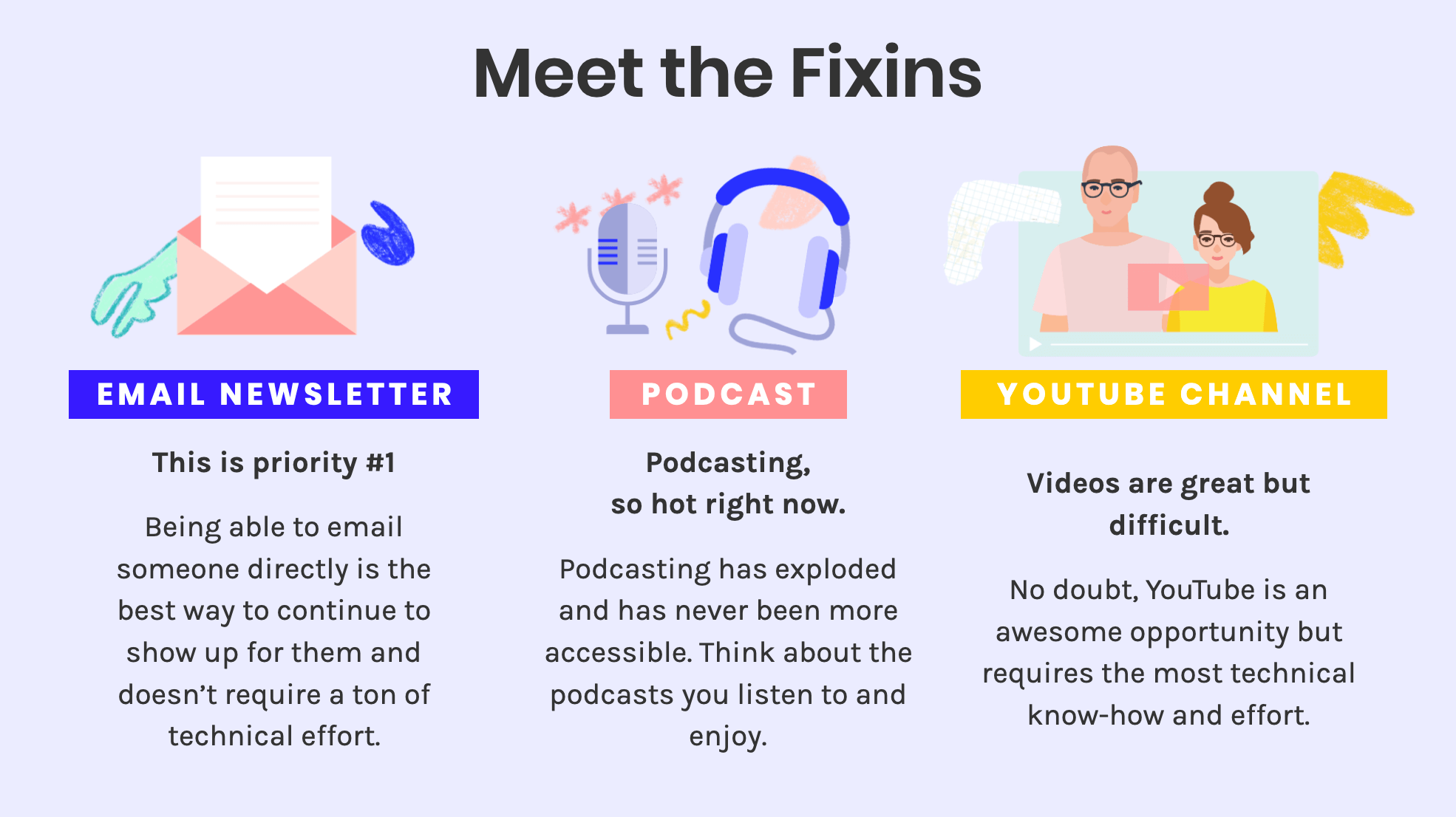
Over 90% of our revenue is directly tied to our email newsletter.
This is priority #1 for us and has been for nearly a decade. Sending out consistent and helpful email newsletters may seem like a thing of the past but boy-oh-boy do we disagree. We generate over 90% of our revenue directly from our weekly email newsletter.
We strongly believe in consistent email newsletters because:
Sending out a weekly email newsletter is almost non-negotiable for us and has been for many years. Sure, we’ve missed a week here or there, but with only a few exceptions, we’ve been sending out Monday weekly emails for the better part of 7 years. Especially in the beginning, we tried to hit send on an email newsletter every week no matter what (plus, getting 3-4 weeks ahead of your writing schedule helps!)
Our email strategy is very simple: Be consistent. Be helpful. Be entertaining and fun where possible. Don’t be afraid to sell but don’t ONLY sell to people.
It’s no secret that podcasts are continuing to grow in popularity. Where Serial paved the way for the masses to embrace podcasts, online business owners have been doing some form of podcasting for a long time.
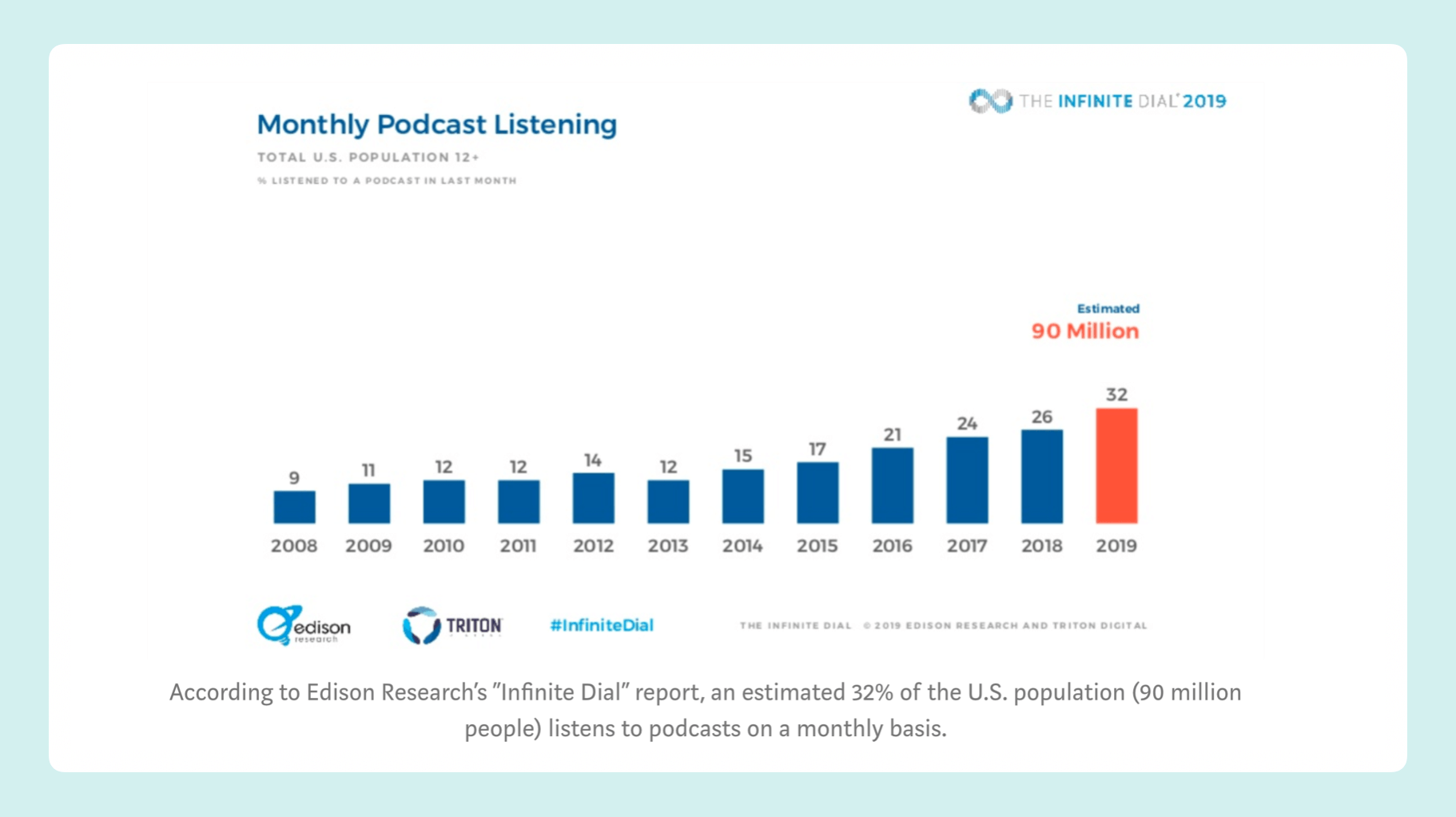
Nowadays, it’s never been easier to spin up a podcast. The problem is, most people don’t follow a couple of simple rules when starting a podcast:
🕵🏻♀️ FURTHER READING 🕵🏻♂️ We put together a Starting A Podcast guide that walks through all the details of podcasting. It includes how to structure a good show, why or why not to interview guests, what gear to use, and a strategy for getting early traction in the New & Noteworthy section of Apple Podcasts.
Spoiler Alert: For most people, creating videos may simply be too overwhelming. The tech involved is tough. The awkwardness on camera is hard to get past. But, if you do want to dabble in creating videos we have some thoughts for you (I’ve personally created over 2,000 videos in my time, and no, that’s not a typo).
🎬 Be yourself. This may sound like extremely simple advice, but people can tell when watching videos if you’re trying to be the next Casey Neistat (or whoever is popular on YouTube these days). Sure, take a nod from the pros, but find your own voice and your own unique video style.
🎥Good lighting and good audio go a LONG way. Sure, having a compelling story arc and visually interesting footage in your video is helpful but if your lighting and your audio are crap, people are going to X out of your video faster than you can spell video. This doesn’t mean you need to buy the fanciest gear, it simply means you need to find a good source of natural light to sit in front of if you film yourself or your subject matter and you need a quality microphone (we recommend and use this ~$75 lav mic from RODE).
😬Embrace imperfection. My early videos are awwwwwful. Just terrible and hard to watch. Yours will be too! Everyone starts out crappy when it comes to video. Know this. Accept it. Hit record, edit, and publish. Then move on.
This fixin is probably the one that most people won’t dabble in and that’s okay. You need to pick the fixins that are right for you and ones you can consistently stick with!
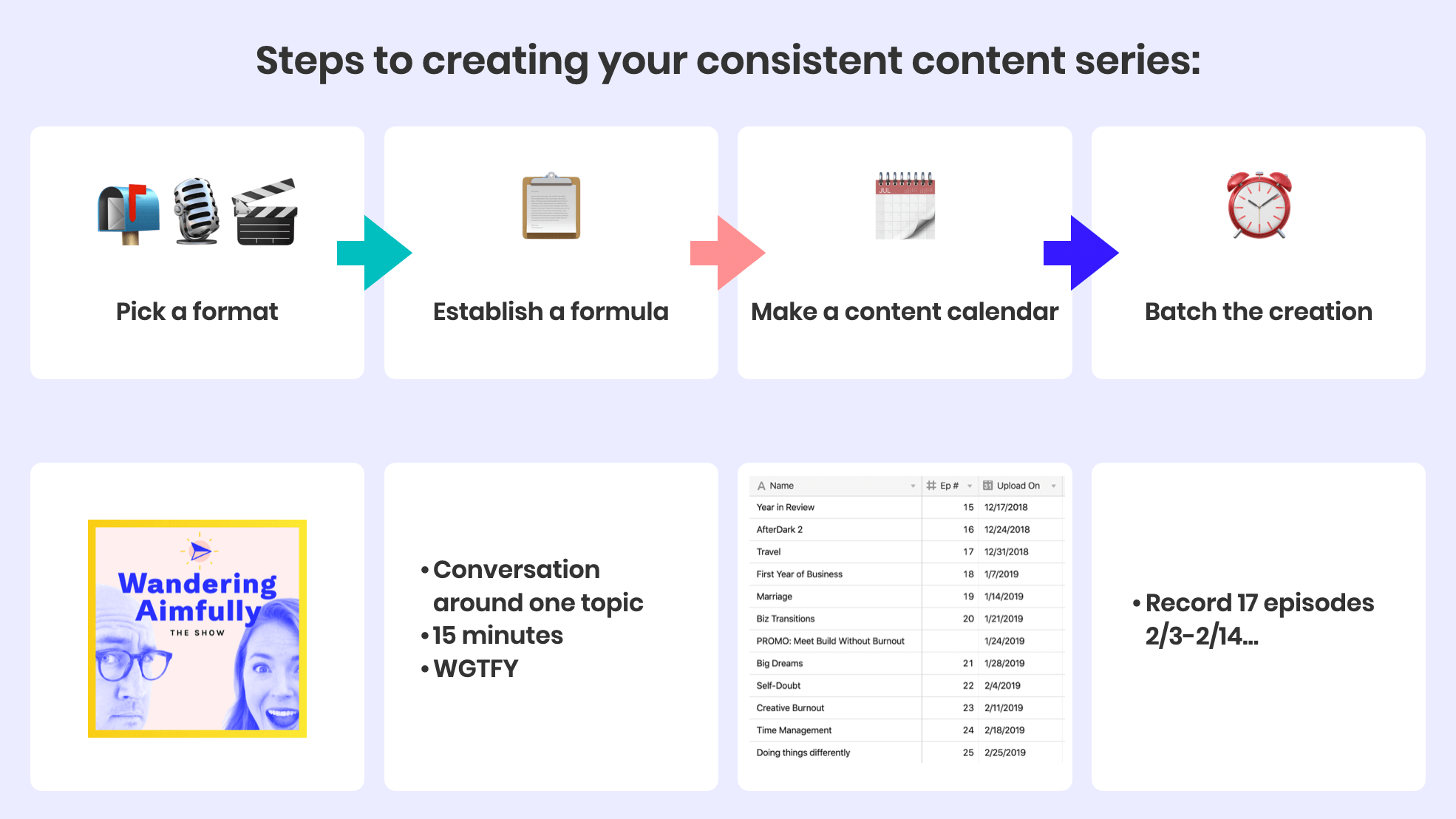
⚡️ACTION STEP ⚡️ Decide what fixins are right for you and your situation. Is it a weekly email newsletter and a bi-weekly podcast? Is it a weekly newsletter and a monthly video on YouTube? Or is it a combination of the three? We believe a consistent email newsletter is critical, but the other fixins are optional.
A content strategy that starts with social media is like a building a salad by pouring dressing on the plate. You’d never put lettuce and fixins on TOP of dressing and try to eat it that way. You need the foundation of your salad first, THEN your fixins, THEN your dressing (social media) goes on top.
If you’re running an online business, where you sell a product or service, you’ve probably already created social media accounts. Heck, it was probably one of the first things you did and our assumption is that you probably spend time on social media each week without having a consistent email newsletter and foundation articles. That’s OKAY, but we want to remind you that you are trying to run a business, not just grow a social media following.
You can’t pay your rent/mortgage with a bunch of social media followers.
We believe a few things about using social media:
Social media is the dressing on your content marketing and audience growth salad. It’s definitely something that can make a salad taste WAYYY better but you have to get the other parts of the salad right first.
A couple of questions you may be thinking as it relates to using social media to grow your online business…
🤔 What social media sites should I be using? Facebook, Twitter, Instagram, Pinterest Snapchat, TikTok, the list goes on and on. The key answer here is: Where does your ideal audience spend their time AND where do you want to spend yours? Even if your audience is on Twitter, maybe you don’t like Twitter, then you shouldn’t use it. That’s like forcing yourself to eat a caesar salad when you hate… caesar salads. Pick the platform you can most enjoy and that your audience exists on.
🤔 How often should I post on social media? We’d vote for creating a posting schedule that you can stick with and that matches the platform’s natural ebb and flow. For Instagram, you don’t need to post every single day. For Twitter, posting every day makes more sense. We don’t use Facebook, so we’re no help there. Ideally, you’ll have some understanding of the platform and you can build a schedule for posting content that works for you.
🤔 What the heck content should I even be posting? Ahhh, this is a GREAT question but it’s also a tough one. We like to think of social media channels as a great way to disseminate micro-content from our weekly email newsletter, our foundation articles, and our marketing bridges. What tips, sentences, phrases, takeaways, key learnings, lessons, and stories stand out from the content you’re already creating? Use those as fodder for social media content and you should never run out of ideas!
⚡️ACTION STEP ⚡️ Give yourself permission to not be on ALL the social media channels. For us, we essentially only focus on Instagram. We like the experience, our ideal audience hangs out on IG, and that works for us. Pick the social channel that’s right for you and focus on being consistent and helpful.
Remember who you are creating content for. While it may be fun for you to sit down and write a blog post about the gluten-free bread recipe you discovered last week, does that serve your ideal customer and their needs?
We’re not saying don’t have hobbies and don’t create content around your life. But as it relates to your business, follow the plan we’ve laid out here FIRST and then layer in additional content.
This is a fact. We’ve watched it happen for our businesses and our friends’ businesses around us. Sure, it may take a bit longer than you want to get consistent traffic and audience growth but this strategy works.
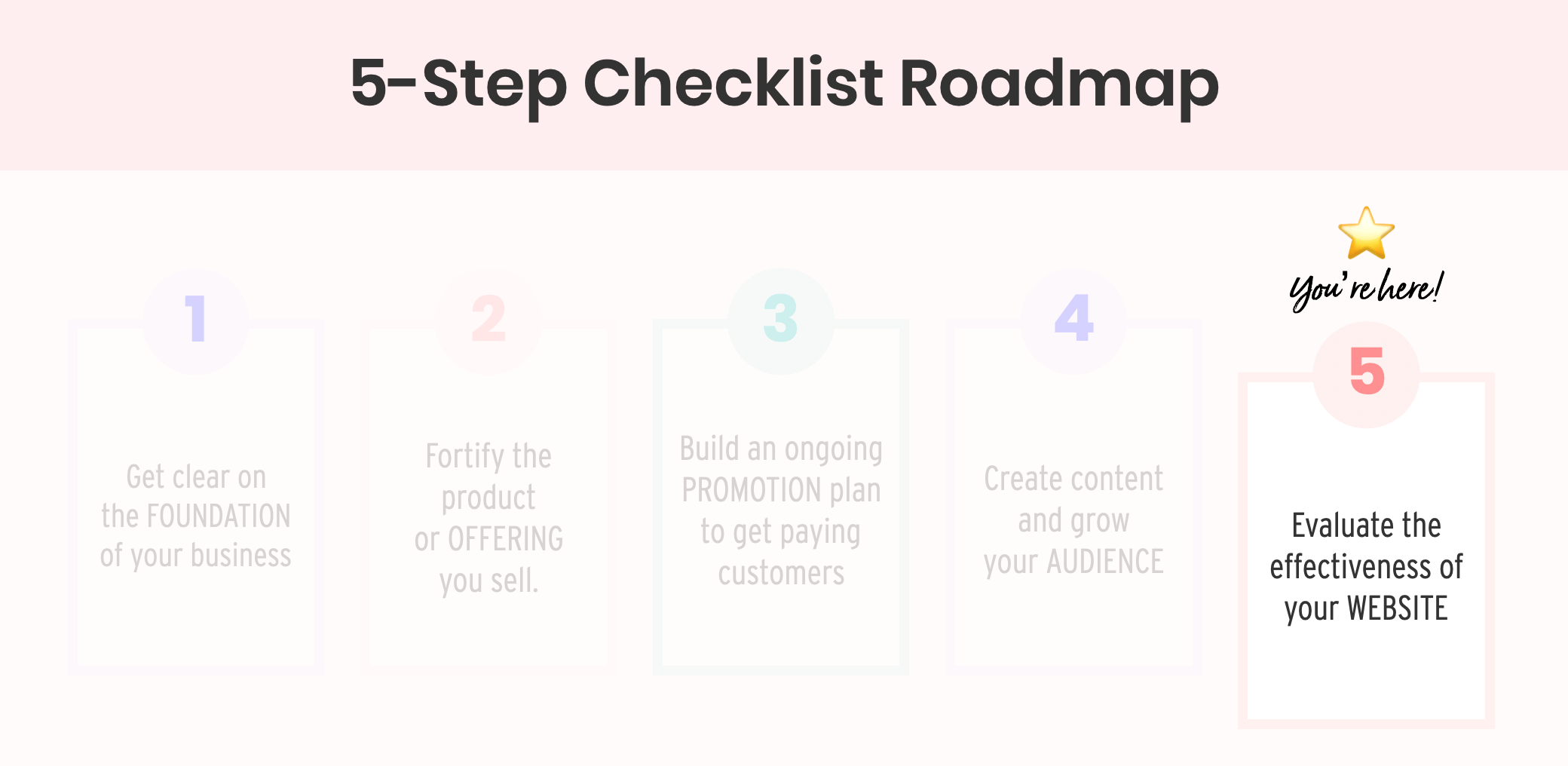
You may be utterly shocked that we haven’t talked about your website (with exception to your services/sales page) up until Step #5. There’s a reason for that. Most people START by creating their website but don’t have a solid foundation of the previous steps we’ve outlined to make their website actually work on their behalf.
Your online business’ website exists to help you hit your business goals. If it’s not helping you hit your goals, what’s the point in having it at all?
The big question you should be asking yourself is: How effective is my current home page at serving my business goals?
To answer this question, we’re going to bring our friend “4Qs” back around but adjust the questions slightly as it relates to evaluating the effectiveness of your current website’s homepage.
When a new visitor lands on your home page, they should be able to quickly answer these 4 key questions:
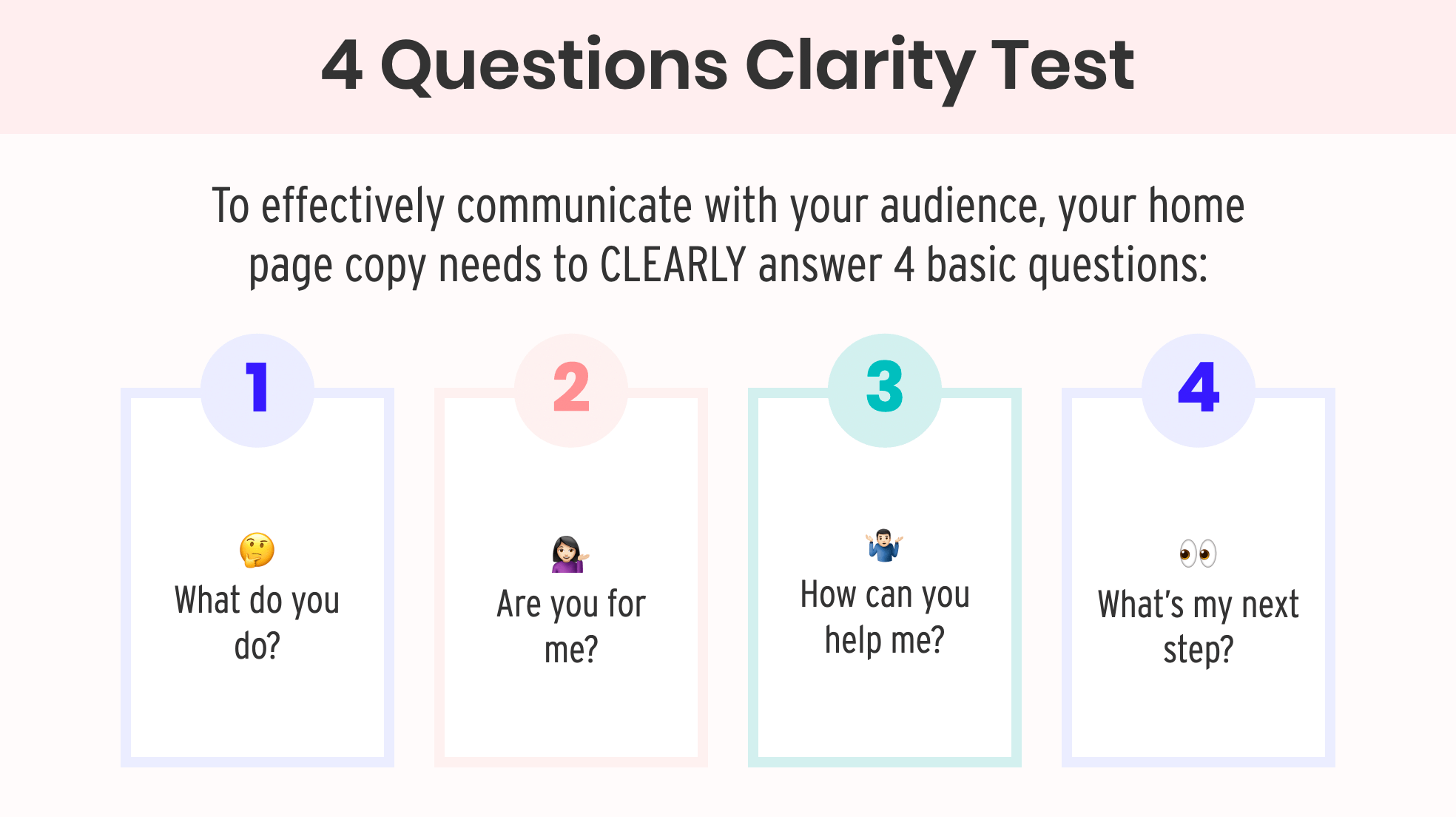
At a quick glance at your home page, is it easy for someone to understand what the heck you do? A potential customer browsing your website’s home page should be able to put you in a mental bucket relatively easily.
One key mistake we see with people’s home pages is they use confusing phrases to describe what they do. We like to call describing what you do your two-word tango 💃. Let’s look at an example:
BAD TWO-WORD TANGO – Website Whisperer
GOOD TWO-WORD TANGO – Squarespace Designer
YOU may think saying something “Website Whisperer” is cute and adds personality, but your ideal customer may have no clue what that means. Can you use cute ways to describe what you do? YES… but only after it’s made very clear. Put yourself in the shoes of your customer who doesn’t know your world inside and out.
⚡️ACTION STEP ⚡️ Make sure you’re answering the question, what do you do? clearly on your home page using a two-word tango (pro-tip: it can be 2-4 words). Make your two-word tango extremely obvious to understand.
When a potential customer lands on the home page of your website, the very top portion of your website should IMMEDIATELY answer the question they’re thinking: Are you for me?
Your potential customer should be able to recognize they are in the right place and that you can help solve their problems.
This question relates back to the WHO question from Step #1. We can reuse it here and this tagline should be at the top of your home page:
BAD TAGLINE – I design websites for businesses.
GOOD TAGLINE – I help yoga instructors build beautiful websites that get them more paying customers.
We’ve already explained why the GOOD example is better, but can you see how placing this at the top of your website will also help your customers know that you are the right fit for them?
⚡️ACTION STEP ⚡️ Are you currently answering the question, are you for me? at the very top of your website’s home page? Make sure your audience is clear and obvious!
The outcome you can deliver to your potential client/customer should also be front and center on your home page. In an ideal world, you are answering this question in the same sentence as the are you for me? question.
Avoid using vague phrases that don’t mean anything. Things like:
Instead, write the extremely specific outcomes you can help them achieve:
⚡️ACTION STEP ⚡️ Avoid vague outcome statements and be as clear and specific as you can so that your potential client/customer knows you are going to help them!
It should be painfully obvious what you want your potential customer to do on the home page of your website. Think of this as highlighting your marketing bridge (from Step #3!)
The call-to-action you want someone to take shouldn’t be hidden or stuffed down at the bottom of your home page, and it might even need to be repeated on the home page depending on the length of it.
You may have seen on our home page there’s only ONE button you click on the entire page:
We did some testing in 2019 with a longer home page and a shorter home page. We found the shorter home page led to a drastically higher conversion to getting people into our marketing bridge (a free quiz). Don’t be afraid to test your assumptions about shorter or longer home page designs and let the data tell you what works best!
⚡️ACTION STEP ⚡️ What is the ONE ACTION (marketing bridge) someone should be taking on your home page? Do not overwhelm people with multiple actions if at all possible.
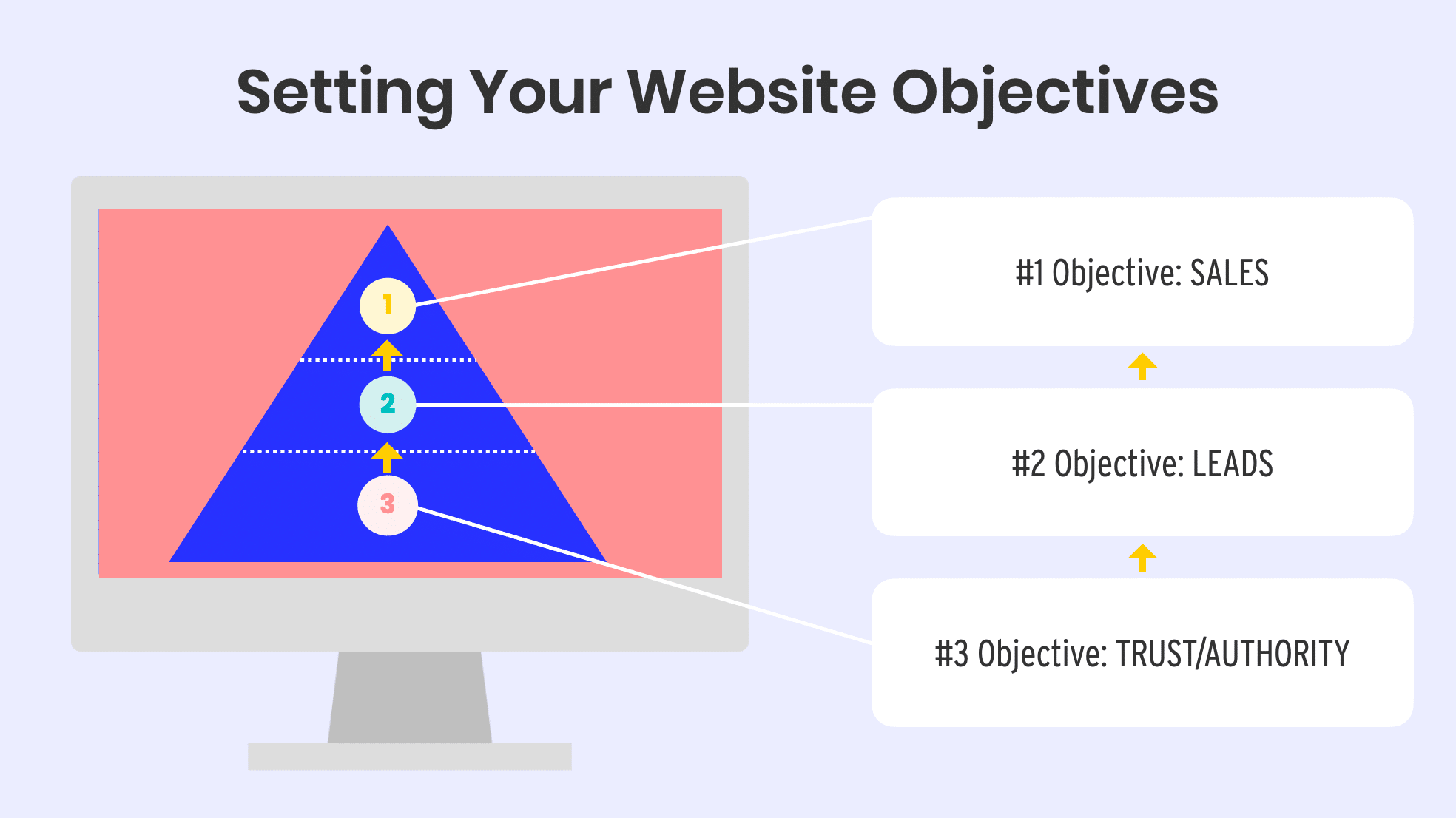
Online business websites should follow a straightforward 3-objectives approach that involves primary, secondary, and tertiary objectives.
Important note about your primary business objective: You must CHOOSE HARD. Pick a primary audience. Focus on one product or service. (You’re likely already doing this because you’ve done everything in Steps #1 and #2, right??)
As shown in the image above, we believe your objectives should be as follows:
We’re going to reverse the order of listing out our 3 objectives so you can see how they lead into one another…
Tertiary Objective (TRUST/AUTHORTY): We share helpful content (articles/podcast) to build authority. We embrace our personality/uniqueness to build trust.
When people find our home page, if we’ve done our job with our Tertiary Objective, it ushers them into…
Secondary Objective (LEADS): Enter your email for our Free Business Blindspot Quiz marketing bridge.
If our website 4Qs have spoken to our ideal person, they get into our marketing bridge, and then…
Primary Objective (SALES): Buy our Un-Boring Group Coaching Program!
BOOM! Our website goal has been met if all goes to plan!
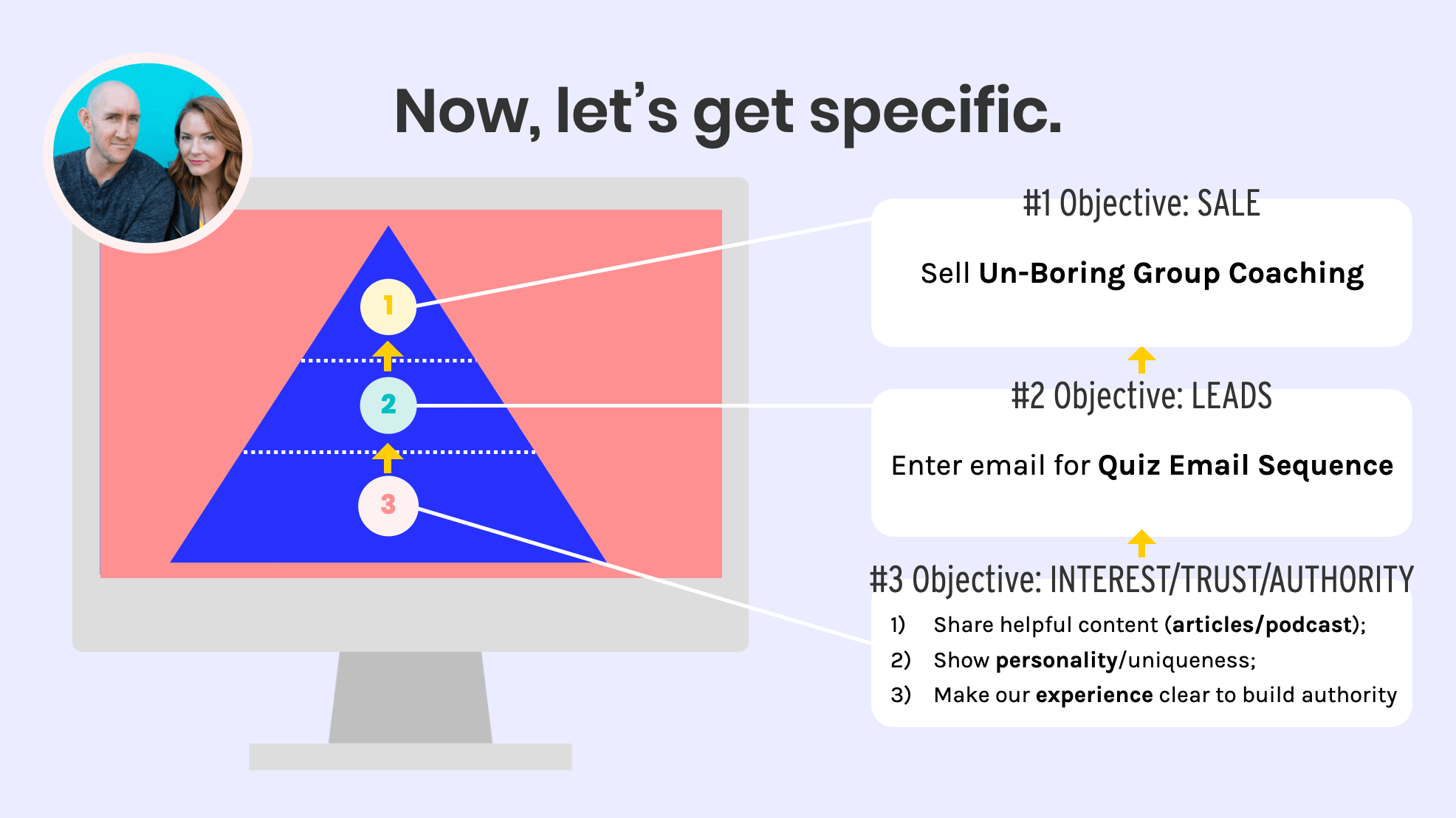
⚡️ACTION STEP ⚡️ Write out your 3 site objectives as we’ve shown for our own biz. By putting them in order of tertiary → secondary → primary, are you able to see how your website’s home page can more effectively help you reach your goals?
If you are utterly confused about exactly what you should put on your website’s home page, we have a framework for you! We call this the APSOSA Framework and it’s led by our wizarding friend, Webineezer!
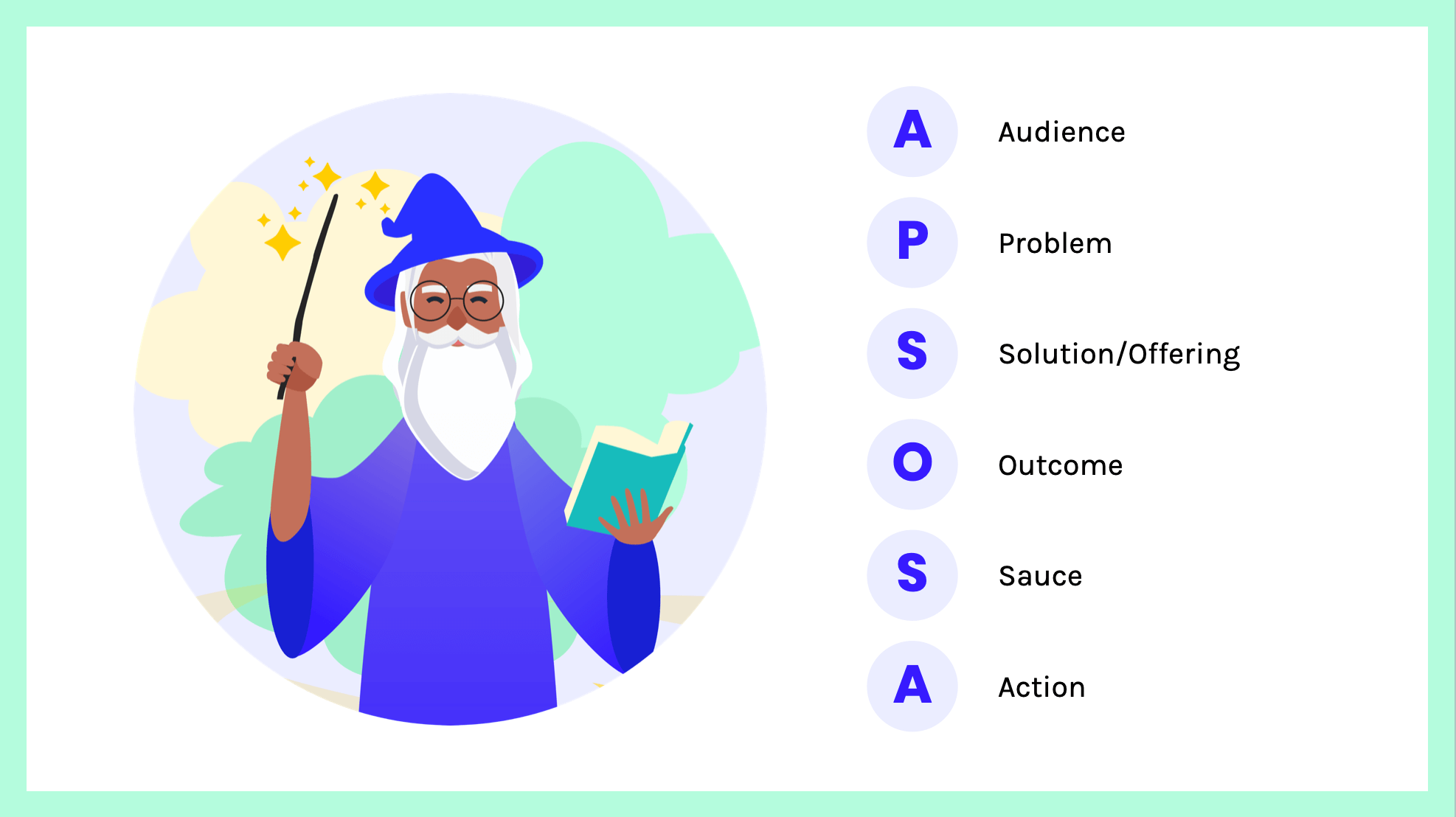
You want to be able to identify who you’re talking to and they need to immediately recognize themselves in your copy of your home page.
Speak to the problem that your audience currently has. Remind them what they’re struggling with.
This is where you tell them the solution to their problem, but you position YOUR offering as that solution.
This is where you describe how their life will be better on the other side of buying from you/working with you. Paint a picture of the future they could have.
This is how you stand out from the sea of other websites they’ll check out that same day. How can you be memorable? How can you add your authenticity?
Make it clear what the MOST important action you want them to take is. Be clear about what’s waiting for them on the other side and make it compelling.
If your website’s home page only does those six things, you will hit your website objectives. In fact, we’d say your home page shouldn’t do much more than those six things because anything else probably belongs on other pages of your site (About Page, etc).
🕵🏻♀️ FURTHER READING 🕵🏻♂️ It probably won’t surprise you at this point to know we have an entire additional article that dives deeper into applying our APSOSA Framework to your website’s home page. That article includes a walkthrough video where we redesign one of our coaching member’s home page using APSOSA.
⚡️ACTION STEP ⚡️ Apply the APSOSA Framework to your current home page. Does it meet the six requirements? If you’re not sure, send your home page to a colleague or ideal customer and ask them if it meets the six criteria.
You made it through all five critical steps of fortifying your online business! We know this has given you a LOT to think about. But we also hope that by putting all of these crucial components together in one epic post, you have a central location that acts as a roadmap for how to improve every single aspect of your business.
We know it’s not the “silver bullet” that other entrepreneurs might promise you, but remember…you don’t want to buy expensive hot-trash. 😉
Focus on the foundation, take it one step at a time, and watch your business grow. Now, before you click away, remember not to commit a business FOPAW 😜(get it?? it’s the phrase “faux pas” but in the acronym of the 5 steps?? you get it.):

If you run an online business, sure, you know marketing is important, but how can you improve your marketing efforts unless you break down that big word into more actionable pieces?
In this article, we want to share with your how we break down the broad idea of marketing into more digestible parts, plus we want to give you our proven marketing strategies that you can experiment with to boost revenue for your business.
Before we go any further, we want to make sure this article can actually benefit you. These are three critical pieces of the puzzle you need to have in place right now:
Did you say HELL YES! 💪🏼 to all three of those things? Awesome, then let’s keep going.
Before we dive into what marketing is and how we’re going to help you feel less overwhelmed by it, let’s start with what you WANT:
We don’t think there’s anything wrong with that, especially if you’re intentional about defining how much money is enough for you and why you want it in the first place. More money = more freedom. It means more breathing room, more time for the things you value, less stress, and hopefully whatever makes you money is also helping the person who is buying from you.
In order for your business to make more money, you need more clients or customers—it’s as simple as that. And you’re likely in one of these two categories:
#1: You have a service offering that has been validated (meaning someone has paid for it) but you DON’T have a steady stream of clients knocking on your door to hire you.
#2: You have a product that some people like, but sales aren’t as great as you expected and you’re not sure why.
This is where the all-powerful marketing comes in. We need to figure out the gaps in your marketing strategy to understand why you aren’t getting the number of clients or customers you want. And maybe you’re like hmmm, “I don’t think I have a market strategy,” in which case GOOD because this article will help you come up with one (or two, or three, etc!)
Okay, so let’s take our big term Marketing and break it down a bit…
Marketing is the blanket term to describe anything that connects your audience with your offering (product/service).
Let’s paint the scene for you. Cozy up for some storytime and metaphors!

On one side of this scene we’re painting, we have an island. This island is your business, your beautiful little slice of paradise that is all yours. Your island is on the internet and it lives at your website address.

What you sell is a glorious and beautiful castle sitting on your island. It’s your web design services. It’s your online course that helps people clarify their messaging and branding. It’s your 1-on-1 coaching to help people unlearn the bad habits they’ve picked up in their lives. Whatever you sell, that’s your castle.

Now imagine there’s another bigger piece of land wayyyyy across a body of metaphorical water (a river, an ocean, a sea, whatever body you like). This is the MAINLAND Internet. This is where ALL the people are (your potential customers). They’re hanging out in all kinds of hip neighborhoods like Instagram Alley and Podcast Peninsula and Facebook Group Gulf and Popular Blog Bluff.
Not only do these people have to be willing to leave the mainland and venture over to your island, but they also need to build enough trust with you that they’re willing to hand over their hard-earned mainland dollars to enter your castle.
How does someone move from the mainland to your island?

You need a GUIDED PATH for interested people to get from where they are in all those mainland neighborhoods, over to where your product lives (your island). Now, is it as easy as just dropping your website link everywhere you can think you’re ideal peeps are hanging out? Is that a marketing bridge? No ma’am. Because if it was that easy, you wouldn’t be reading this article right now.
A great marketing bridge that gets people from the mainland to your island requires a step-by-step path, one that constantly invites your audience to deepen the connection with you aka go farther and farther across your bridge until they’re ready to enter your castle. We call these invitations throughout your marketing efforts “guideposts.”
But, just because the marketing bridge exists, doesn’t mean people KNOW it’s there. You need to point them in the right direction and guide them down a well-lit path from the mainland, across your bridge, and to your island and eventually into your wondrous castle. These guideposts represent things like your content marketing, maybe some paid marketing, or anything that can get in front of someone and say, Hey! This thing exists!
Let’s recap the marketing metaphors we’ve laid out for you:
Now that we’ve broken this big vague idea of “Marketing” into its parts, we can more clearly see where people often fall short. In our experience, there are three mistakes people often make related to their marketing bridge.
This is the equivalent of putting up billboards over on the mainland saying “Pay $100 to come to my castle!” when people are just hearing about you for the first time. There’s no bridge there, no journey for them to go on to understand what your business is, how it can help them, and why they should pay you money.
Let’s say you’ve spent time and energy building out a robust, helpful free email course on branding as a lead in to sell your branding course (ps. this is one of our Bridge Blueprints below!) You know it works because a few people have converted to sales. The problem is that no one is finding it! Unless you’re creating helpful content in the form of things like social posts, videos, podcasts or articles, then people who could be your potential customers have no way to stumble across you. Your bridge might as well not exist because it’s not connecting with the wealth of people already hanging out over on mainland/the internet!
It’s not enough to simply build the bridge; as we mentioned, you need guideposts throughout your bridge so that people can gradually get to know your business and build trust.
Imagine this: Someone stumbles across your podcast that’s all about how to plan and run big business events. They WERE listening to the latest true crime podcast, but they decided it’s time to up-level their business knowledge and they’re thinking of running an event in the future so they find you in their favorite podcast app. Woohoo! That’s like someone wandering around the mainland and seeing your billboard that says “Hello! I’m a business and I exist!” Great.
Now imagine if you encourage listeners at the end of your podcast to sign up for your email newsletter. Plus 12 points for you! That’s a guidepost—-and invitation for them to step foot on your marketing bridge. Things are looking good for you. But NOW imagine this ideal customer of yours hops on your newsletter and immediately gets pitched your $1,000 course on how to plan your own large-scale event. She’s like WHOA, I just started listening to your podcast. I’m not ready for this level of commitment!
People *most* often need multiple touchpoints to build trust with you before they buy. Instead of pitching up front, maybe you deliver info-packed, valuable newsletters every week to your customers. Maybe you invite the most engaged subscribers to live workshops or a targeted free video series so they can learn more from you first and really get to know you before they buy.
The same goes for a service-based business, instead of closing the deal on the first consultation call, maybe you want to send a proposal first with ideas about how you plan to help them. With each interaction, you want those peeps coming from the mainland to fall deeper and deeper in love with your brand and to move farther and farther down the bridge.
We want to share with you 13 different ways to build a marketing bridge between your audience and your offering. One quick thing we should note though:
As we talked about at the very beginning of this section, we’re assuming you already have a traffic source or two for your business. Traffic sources can be, but are not limited to:
Okay, now that you understand how we think about marketing, we want to share 13 different marketing bridges and their blueprints that you can experiment with in your business. We’ve ordered the 13 blueprints from easiest to implement to more in-depth.
Important note: Just because a marketing bridge is harder to implement does not mean it will land more sales. In fact, we’ve found some of the simplest marketing bridges are the most effective! Remember to use an experimenter’s mindset as you plan your marketing calendar and try these marketing bridges on for size in your business.
Hello, friend! 👋 This is a great moment to hit pause and let you know that we have a monthly coaching program that teaches you a concept and gives you actionable takeaways. We have an upcoming session dedicated to the topic of Building Your Marketing Bridges.
Why this matters to you is that in our group coaching program not only will we go over our marketing bridges more in-depth (and on a live call where you can work with us 1-on-1 👩🏻🦰👨🏻🦲) BUT we’ve also created checklists for EVERY marketing bridge/blueprint listed below. Along with the checklists, which will give you step-by-step tasks to implement a marketing bridge, our coaching program includes a 12-Month Marketing Calendar to help you keep track of your marketing bridge efforts. If that sounds awesome to you click here to learn more about our 6-Month Un-Boring Group Coaching!

Our 👩🏻🦰👨🏻🦲 Favorite
The concept: The “Newsletter” Blueprint is the most basic marketing bridge for an online business owner but is also one of the most powerful. As amazing as social media platforms can be, they are always changing. However, people’s use of email has stayed steady and the experience of reading email is a lot more focused than quickly scrolling/swiping through posts in a social feed.
Our experience with this bridge: We’ve successfully used the “Newsletter” blueprint to generate over $2,000,000 in business revenue over the past decade. Over 90% of our business revenue continues to come from our email newsletter and that’s why we are listing it as the first, and what we think should be, a foundational marketing bridge you have in place.

The concept: The “Consultation” Blueprint is the most direct and 1-on-1 marketing bridge we’ll talk about. This blueprint is almost a must-have if you are a freelancer and are trying to get more clients but we’ve even used this blueprint to sell higher-priced digital products. Speaking of which, it’s not a good idea to use this blueprint for lower-cost offerings (the time isn’t worth the money).
Our experience with this bridge: As we just mentioned, we’ve actually used consultation calls to sell digital products in the $1,000 – $2,000 range. When we used to offer client services, consultation calls were a critical part of the marketing process. The key with this blueprint is to have the consultation call sign-up process as efficient and straightforward as possible. And while the call itself is important, the follow-up pitch emails are where the final move across the marketing bridge and into your offering castle will happen!

The concept: The “Lead Magnet” Blueprint is like an upgrade to the Newsletter Blueprint. You offer a freebie or downloadable item (PDF, checklist, etc) that someone has to give their email address to receive. Lead magnets are a marketing win-win if the freebie/downloadable thing delivers extra value based on what your potential customer was already interested in.
Our experience with this bridge: Over the years we’ve found that some of our most interested and qualified potential customers come from some sort of lead magnet. Because they are willing to enter their email to learn more about something and invest time doing so, they are usually more ready to purchase from (especially if the lead magnet delivers on its promise!)

The concept: The “Email Course” Blueprint is simple in concept but can take a good amount of experimentation (read: trial and a good amount of error) to get it converting people to paying customers. You send a series of emails around your offering topic and you soft sell in those emails, along with emails at the end of the sequence that are a sales pitch.
Our experience with this bridge: We absolutely love free email courses and think they are a solid way to build a lot of trust with your potential customers (from the mainland!) Over a few days you can help your potential customer solve problems around your email course topic and then show them how your offering speeds that process up or does some/all of the work for them. Email courses are great because they tend to be a great way to generate passive income (once you’ve tested out different emails, pitches, sales pages, etc).

The concept: The “Epic Post to E-Book” Blueprint is not for everyone but it can be the BEST way to create consistent organic traffic and email signups. This article you’re reading right now could be considered an “epic post” with exception to the e-book part (which we’ll talk about in the experience section below). The goal is to create a piece of content that really nails a topic and then offer the reader an e-book version to download, which puts them in your “newsletter blueprint” (or “lead magnet/email course” blueprints).
Our experience with this bridge: We thoroughly enjoy writing in-depth “epic posts” based on what we’ve learned and what we’ve experienced. We find that our “epic posts” are the ones that rank most often and end up on the first page of Google which brings us organic traffic over time. While writing these marketing bridges we realized we had YET to do the e-book portion of this bridge and we’d really only pitched our email newsletter as the guidepost to get someone to our castle.
In our Un-Boring Group Coaching program we’re including step-by-step checklists for all of these marketing bridges. This “epic post” bridge takes a bit of work to put together, but our checklist included in our coaching program will make it muuuuuch easier for you.
If investing $100 per month for the next 6 months feels like the right move for your business’s marketing efforts, we’d love to invite you to join us and our amazing community of online business owners. You’ll get all our marketing bridge blueprints, our marketing calendar, join us for a 2-hour live coaching call around marketing, and we’ll have a 2-week action plan to help you get your marketing ducks in a row! Click here to learn more about our 6-Month Un-Boring Group Coaching!

Our 👩🏻🦰👨🏻🦲 Favorite
The concept: The “Fly On The Wall” Blueprint let’s your potential customer watch you work on a project or experimenting with something. You could be building via blog post updates, video updates, or simply via emails. The idea is to share the behind the scenes of how the sausage gets made and let someone join you on the journey.
Our experience with this bridge: This is one of our FAVORITE marketing bridges. Not only is it a great way to showcase how you work and your personality while you work, people simply love to watch how things get made. When we built this site (Wandering Aimfully) we used this exact marketing bridge tactic and it helped us get a bunch of new email subscribers which turned into customers when we were ready to sell our offering. We continue to use this marketing bridge over and over as we thoroughly enjoy sharing our processes and ALL the behind the scenes goodness.

The concept: The “Quiz” Blueprint is a way to figure out what your potential customer needs and identify ways to help them based on their answers. Quizzes are great at segmenting people and then sending them down paths to further solve their problems.
Our experience with this bridge: This is actually the next marketing bridge we’re going to be exploring! We’ve never tried a quiz before but we finally feel like we have a good idea for one that will lead people through our helpful content and possibly become customers. We love this email provider quiz from the Growth Tools team.

The concept: The “Partnership” Blueprint is all about teamwork making the dream work! Ideally, you’re partnering with another person so you can attract some of their audience to you (and vice versa for the partner). Partnerships can include co-hosted video workshops, guest blog posts, limited edition product bundles, or simple co-branded experiences.
Our experience with this bridge: Partnerships are such a great way to tap into audiences that have already been vetted and are hungry to learn and improve. We’ve done partner video workshops, partner “fly on the wall” project builds (whoa, marketing bridge crossover!), partner podcasts, partner guest posts, and they all are a great way to grow your email list, but more importantly, put up a new bridge and guideposts from someone else’s island/castle to your island/castle.

The concept: The “Group Challenge” Blueprint is a great way to harness the power of word of mouth marketing. The idea is to get a group of people excited about doing a challenge together and working closely with one another. Challenges are perfect for social media as people can quickly connect, stay in touch, and there’s built-in discoverability using hashtags (and leveraging the individual group member’s audience).
Our experience with this bridge: We’ve had great success with group challenges on Instagram, especially with Caroline’s Hand-Lettering Course which used to run monthly hand-lettering challenges. Giving people a list of to-do items and a common goal gets them excited to share and attract other people to the group. We’ve also enjoyed issuing small group challenges to our email list where they can share the challenge with their friends!

Our 👩🏻🦰👨🏻🦲 Favorite
The concept: The “Workshop” Blueprint is something you’ve probably seen time and time again. There’s no denying that a live atmosphere is a great way to engage with an audience, help teach them something, and then sell your offering to them. The great thing about workshops (hosted live or recorded on-demand) is that not only do you have the opportunity to sell during the workshop, but the follow-up sales email series is also a natural fit.
Our experience with this bridge: The idea of hosting a live workshop (or even recording one to be watched on-demand) can be daunting for some but it’s truly one of our favorite marketing bridges. Not only do we love to share knowledge and teach on a topic but it’s also a great way to genuinely connect with people. It’s never been easier to host a workshop (or webinar) and we run all of ours using Crowdcast (aff link) these days as they make much of this blueprint easy for you!

The concept: The “Video Series” Blueprint is extremely similar to the “Email Course” blueprint in that the videos are delivered via… well… email! The main difference with this blueprint is that video is a much more engaging media and you can share your personality and build a rapport with a potential customer faster. Plus, video can be a much better medium for teaching with all the extra bells and whistles you can add in the editing process.
Our experience with this bridge: We’ve used video to our advantage quite a bit over the years but only on a few occasions have we followed this blueprint. Mostly that’s because we’ve been spending time using other marketing bridges and we simply forget about the video series as a marketing bridge (yep, even we miss out on our own marketing opportunities!) If you have the chops to record and edit videos, a video series blueprint could work wonders for ya.

The concept: The “Free Trial” Blueprint is definitely one of the most complex marketing bridges to create but if you’re selling a recurring product (like a membership, coaching, or software) a free trial can be one of the highest converting marketing efforts. The idea with a free trial is to give your customers enough access to show them how your product or service can be useful enough for them to want to purchase from you.
Our experience with this bridge: Free trials are simply a no-brainer if you’re selling a software product. Our other business (an online course software called Teachery) has been built entirely on the free trial marketing bridge. Zero other bridges have been constructed and Teachery has generated over $500,000 in revenue as a side project. But, it’s not just software, Wandering Aimfully used to be sold as a membership community and we tested a 1-month and 7-day free trial with some success. Truthfully, we didn’t put a lot of effort into the free trial marketing bridge with Wandering Aimfully but it still worked!

The concept: The “Cool Microsite” Blueprint is last on our marketing bridge list because it typically takes the most effort to create. Putting together a cool microsite takes planning, technical know-how, great copywriting, and more often than not needs to leave the microsite visitor saying, “wow, I’ve never seen anything like that before!” The cool microsite marketing bridge is a great one if you can spin up unique share-worthy experiences that people will pass around and help generic buzz for your offering.
The “Cool Microsite” Blueprint – Traffic → Microsite experience → Email signup to get notified → email pitch
Our experience with this bridge: This marketing bridge has eluded us because of our technical limitations but one we absolutely love is from Growth.Design (this one on Tesla is awesome). A microsite doesn’t have to be a huge technical undertaking but more often than not to make a big impact you do need to do more than just slap a page together with a standard website page builder.
Our hope is that the 13 marketing bridges we’ve shared with you in this article have given you a TON of ideas for your online business. We realize you may have tried a few of the marketing bridges already but we’re fairly certain you haven’t tried them all because we haven’t tried them all (and we do a lot of stuff!)
It may sound like a very simple step for your business but are you actually planning out your marketing? Are you taking the time to set up a marketing bridge, gather the data from it, and review the entire experiment to see how things went?
Shameless plug: We’ve created a done-for-you marketing calendar that we’re giving to all our 6-Month Un-Boring Group Coaching customers. Not only will our calendar help you plan and prioritize your marketing for the next 12 months but we’re also including Marketing Bridge Review Sheets. These review sheets will help take the guesswork out of analyzing and reviewing each marketing bridge! You can sign up for our Un-Boring Group Coaching right here if your interest is piqued and you want us to help you streamline your marketing.
As consumer behavior evolves, your marketing efforts need to evolve as well.
Anytime you feel like you’re not getting the number of sales or clients you want, it’s important to reevaluate the other parts of your sales picture.

Remember, as consumer behavior and business trends evolve, your marketing bridges and guideposts need to evolve as well. We reevaluate all our plans every 6 months or so, but it’s usually every 2-3 months where shaking up our marketing focus.
We’ve been guilty of focusing too much on a marketing strategy before and not enough on the core offering (the product or service). You definitely want to make sure your castle and your island are in tip-top shape before you start trying to get customers from the mainland to find you.
As a reminder, we’ve created step-by-step checklists for each one of the 13 marketing blueprints we’ve shared here. You could absolutely figure these out on your own but if you’re the type of person who wants to save time and learn from folks who’ve done the hard work for you, our 6-Month Un-Boring Group Coaching will be perfect for you! We’ll help you with your marketing AND continue to teach a topic and give you actionable transformations in your business each month.
For as long as I can remember I’ve loved chocolate chip cookies (not an insanely original or unique thing, right?). As I’ve gotten older I’ve wanted to consume less “bad foods” in my life and, big-time spoiler alert: Cookies are mostly made up of BAD FOODS.
In the paragraphs below I want to share how my journey to find/create a delicious (and healthy!) cookie recipe became a solid analogy for running my own business.
But, like you, I get frustrated when I come to a recipe and I just want the damn recipe without having to scroll forever. That’s why I’m starting with the recipe itself! You’re welcome!

(These titles for food recipes are hilariously long these days… but it’s all true!)
Total prep time: 5 minutes
Total cook time: 12 minutes
Total cookie rest time: 15 minutes
Time until eating cookies: 30-ish minutes 🤤
Dry ingredients…
1 Cup Oat Flour (buy on Amazon)
1/2 Cup Maple Sugar (buy on Amazon)
1/2 Teaspoon Baking Soda
1/2 Teaspoon Celtic Sea Salt
1/3 Cup Chocolate Chips (if staying vegan, grab a vegan option)
Wet ingredients…
2 Tablespoons Coconut Oil (melted)
2 Tablespoons Nut Milk (Almond or Cashew)
1/4 Teaspoon Vanilla Extract
NOTE: I included (aff) links to buy the flour and maple sugar. Everything else I buy at our local grocery store and I buy the organic version. Also, I believe any nut milk will work!
Pre-heat oven to 325 degrees and line a baking sheet with parchment paper.
Add the dry ingredients (oat flour, maple sugar, baking soda, sea salt, and chocolate chips into a medium-sized mixing bowl and whisk together to combine.
Melt the coconut oil and add it to the dry mix along with the nut milk and vanilla extract. Combine all ingredients with a spatula. Enjoy eating a bite of the cookie dough 👌 (very important step!)
Set the mixing bowl in the freezer for 5 minutes or as long as your oven takes to pre-heat (if longer).
Grab a spoon and scoop out 2 tablespoon-ish size cookies and form into balls place 2-inches apart on the parchment paper. Depending on the size of your cookies, you should end up with 12-16 cookies on the tray.
Place cookie sheet on the middle rack in the oven and cook for 12 minutes. When the time is up, take the tray out of the oven and place on your stove or on a cooling rack for 15 minutes (do NOT remove cookies from the cooking tray, you want them to continue to set and cook with the heat of the tray).
About 5-7 minutes into the cooling process eat ONE cookie because you’re not a monster 😂 and you should enjoy a warm cookie that melts in your mouth.
After the cookies have fully set, try not to eat them all! The cookies will keep for 2-3 days, good luck not eating them all before that.
Okay, now that you have the recipe and maybe you have a batch of cookies in the oven, let’s kill some time with the rest of the article…

A few years ago I stopped buying break-and-bake cookies. You know the ones… you may even have some of them in your fridge right now. Listen, I’m not going to guilt-trip you about those, but just know I stopped eating them and have been on a mission to figure out a recipe for chocolate chip cookies that’s as healthy as possible #CaliforniaLife.
Now, we are talking about cookies here, so let’s be honest about the how healthy these will ever end up being.
Anyhoo, recipe after recipe I kept running into small roadblocks. One recipe was great, except it called for a lot of butter. Another recipe was delicious but it tasted awful with any non-refined sugar. One recipe was close but for some reason half the time it tasted weird after baking (no clue!)
I have some pretty hilarious photos on my phone of different failed cookie recipes. If you follow me on Instagram you may even remember a time when I ended up making a “cookie burrito.” Amazing in theory, not very practical to eat.
One day, I took just a few of my random chocolate chip cookie ingredients and baked a really solid batch of cookies. It was one of those moments where I just told myself I knew I had all the ingredients I needed, let’s just try a slightly different combination and see how it goes. The cookies had:
The next day I baked another batch and they were just as good. Then a few days later another batch, same positively delicious results. I’ve now baked at least 30 batches of these cookies and they are consistent and scrumptious!
I know the recipe like the back of my hand and I can have a tray of warm cookie-goodness ready to eat in just about 30 minutes (damn you oven, requiring so much pre-heat time!)

My journey to find the best chocolate chip cookie recipe is a lot like trying to solve problems in business. We WANT the perfect recipe, blueprint, or roadmap to lead us to the promised land. Yet, when we actually try to apply a blueprint or roadmap we don’t end up with a perfectly Instagrammable batch of cookies, we end up with a messy (yet tasty) cookie burrito.
Where we ACTUALLY end up solving problems in our businesses is when we’re willing to roll up our sleeves, experiment a bit, make a mess, and let things take as long as they might need to take.
That doesn’t mean you sit back and cross your fingers, it simply means things may take longer than you can account for and you have to be okay with that if your goal is to achieve a certain outcome.
For over a year, our journey with growing Wandering Aimfully’s membership has felt akin to my chocolate chip cookie journey. Some things work, some don’t, and I’m a bit frustrated by not being able to figure it out.
I’m guessing you might relate to this and know what it feels like to be frustrated with trying to grow your business? Well, guess what? That’s the way this life and business stuff goes. Through a few recent conversations with Caroline and my good friend Greg, I’m allowing myself to get more in the mindset where I was a few months ago with my chocolate chip cookie recipe.
Who knows, the right recipe for attracting more paying customers for Wandering Aimfully might pop up in a few weeks but it also might take another year (and I’m okay with that!)
We all succumb to trying to find the easy road when doing hard or unique things.
We have to stop and remind ourselves there are no silver bullets to success. Instead, we need to do the work, take action, experiment, and allow the results to come from all our experience and effort.
🍪 Need to jump back up to the recipe and start baking? 🍪

That approach hasn’t worked for you, has it? It certainly hasn’t worked for me, either. We’ll spend countless hours creating an article, post, video, etc, only to feel like the crickets aren’t even interested in it (the jerks!) The problem is that often times we create content from the entirely wrong angle.
Too many content creators think, “how can I make shareable (or viral) content” instead of thinking, “how can I make really helpful or entertaining content?”
A few years ago I wrote an article about a 30-day detox I took from social media. I can distinctly remember the 2014 version of myself sitting at my laptop and cranking out word after word for that article. I remember asking myself a few questions while I was writing what would become a 6,000+ word post:
Do you notice anything about those questions? None of them have anything to do with making that article share-worthy. None of them involve some viral growth tactic to get tons of shares, likes, RTs, etc.
And yet… That 6,000+ word article has gone on to be viewed by over 500,000 people since it was published.
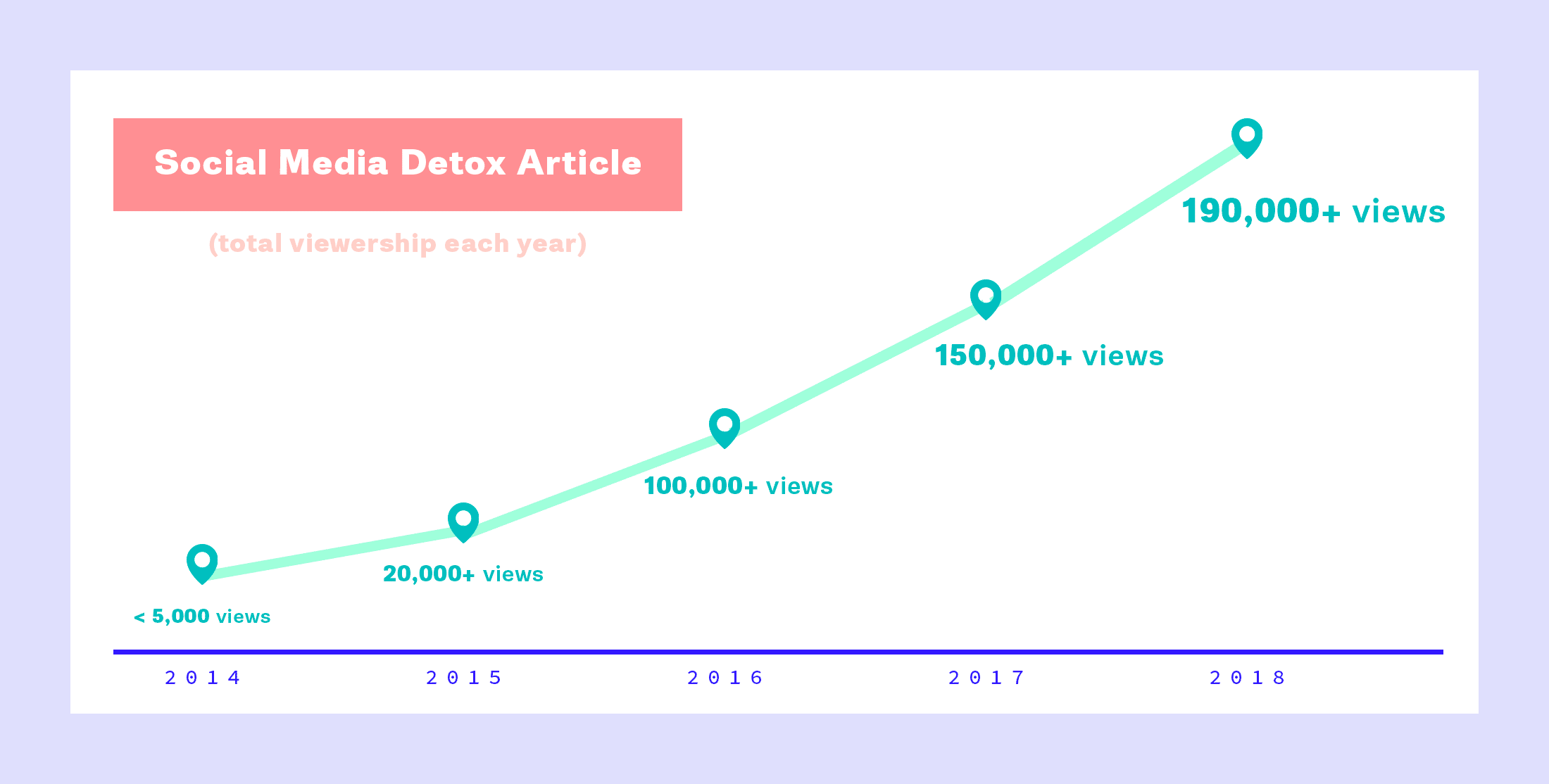
Fancy charts are fancy.
There are a few things to note about that article that may surprise you:
All things considered, I may as well have written, “don’t share this!” across the top and bottom of that article (obviously styling the text to match the yellow CAUTION tape you see at crime scenes).
If your intent is to create something under the guise that it will be shared you’ve almost already lost your battle to get attention from other people.
You need to create content that focuses on one or two things:
You can play all the keyword research games you want but if your content doesn’t help someone or doesn’t keep them entertained while reading it, you’re donezo. And kudos to you if you use words like “donezo” in your writing.
There is too much content in existence on the Internet nowadays and we’ve all developed a strong bullshit radar for growth-hacky content.
Now… hold on. Don’t flip over your desk in anger about how much you hate SEO and how much it confuses you and makes you want to punch pillows ’til the cows come home (a saying that I believe is catching on).

(Hopefully this isn’t you right now.)
When I talk about preparing your content for success, I just mean doing a couple of simple things that put you in good standing with search engines:
*Obviously this only pertains to WP users. For everyone else, just skip this step.
If you want to dive deeper into my extremely rudimentary process for SEO, read the full guide I created: Everything You Need To Know From My Experience With SEO
The reason to think about SEO just slightly when you’re writing content is to set yourself and your content up correctly from the beginning. Read: Do the things Google wants you to do so it can find and share your content for you!
Don’t aim for virality, aim for longevity.
For every single person reading this article (myself included), none of the content we create will go viral. And truthfully, virality should NOT be the goal. Viral content is a flash in the pan. It’s over and done with faster than you can blink, usually with zero long-term net gains.
However, long-lasting, quality content can continue on an upward trajectory. This is especially relevant if you create a piece of content, like my social media detox article, which was written before people started talking more and more about taking breaks from social media.

Thanks to my buddy (and SEO wizard) Brendan Hufford for helping me find this Google Trends graph!
You have to be patient with your content. My social media detox article didn’t start gaining organic search traffic and shares for months. In fact, it wasn’t until a year after originally posting it that people started to include a link to my article when they did a social media detox of their own and wrote about it.
IMPORTANT NOTE: I’ve had a handful of other articles follow the same pattern of how they took to get organic sharing and growth as my social media detox one:
There’s a recurring theme here and it’s that content worth sharing can take time to be found and to be shared. And again, none of those articles have share buttons, ask for shares, etc.
Takeaway #1: Don’t set out with the idea to create shareable content. Create helpful or entertaining (or both!) content.
Takeaway #2: Unless you can prove to me that those god-awful share buttons cluttering up your beautiful website are working, it’s time to remove them. They do not work. Great content gets shared because it’s great, not because a few buttons make it easier to share.
Takeaway #3: You can set yourself up for success by doing a little bit of SEO work. Just a few small things! You don’t need to hire an SEO professional.
Takeaway #4: Patience is incredibly important. If you’re creating helpful and entertaining content, publish it, share it where you can, then move on to the next piece of content you’re itching to create.
Takeaway #5: I didn’t mention this anywhere else but it’s probably time you go back through your older articles and see if you can make any of them go from good to GREAT. It’s easier to improve something that already exists than it is to create from scratch.
Unless this article helped you. Unless it inspired you. Unless it motivated you and gave you actionable steps you can take on your journey to having your content shared.
Otherwise, onto the next article you have open in those 43 tabs in your browser.
We’ve certainly said this on multiple occasions about our various business ventures.
But a funny thing has happened over the years as we’ve learned from our mistakes “running” our businesses: We’re damn tired of feeling like we’re always running!
With Wandering Aimfully we’ve made the public announcement of striving for enough. Not more. Not maximum profits. Not some arbitrary 7-figure annual income number. We actually did the math and figured out the amount of money we want to make to sustain the lives we want.
In May of 2013, I hung up my final t-shirt for my IWearYourShirt business and at the same time closed the flip-out LCD on my Canon DSLR video camera. After filming, editing, and uploading over 1,600 videos in a 5-year span (an average of nearly 1 video per day for 1,600 days straight) I no longer wanted to even think about creating a video, let alone touch a video camera. I was burnt-the-hell-out.
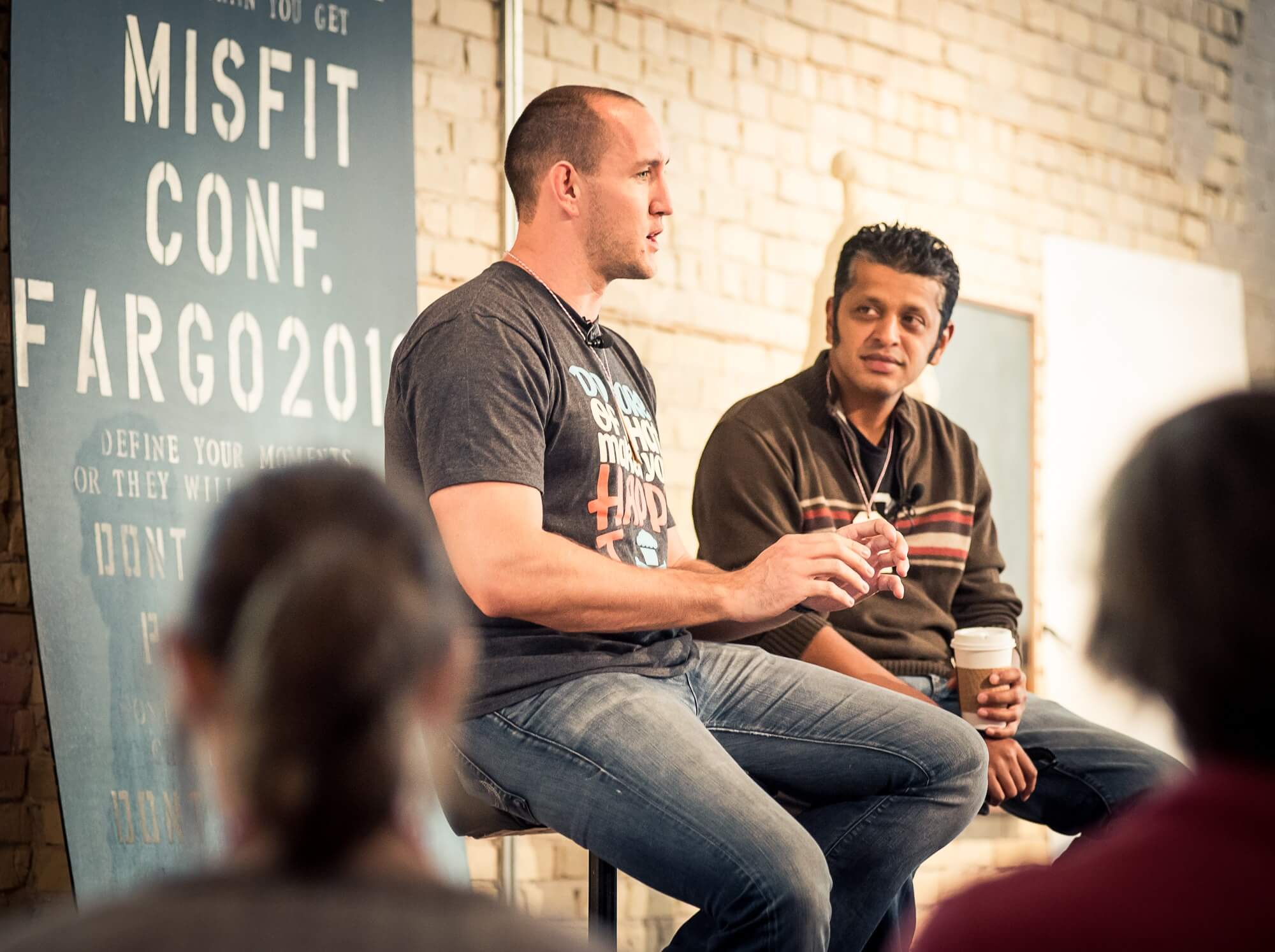
Admitting to a room of strangers in 2013 that I was completely burned out and my business was shutting down.
I’m not exaggerating when I say that it took nearly FOUR whole years to get over the negative feelings I had towards creating videos. Just thinking about the video-creation process gave me a swirling feeling in my stomach. Reaching for the video camera put me in a bad mood. Imagining myself having to edit any footage I shot made me depressed.
My feelings of burnout when it came to filming videos had come directly from “running” my IWearYourShirt business. I spent countless hours overworking myself to publish videos on a completely arbitrary schedule I’d forced myself into.
I left the 9am-5pm corporate world to chase down my own big idea (IWearYourShirt) only to find myself in a 9am-9pm job that felt like a career dungeon.
You’re currently running, running, running, with no end in sight and are afraid if you slow down everything will crumble around you?
As business owners, we often don’t realize the traps we set for ourselves and how much we over-work until it’s too late.
In 2018 I started creating videos again consistently with my wife but with a much more relaxed production schedule. I was NOT going to repeat my past mistakes. I was NOT going to work my fingers to the bone to push videos out quickly and at an unsustainable rate.
Instead, my wife and I…
An example video on our Wandering Aimfully YouTube channel.
This new mindset when it came to video production took me from feeling like I was always running around and burning the creation-candle at both ends to having a calm schedule that I could stick to and even get ahead with! (Novel idea!)
It can be hard to know, in the day-to-day of operating a business, if you are in “running mode.” Do any of these things hit too close to home for you:
If you feel the pain of those things we’ve been there with you. It’s incredibly common for business owners to get stuck in the spiral of these things for weeks, months, and even years.
Instead of running, think about short sprints.
We get it. You are creating a new thing. You are making a big transition. You are starting from scratch. No matter what, there will be times when you have to run and not walk. But you should think of these times as short sprints where you absolutely must set boundaries for your running time otherwise you’ll just continue to run.
When you need to put in the extra work, think of it as a sprint, not a marathon. Short sprints of additional working time that you will stop doing at a certain point and not allow to become bad habits.
We’ve all been preached the gospel of Hustle at one time or another. As I wrote in another article, We’ve Reached Peak Hustle-Porn.
Hustle should be reserved for short bursts (sprints!) Running your business should only need to happen for small periods of time. If you’re always going 100mph you’re going to get burned out.
I’m a firm believer that we’re all unique snowflakes, let’s get that out on the table. I truly think that every person has a unique skill and can offer something to the world in the form of their own business if they so choose.
However… That doesn’t mean everyone is cut out to operate their own business (running OR walking).
For some folks, the pressure and anxiety that come with the uncertainties of owning your own business are too much. That’s OKAY! That’s why there are a plethora of “real jobs” out in the world.
There is absolutely no shame in admitting that working for yourself is not the right path for you.
As much as you may want to work for yourself and chase down a big idea, it just may not be the right fit for you. Should you give a shot to see how it goes? 100% yes! But if it doesn’t work out you shouldn’t beat yourself up and you shouldn’t force yourself into debt, depression, or other negative things many of us go through.
We’re not going to lie to you and pretend you can just whisper our mantra of “I’m committing to walking my business” and POOF everything will change for you.
What we can do is tell you that IT IS possible to adopt the walking a business mindset even if you’re currently running.
We’ve seen it firsthand for our businesses and my example about our video production schedule is just one part of how we’ve made our shift from running to walking.
Here are a couple ways you can think about transitioning from running to walking your business…
Instead of focusing on never-ending growth, pick a number that you want to make monthly and when you hit that number stop. Don’t keeping going and working just because you can. Be content to use your extra energy and free time to enjoy the life you’ve created for yourself.
A tip for defining your enough number:
Total all of those up to find your enough number. If you want to read more about how we defined our enough number go here.
How many hours do you actually NEED to work each week to accomplish your tasks and financial goals? If you don’t create a cap, you’ll fill every waking hour with work. Caroline will often ask me around 5pm: Do you have more work to do today? And the answer is always, “there’s always more work to be done.”
If you own your own business, it’s hard to shut things down each day because our to-do lists constantly ongoing. By creating a cap of 5, 6, 7, or 8 hours of working time you won’t stay attached to your computer afraid of FOMO.
Do you need help managing your time? We have a few tips for you here.
For some of you reading this, taking any time off from your business will sound impossible. For some of you reading this, you may already be doing it (hurray, you!)
If it feels like you have to work on the weekends to keep up you are stuck in the “running a business” mode and you are going to burn yourself out.
Take the weekends completely off for the next two weeks and compare your revenue and work completion to the previous two weeks. Was the outcome drastically different financially? Did your customers throw up their hands in anger because you didn’t get back to them over the weekend? Did you enjoy time with your family or maybe get to some of those household projects you’ve neglected for years?
Those are just a few simple ways to transition from running to walking. Only you will know the areas of your business that are currently in control of you instead of the other way around.
From our own personal experience, we know that running our businesses only leads to health issues and burning out. Slowing down may seem incredibly difficult but if you are able to build better habits and make your business as efficient as possible, you can absolutely start walking your business.
Related: If this article left you feeling like you wish you had more to dive into to organize your business, especially how you manage your time and money (making your biz more efficient), we’d highly recommend going through our Back To Business Basics Guide. There are actionable worksheets and exercises to free up your time, generate more revenue, and get a better grip on your overall biz schedule.
If your client projects often seem to take longer than you think and time feels like it just slips away every day, we have some tried-and-true time management tips for you.
Do you wish you could carve out time to work on projects related to growing your business like creating content and perhaps a digital product to offset your client income? But do you feel like every second goes to client work?
You need a better system to feel in control of your schedule and we’ve got you covered!
(Ps. You can watch this post in video form here:)
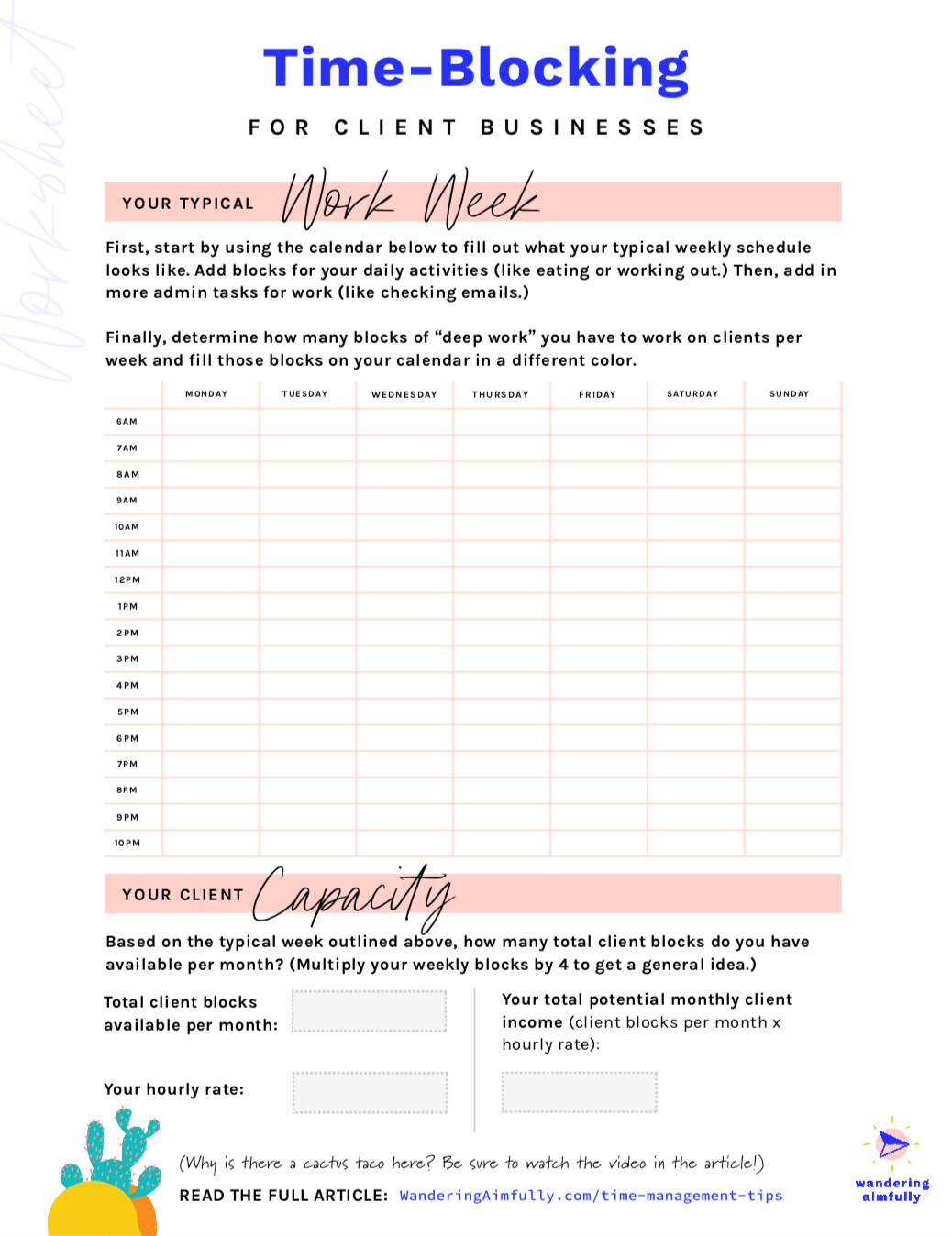
We know it’s unconventional, but we’re happy to give away some of our resources without making you give us your email address first. That said, if you DO find this article and this worksheet helpful, sign up for our newsletter where we share worksheets like this every Monday.
What the heck are micro-deadlines and how do they differ from normal deadlines?
Chances are if you work with clients you’re no stranger to deadlines. Your clients know when to expect the final deliverables to complete the project. But the problem with setting ONE fixed deadline at the end of a project is a little thing called Parkinson’s law.
This means if you only set one deadline at the end of four weeks, for example, you’ll fill that entire four weeks with the work for that project, probably not very efficiently.
It’s like defining one big bucket for the project and your time will expand to fill the bucket. Instead, try setting a final deadline AS WELL AS micro-deadlines throughout various stages of the process.
By defining these smaller “buckets” based on the specific tasks in each phase of your project, you can better keep your work contained to those individual buckets, making you more efficient overall and only spending the time necessary to complete each task.
This was by far the biggest game-changer for both of us, and it’s incredibly simple.
What exactly is time-blocking?
Realistically define how many “blocks” you have available for deep client work each week (by deep client work we just mean the actually doing of the creative thing, not answering emails or hanging on social media).
Then, schedule your clients by blocking off these hours on your calendar each week.
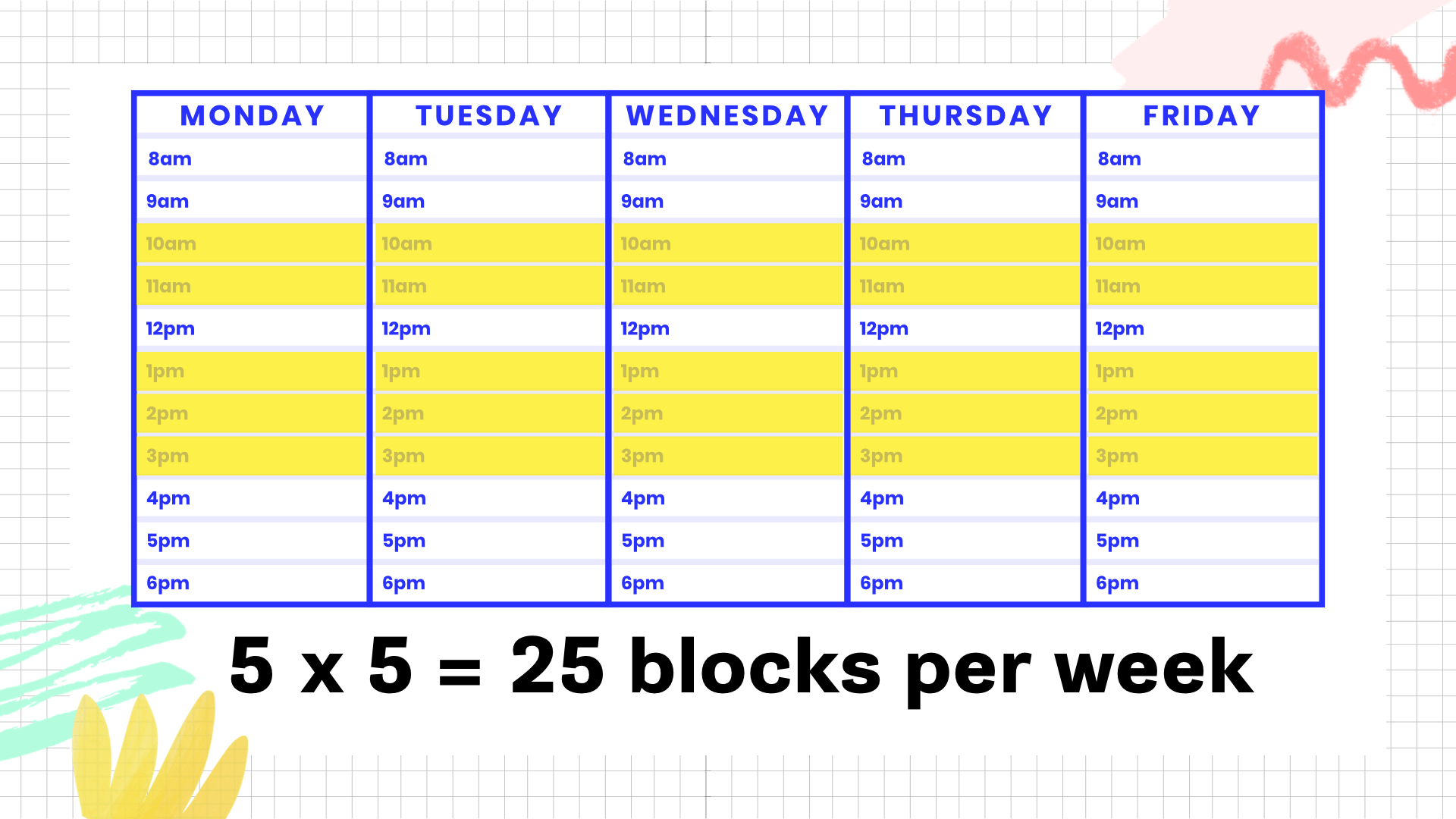
Not only will time-blocking help you with your client flow, but you’ll have a clear sense of what you should be working on each hour and that will help you avoid that feeling of time slipping through the cracks.
Time-blocking is also a great way to block off the things you want to make more time for aside from work like family, new creative projects, fitness or say building a new digital product.
Sounds like a no-brainer, right?
With every client proposal you send out, make sure you’re estimating exactly how many hours you’ll spend on it and doing what tasks.
Then… and this is the key… as you complete the actual project, make sure you’re using a time-tracking tool like Toggl to track your time and match each part of the process up to your estimate.
Remember that you’re being paid based on this time estimate, and every hour you go over, the value of your time plummets.
The closer you stick to your estimate, the more efficient your projects will be.
One big deadline for a client project is good in theory but not great in practice. Sure, you can still use a project completion deadline, but you should also create micro-deadlines along the way (we recommend weekly milestones for micro-deadlines).
Look at your calendar as a group of available blocks. Instead of just saying you’re going to get XYZ part of a client project accomplished in a day, break bigger tasks into 30-60 minute blocks and put them directly on your calendar.
Incorrectly estimating the time it takes to complete a client project is the fastest way to run a business that isn’t profitable. Your time IS money and you need to estimate it and track it properly. Use a time-tracking product like Toggl and you’ll start to figure out exactly how long your work ACTUALLY takes and you’ll get better at estimating client projects.
Working nights and weekends, and not getting paid what you’re worth is not a healthy way to live or run your business. When you have a client-based business, your TIME is your money-making asset so it’s important to use it wisely.
Just implementing a few of these changes could drastically improve your well-being AND your bottom line.
We, Caroline and Jason Zook, the people behind Wandering Aimfully, both come from a client-business background. I, Jason, started my first business in 2007 called Thought & Theory which was a small web design company. Caroline started a design business focused on branding in 2014 called Made Vibrant.
(Ps. Feel free to watch the abridged video version of this guide here:)

We know it’s unconventional, but we’re happy to give away some of our resources without making you give us your email address first. That said, if you DO find this guide and this worksheet helpful, sign up for our newsletter where we share worksheets like this every Monday.
We’ve worked with thousands of clients and know how helpful it can be to create a revenue stream that isn’t directly tied to trading time (one-on-one) for money.
But, transitioning your business from clients to digital products can be daunting. Where do you start? What digital product is best? How the heck do you find the time to create a digital product while barely having enough hours in the day to run your client business?
We’ve got you covered! In the next few sections of this guide, we’ll break down the transition from clients to digital products in manageable and practical steps.
Wait, what? We aren’t diving head-first into the digital-product-creation waters? No friend, we are not.
You see, part of making any transition in life (or business) is to do so gradually so that you don’t overwhelm yourself and sabotage your chances of actually completing the process.
Raise your hand if you’ve tried to make a big shift in your life only to fall back into old habits a few weeks later? Yeah, we’ve been there too.
This is why we start this guide with an important foundational task…
Everyone put on your Practical Pants (patent pending), it’s time to get a few key pieces of your client business humming along as smoothly as possible.
We can’t stress the value and importance of time blocking enough. The basic principle is to look at every hour of your day (or 30-minute chunk) as a block of time that you can spend on work, life, etc. Let’s say you want to only spend five hours working every day. Your time blocking might look like this:
That’s just one example of how you can structure your day using time blocking. One important thing you might notice is that time blocking isn’t reserved just for working hours.
You want to use time blocks for your life/adulting schedule as well because if that’s not in order it will impact the time you have available to work on client projects each day.
 time
time
This example image of time blocking shows the hours you block off for client work. It’s also a great way to see how many billable hours you spend each week to ensure you’re getting paid for your time spent work. In this visual, you’d ideally be working 25 hours per week!
 time
timeWhen you run a client-based business your time IS money. Each hour you work you need to be getting paid for otherwise, you’ll run a business that isn’t profitable. Use a time-tracking app like Toggl.com to actually “clock in” when you start working.
As example, you could start tracking your time using the schedule above at 10am. Did you, in fact, get two hours of work done for Client ABC as you planned? Did the tasks and milestones you had for that client get accomplished?
By actually tracking your time and comparing it to your client proposals/estimates you can find out how efficient your business is currently running.
Time is a funny thing. When we give ourselves as much time to accomplish a task it can feel like that task goes on forever. This is proven in science by Parkinson’s Law:
Parkinson’s law is the adage that “work expands so as to fill the time available for its completion”. If you give yourself three hours to complete a task your brain will think it has three hours even if the task could be completed in one.
By constricting the amount of time you can spend on any given to-do item, you’ll get better at working quickly and efficiently. Both Caroline and I saw this happen firsthand with our design businesses. What used to take us multiple hours could get accomplished in a fraction of the time when we only allowed ourselves a certain amount of time to complete what we were working on (yes, that included getting into “design flow”).
When your working hours are efficient you’ll get faster at accomplishing your work, thereby freeing up hours for… you guessed it… digital product creation!
But hold on, we’re not quite ready to jump into digital product creation. Let’s tackle one other big foundational topic…
You know those people that say, “describe for me your perfect day – what does that look like for you?” and you just want to slap them? We get it. We want to slap those people too at times. However… they bring up a really valid exercise.
It can be easy to dismiss the perfect day question as impossible. No one has a perfect day, right? Well, just because no one actually HAS a perfect day, doesn’t mean we can’t set ourselves up for the best day possible.
Part of transitioning from client work to digital products is understanding what your life looks like during the transition and after (depending on what your specific goals are).
Your Lifestyle Vision for the 6-month part of the transition could look something like:
Now, obviously, those 6-months milestones aren’t going to happen just because you envision them happening. That’s what the rest of this guide is for! But before we jump ahead, let’s also outline examples for 12 months.
Your Lifestyle Vision for your business in 12 months:
It’s great to imagine your perfect life. It’s wonderful to think about your work days filled only with work you love doing. But these things don’t happen because you simply think about them.
Your ideal life happens when you prioritize making it happen.
What are the steps you need to take to get yourself from where you are right now in your transition to digital products?
Use your Lifestyle Vision to write out a plan of action to get you where you want to go in the next 6 or 12 months. Break it down month by month or week by week to give yourself an action plan.

Odds are if you run a client business right now you may not have an email list of any kind. You might have social media accounts but they’re used more for photos of your dog and your food adventures than anything business-related. Unlike digital products, having an audience isn’t a necessity when it comes to landing clients and working with a handful of people each month.
If you want to transition to selling digital products, building an engaged audience around your product topic is an absolute must.
Fear not! Building an audience doesn’t have to be scary and intimidating. You also DON’T need to build a big audience. What you need to focus on is building the right audience of people, people who will become customers of your digital products.
I’m going to highlight some high-level audience building tactics in the next few paragraphs but we also have an accompanying guide devoted to Audience Building if you want to bookmark that for future reading: The Ethical Guide To Building An Email List Without Sleazy Tactics
For the rest of this guide let’s pretend you’re a web designer (haven’t you always dreamed of pushing pixels around??) You currently offer your web design services to clients and that’s as far as you’ve gotten. This is you and this is the example we’ll focus on going forward. Cool? Cool.
As a web designer who works with clients you know what it takes to run a web design company, or just work as a freelancer, or however you want to describe it. The person you KNOW you can help is a previous version of you!
So often people want to embark on a completely new journey with digital products, forgetting that they’ve spent years honing a skill they can teach other people (read: previous versions of themselves).
One example customer: Someone who is just getting started as a web designer.
Okay, great. We have a customer in mind, but let’s define a few more things about them to make them your ideal customer. Some questions to think about (and answer):
By answering those questions and adding more texture to your example customer you create your ideal customer. Now you might talk about your ideal customer like this:
I help web designers who want to work a flexible schedule, who won’t work with companies that harm the environment, who aren’t afraid to make jokes about The Office, and who predominately build Squarespace websites.
Holy moly, that’s specific, right? Do you immediately think that feels limiting? Well, guess what? It’s not.
It’s unlikely that you will always be talking to your ideal customer but your goal should be to try to so you can attract the RIGHT people and push away the wrong people.
By getting specific with who your ideal customer is you can speak more clearly to the things that resonate with them. Trust me on this one, the more you can create a connection with customers, the easier it is to help them AND get them to purchase from you.

Remember that Lifestyle Vision exercise where we said 6 months and 12 months were the milestones? Well, that’s on purpose because it takes time to build a digital product business while running your existing client business.
The things you’re going to need extra time for while you make the transition from clients to digital products are:
Right now we’re just talking about the third bullet in that list, so you can see how thinking you’ll build an audience overnight might not be a practical idea.
We do have another in-depth guide that goes into audience building, but we won’t leave you high-and-dry here. The quick hits of what you need to think about when it comes to building an audience of your idea customers are:
Now, granted these five items all have their own bit of nuance and tactics, but they are the most important things should focus on.
Two items of additional reading if you want to dig deeper on building an audience:
The Ethical Guide To Building An Email List Without Sleazy Tactics – Our in-depth guide I mentioned on building an audience. This is the way we’ve built email lists over 25,000+ people who support us and have been the main source of our income since 2013.
Define Road Runner Rules To Create A Foundation For Your Business – To go a bit deeper into identifying your ideal customer you can use this Road Runner Rules article to create a set of rules for your business.
We’ve watched it happen time and time again: Someone puts up a website, has defined their ideal customer, starts creating content, has an email list, and then two months later completely stops showing up. Why does this happen so often? Because people’s expectations about how many audience members they’re going to attract in a short amount of time are never clearly defined (and if they are, are unrealistic).
It’s time to work your way backward from your 6-month Lifestyle Vision and see what needs to be done in the audience building part of this transition process.
When it comes to digital product sales, a really good email list will convert at 3-5%. To be honest, if you’re starting your audience from scratch right now, you’ll probably see a much higher conversion percentage because you’re going to build an audience around a specific topic and digital product offering.
For our example, let’s assume you’re selling a $100 online course. Quick math would tell us that you’d need 20 customers per month to reach your 6-month goal of $2,000 per month in revenue.
(Feel free to adjust these example numbers with your own estimates to get the most realistic idea for your situation!)
With 20 customers being your estimated number, if we go back to that 3-5% conversion metric and pick 5%, you would need to grow an email list of 400 subscribers in 6 months (400 * .05 = 20). That doesn’t sound too bad, right? It shouldn’t! But remember, you’re trying to make $2,000 per month, so you may need to set your sights a bit higher by the end of 6 months if you want to get 20 customers per month.
So, let’s recap:
These numbers are ABSOLUTELY doable! The key is going to be establishing realistic numbers for yourself and then making sure you’ve built a content funnel to attract and help the right customers.
Speaking of content, ready to talk about that?
There’s one simple thing I want to ask you to kick off this section on content:
Where do you go when you need to find the answer to a question?
You answered Bing, right? It’s totally Bing! Okay no, you probably said Google (or maybe even YouTube).
The way you think of searching for answers to questions is the way you should think about creating content to grow your digital product audience!
While social media can be important, we believe digital product businesses need searchable content FIRST. Sure, an Instagram and Twitter strategy can be helpful, but those platforms don’t readily offer up answers to people’s questions (unless, you know, that question is how many cute puppies can I scroll through in the next 4 hours??)
If you guessed that we had a separate guide dedicated to content creation and search engine optimization (SEO), then you would be correct! I’m not going to leave you high-and-dry in this guide, but you may want to bookmark our SEO Guide as well.
Bookmark this sucker for future reading: Everything You Need To Know From My Experience With SEO
When I say “searchable content” I’m explicitly referring to written posts/articles or videos. Seeing as Google and YouTube are the #1 and #2 places people go to search for answers to their questions, it makes sense to focus your content creation efforts on one of those platforms first.

That image shows you two articles that are the #1 result in Google and drive significant traffic to this website. But, and this is important, those articles were never written to be the #1 result in Google, they were written to be helpful and to answer a specific question we knew people were searching for (because we searched for it ourselves!)
One of the biggest myths when it comes to creating content is that you have be a “writer” in the sense that most of us think about that word.
Raise your hand again if you have imposter syndrome when it comes to writing. It’s okay if your hand is up, we’ve been there too!
I was most certainly NOT a writer when I started my previous website JasonDoesStuff that shared a helpful entrepreneurial article every week from 2014 – 2018. Each week I set out with the intention of writing a helpful article about taking more action in your life and business (a topic that, admittedly, was a bit too vague). From 0 website visitors and 0 email subscribers in 2014 my articles started to gain some traction in Google search results and through my own promotion efforts. At the end of the first 6 months, I’d written 26 articles, my website was consistently getting over 10,000 visitors per month, and my email list had grown to 2,500+ people. This was without having a guide like this to help me speed up that process (or have any concrete plan of action!)
Those five little words were an amazing jolt to my writing muscles. All I had to do was fill in the rest of that sentence with something I wanted to help people with and I had a topic to expand upon.
Now, for you, we’re going to take that tactic up a notch and go back to the focus on searchable content. I’m using a web designer for the examples below, feel free to replace with your current focus and come up with a few “I want to help yous…” for your ideal customer/audience member:
On and on and on. My guess is you can probably rattle off 10-20 “I want to help yous…” in the next 5-10 minutes. And the beauty of that is you just came up with your first 10-20 articles!
When you’re just dipping your toes in the content creation waters it can be easy to think an article isn’t good enough. Yet, unless someone emails you and tells you that, there is no reason you should think it.
Now, I’m going to be 100% honest with you: Your early content is probably going to suck. This is OKAY!
Every couple years I go back and read through my old articles and I’m embarrassed by them. How the heck did people not cringe at what I wrote? But then I remember that most people are just looking for answers to their questions, they don’t really care about how well something is written.
Consistency will prove to your readers that you’re going to deliver helpful information to them and on a schedule you’ve promised. You are delivering value directly to them and they will thank you for it by continuing to give you their attention (and hopefully eventually some of their money for your digital product).
We, humans, love consistency. Our brains enjoy repetitive patterns. Rather than letting perfectionism or thoughts of self-doubt keep you from hitting publish on your writing, remember that consistency is more important than quality early on.
Further reading: Afraid to start writing? Give yourself permission to start ugly.
If you’re new to the content creation and audience building world, it can feel like you’re talking to absolutely no one. We should know, Caroline sent her first weekly email newsletter to just FOUR subscribers (yes, 4, and two of them were her email and my email).
One way to avoid feeling like you’re talking to no one is to go where people are already spending their time. This is known as “guest posting” in the content creation space.
Important Note: We want it to be clear you should be creating content for your website and audience FIRST before doing guest posting. It’s important to have your own content and audience building stuff in place for when you direct people from other sites to you!
You aren’t going to be awarded a guest post on someone else’s website just because you want it to happen. You’re going to need to pitch yourself and your content so it makes sense for someone to let you get access to their audience.
There are a couple important things to think about when it comes to pitching an article to someone:
Think of guest posting as one segment of your Totem Pole of Content (also patent pending). You don’t need your entire totem pole to be devoted or reliant on other people’s websites, but it is helpful to tap into existing audiences now and again.
This may seem like a no-brainer, but even on your own website, it should be extremely clear that someone should join your email list after reading an article. Heck, you may even think about having an email signup form in the middle of an article if that feels right.
Remember, you want to help people, but you also want to reach your goal of transitioning away from a client-focused business. Having an audience gives you people you can help and promote your digital products to. Whether that’s on someone else’s website or your own, be sure to have an easy way for people to get on your email list for more helpful content and updates around your specific topic of focus.
We looooooooove pre-selling around these parts. In fact, I believe we’ve pre-sold every single digital product we’ve ever created (and we have around 30+ products under our digital belts!)
Pre-selling your digital product does two things really well:
Idea validation is wonderful, especially when there is money associated with it.
Someone giving you money just for your idea is all the proof you need to know you’re on the right track to running a digital product business!
You may be thinking this is going to be a long section, but truthfully, pre-selling does not have to be very complicated. In fact, all of our pre-sales pages have been simple and straight to the point.
In these few paragraphs, we’re going to keep up the web designer example and pretend you’re selling a course that helps web designers get more clients.
Problem: The first thing you want on your simple pre-sale page is a headline that grabs your potential customer’s attention and addresses the clear problem you’re solving for them.
Example: Is finding your next web design client stressing you the heck out? Do you wish you had a system you could follow to land clients consistently?
Outcome: Next, after you’ve stated the problem, you’ll share your solution to that problem and the outcome your customer wants for themselves.
Example: Years ago when I was doing web design the bane of my existence was wondering where I’d get my next client from. Every week it would weigh on me and it effected my ability to work without stressing out about where the next client would come from. That all changed when I created a simple process that carved out actual time with practical tasks to help get more clients. In just a few short weeks of work, I was able to go from stressed out about where my next client would come from to being booked 3-6 months in advance! I can help you have the exact same results!
Product: You addressed the problem, you shared your own outcome, now it’s time to show how the product you want someone to purchase is the answer to the problem.
Example: I’d like to introduce you to Web Designers Who Get Booked, my step-by-step online course that walks you through the exact processes I created to go from stressing about clients to booking my web design services months in advance. In Web Designers Who Get Booked, I’ll share the client outreach tactics that actually work, my non-complicated system for staying ahead of my client schedule, and a few pointers on how to feel more confident when it comes to selling your web design skills.
Example Part Two: You may also want to share a bulleted list of the lessons included in the course (doesn’t matter if you’ve created them yet) and if you can get some social proof (testimonial) from someone who’s used your processes, include that as well.
Purchase: Finally, you stated the problem, your own outcome, you described your digital product offering, and now it’s time to let someone pay you in advance!
Example: You’ll obviously have a buy button and connect that to a payment processor of your choosing (Gumroad is really easy to use for this, or if you’re building an online course my software company Teachery can help you pre-sell your course). Alongside the buy button, you want to make it 100% clear that the online course/digital product isn’t quite ready yet but will be delivered in X amount of days (or on a specific date). Let your customer know they are getting early access and maybe even offer them a discounted price on the course since it’s a pre-sale. It’s also a good idea to only offer a pre-sale for a short amount of time so you can get out of sales/marketing and actually make your digital product!
Click here to view the example pre-sale page 👍
These are two great questions to ask yourself, but as you can imagine we have some advice and personal experience with both.
If you have a larger audience and you’re not trying to hit some huge financial goal (remember your Lifestyle Vision from Step #2!), you may want to constrict your pre-sale to a shorter amount of time (48 hours). Why? Having fewer customers, in the beginning, is actually better because you’ll have fewer people to get feedback from and manage.
If you have a smaller audience you might need one full week along with multiple emails to convince your customers to jump on your pre-sale.
Whichever audience-size category you fit into, we recommend at least sending this many emails and on this schedule for your pre-sale:
This may seem like a lot of communication with your email list but remind yourself how often you launch and create digital products. Especially if this is your first product, you’ll need more touch-points to get your audience warmed up to buy.
A customer purchasing your product from you before it actually exists is a really awesome thing. If you can afford to offer a discount and can make it reasonable (a 5% discount is dumb, don’t do that), then we firmly believe in offering a pre-sale discount.
You can position this in your emails and on your pre-sale page by saying something to the effect of: Web Designers Who Get Booked will be $100 when it goes live, but for this pre-sale, you get 25% OFF and only pay $75!
Offering someone a discount during a pre-sale doesn’t devalue your product. If anything, it rewards a customer for taking action and proving to you that your idea is worth paying for.
Remember, these folks are taking a chance on you. They’re buying something from you that doesn’t even exist yet and you owe it to them to communicate effectively and honestly.
During my previous pre-sales, I’ve sold a product that would take two months to create. During the two months after the pre-sale was over and leading up to the release of the product, I communicated with my pre-sale customers every two weeks. Not only did this make them feel at ease and that they knew I wasn’t going to move to a tropical island and never deliver the course I promised, but it gave me a chance to get some feedback on content within my product and to get customers excited by showing behind the scenes photos and screenshots.
If you want to avoid angry or complacent customers, plan to reach out to your pre-sale buyers and they will thank you for it by sharing your digital product for you once it exists for other people to buy it!
Yes, your pre-sale customers probably got a discount on your digital product, but you should think about planning to surprise them with something else along the way.
When I pre-sold my Get Sponsorships For Podcasts course back in 2015 I had a digital book called One Week To Profit (priced at $99) that had seven helpful tips for online business owners. To me, it felt like a nice surprise to give them this digital book for free and it felt like a good fit since most podcasters own their own businesses. When I surprised my pre-sale customers with this added bonus people were shocked and excited. Many of them went to Twitter and Facebook to talk about how happy they were and how other people should look into buying stuff from me.
What is something you can surprise and delight your pre-sale customers with? It doesn’t have to be a full-blown digital book, it could be as simple as a few extra worksheets, templates, or even a group call once the course is live to answer Q&As.
Keep something in your back pocket and your customers will thank you for it by using word of mouth to promote you and your products!
Now, there’s a lot to unpack here and we aren’t going to pretend we can walk you through the digital product creation process in just a few paragraphs.
Shameless plug, if you’ve read the majority of this guide and have found it helpful but you’re looking for some step-by-step processes, accountability, and want to transition from clients to digital products without burning out in the process our Build Without Burnout Academy is perfect for you!
Pros to online courses: Online learning is a humungous industry and people don’t want to go to physical buildings or crack open long boring books to learn anymore. People want to learn from people who’ve been where they want to go and online courses are the perfect medium for that. One of our favorite parts about online courses is the blend of teaching content, written word, and a contained space for knowledge that’s easy to access.
Cons to online courses: It can be difficult to limit yourself on how much you want to teach in an online course. It can also be hard to price your online course, especially if you’re creating your first one. There are some technical abilities needed, but that’s really dependent on the complexity of your course (does it have videos, timed components, worksheets, etc?) And, you typically need to pay for an online course software, you can’t easily host a great online course on your own website with a few clicks.
Pros to e-books: E-books are a great way to give someone an in-depth look at something. Heck, we could’ve turned this guide into an e-book and it would probably sell on its own. Unlike paper books, you can update the info in an e-book easily and it doesn’t have to “go to print.” Plus, e-books can be sold easily through other marketplaces (think: Amazon, iBooks, etc).
Cons to e-books: Designing and laying out an e-book that doesn’t suck isn’t something all of us have the ability to do (I know I don’t!) Prepare to invest money and pay an e-book designer to help you make your e-book easy to read and fun to page through. E-books can get a bad rap but that’s mostly because people phone-in the production quality and try to charge a lot more than the knowledge in the book is actually worth.
Pros to membership communities: Creating monthly recurring revenue with a membership community is a great way to have a consistent income. For us, having a paid membership community (shameless plug!) is also personally fulfilling because we’ve surrounded ourselves with people who are on a journey we know we can help with (and are on ourselves). Membership communities are great because they’re flexible and can evolve over time.
Cons to membership communities: The technical logistics of a membership community can be challenging depending on what you’re trying to do/build. Also, churn. Churn is the term for people canceling their membership and this is something that’s bound to happen. Fighting the good fight against member churn takes effort and can give you some mental hurdles in the beginning.
There are many other types of digital products you could create. We simply wanted to highlight the three we have the most experience with that most folk (like you!) can create on your own.
Cool with you if we bring back our Web Designers Who Get Booked online course example? Great. Let’s do that!
Creating an outline as the first step in your digital product creation process is mandatory. You may want to dive into the more fun aspects like design, video recording, etc, but your product outline is your foundation and you NEED a solid foundation.
Okay, I think you see what I did there, yeah? But that’s exactly how you want to think about the outline for your digital product. Let’s look at an outline example for Web Designers Who Get Booked:
Hopefully, that outline example gives you food for thought on how you might structure the content of your digital product. The great thing about putting together a simple outline is that you can move different parts around easily and it sets you up for…
If you put on your to-do list, “make an online course” you will never get it done. Ever. That’s a really big task. Instead, you want to use your digital product outline as your guide and then pepper in all the ancillary things it takes to bring your digital product to life.
Remember the Time Blocking exercise we brought up wayyyy back in Step #1 of this guide? Use it again and block time off on your calendar each day for your digital product creation process.
Here’s an example for you:
To make the time blocking process even easier you may want to do a separate bulleted list of every single task you can think of related to creating your digital product. This may seem like a waste of your time, but it’s actually really helpful when you want to start time blocking!

We know it’s unconventional, but we’re happy to give away some of our resources without making you give us your email address first. That said, if you DO find this guide and worksheet helpful, sign up for our newsletter where we share worksheets like this every Monday.
If you’re a go-getter, read the previous section, and started writing your outline, you’re on your way to building your digital product! YAY YOU!
We like to think about building digital products in these phases:
After we’ve completed building our digital product we do our own simple testing:
This list of things may seem daunting. Remember, you want to break all of this stuff down into smaller pieces that you can tackle in different time blocks.
Out of all the digital products we’ve created we have the most experience with online courses. We actually have TWO How To courses about making online courses.
If you’re looking for a step-by-step guide to creating an online course (or e-course) as your digital product, please read this article: How To Build And Sell Your First E-Course
Before we wrap up this section on creating your digital product we want to remind you of one important thing: Digital products are digital. Yep, mind-blowing info, right?
It’s so easy to get stuck in the weeds trying to create a perfect digital product out of the gates. There’s no doubt you’re going to obsess over some part of the creation process (we know, we’ve been there). However, it’s incredibly important you remember how easy it is to update a digital product!
Your digital product is not etched into a slab of stone, so be okay with an imperfect product that you iterate on and improve over time.
You’ll most likely have a list 20 bullet points long with new things you can add to your digital product but odds are you may only need to add 3-4 of those things.
Pro-tip: Build the smallest, best version of your digital product and then survey your paying customers with questions about what could be added to it.
Don’t ask strangers on the street. Don’t ask your friends. Ask the people who paid you money for your digital product and then add the stuff that gets asked about the most.
This mindset of starting with an imperfect digital product and being willing to iterate on it over time is the BEST way to keep your sanity in the process. Plus, when you do add new stuff to your digital product and you give that new stuff to your existing customers, they’ll love and appreciate you for it!
If you recall, this guide is about making the transition from clients to selling digital products. The last part of that transition is going to be the part where you launch your product and continue to sell it.
There’s a lot that goes into launching and selling but we’re going to break down the bigger parts in five separate topics.
Okay, let’s rip the band-aid off a few important things:
It’s impossible to avoid the trappings of a “big launch” or a “six-figure launch” or any of the other headlines and success stories you read about in the digital product space. But… there is so much context to those stories that we don’t have. Instead, you need to define a realistic measure of success that matches your Lifestyle Vision.
Time and time again we’ve watched fellow entrepreneurs gear up for a big first launch, have less than amazing results (mostly because they didn’t define their own success), and then never launch again. Ugh. You should think of your first launch as your next starting line. It’s not a finish line in your digital product journey, it’s an entire new marathon you opt in to run.
It’s just a weird thing to do! You’re asking strangers on the Internet to buy a thing from you that you created out of thin air. That’s bizarre! Accept this. Understand it. Embrace the fact that you’ll feel uncomfortable but don’t count yourself out and NOT sell your digital product.
You’re seeing a recurring theme in this guide, aren’t you? Iteration. Tweaking. Testing. Using an experimenter’s mindset is part of the game, especially when it comes to crafting a sales page for your digital product.
Remember the P.O.P.P. method (Problem, Outcome, Product, Purchase) we told you about back in Step #5? It’s time to bring it back around, but expand it to: P. O. P. S. E. P.
You already know the Problem, Outcome, Product, Purchase part, you can almost copy and paste from your pre-sale page for your main digital product sales page (maybe expand slightly if you have more to share in those topics). The two new things are:
Take a minute and remember the last thing you purchased that was recommended by a friend. It could be anything. The purchase was a no-brainer for you due to one important factor: You trust your friend!
Social proof on a sales page is how you show strangers on the Internet that other strangers on the Internet trust you. It’s as simple as that.
Do you have customer’s who have experience with your digital product? Send them an email and ask for 2-3 sentences about what they liked (make sure to get their approval to share their response). Boom, easy peasy.
If you don’t have customers yet? Get a few! Even if they get your digital product at a steep discount, or for free, spend the time to have someone actually use your product and give you a testimonial about it.
Add at least 2-3 pieces of social proof to your sales page and use photos of the actual people if you can (again, trust!)
When your digital product is ready to be sold you shouldn’t be afraid to play a little show and tell. One of the most frustrating things for me when I’m looking at sales pages is when I can’t see the actual digital product in any shape or form.
Are you selling an e-book? Give away the first chapter or two. Don’t be afraid to share what’s inside, if someone loves it, they’ll purchase the rest.
Are you selling an online course? Show people a screen recorded video that walks through the lessons, the content, and gives people an exact look at what they’re getting into.
You get the idea. Share visual examples of what you’re selling to instill trust in your prospective customers (and remove any guesswork on their part of what they’ll get).
No matter what digital product you sell, keep the P. O. P. S. E. P. method handy (Problem, Outcome, Product, Social Proof, Examples, Purchase)
Whether you’re selling your digital product on an ongoing basis (“evergreen product”) or your doing a couple launches per year (“open and closed cart”) you are going to need a series of sales emails that convince someone your digital product is worth spending money on.
We really like doing open and closed carts for our digital products. We choose this method because it puts us in control of when we have to be in sales and marketing mode. Selling things as evergreen is fine, but we don’t like having the thoughts of sales and marketing in the back of our minds at all time. Plus, experience has shown us that an open and closed launch provides the urgency many people need to make an actual purchase.
That being said, here’s what our 7-email sequence looks like:

If you’re interested in getting a thorough walk-through of our 7-email sequence, we recorded an entire workshop about selling and our Wandering Aimfully Members get it included in their membership. If there’s one thing we have down to a science, it’s the process of selling and launching!
As much as some online marketers and entrepreneurs want you to believe, it’s pretty damn difficult to create a hands-off passive income digital product.
Myth: Creating passive income isn’t as passive as you think.
We’ve created over 30 digital products since 2013 and none of them have been 100% hands-off. Even the digital products that have sold consistently we’ve spent time:
Remember the example 12-month Lifestyle Vision from Step #2? It’s okay if you don’t we’ll remind you of what those things were:
As “passive” as you hope your digital product business to be, it will require time and effort. Just remember, you chose to transition away from client work for a reason!
If you’ve read this far into this in-depth guide we have to imagine you are willing to do the work it takes to transition from clients to digital products. We also realize you might be a tad bit overwhelmed as there’s a LOT to unpack and implement here.
Within our Wandering Aimfully Membership is our cornerstone program Build Without Burnout Academy. It’s a six-month program to help client-based business owners transition into selling digital products —without burning out in the process.
This isn’t some secondhand knowledge we Googled, this is our exact experience as we transitioned from designers doing client work to creative entrepreneurs selling digital products.
The first and most important thing is it’s a 6-month long program. It’s not 6-weeks. It’s not a 6-month program you can cram into 1 month. It’s a program that forces you to stick to the timelines we’ve set to ensure that you don’t get overwhelmed and give up on transitioning from clients to digital products.
If you nod your head in agreement to any of these statements Build Without Burnout is for you:
You currently have clients but you know you want to create a digital product (like an online course, membership community, e-book, etc) and feel like you’ll never have the time.
You’re tired of trading time for money and feel like you’re always scrambling to find your next client to pay yo’ bills.
You’ve experienced burnout before due to overworking and you want to avoid it at all costs while still having a plan of action moving forward.
You’ve been sold the “you’ll make 6-figs with an online course!” dream and you aren’t having any of that (you’re okay with making fewer figs and enjoying your life in the process).
You’ve read nearly every word of this massive in-depth guide and thought, “I wish Jason just had this stuff as a guided program that I could follow because it seems kind of overwhelming just reading all of this.”
You’ll have weekly action items and to-dos, but the entire goal is to make it manageable with your current client business.
If you’re excited and ready to learn more, check out our Wandering Aimfully Membership page (remember: Build Without Burnout Academy is our cornerstone program within our membership).
We put a ton of time and effort into these guides. This one could have been twice as long and three times as thorough but we had to draw the line somewhere.
If you took our advice in this guide, don’t hesitate to reach out and let us know what was most helpful.
And if joining our Wandering Aimfully Membership feels right so you have a group of folks who are on a similar transition from clients to digital products, we’d be delighted to have you!

You want to create a digital product so all your business revenue isn’t tied to trading hours for money, but you have multiple product ideas you’ve been thinking about.
If you have no idea how to pick the best digital product idea to pursue, we have three simple and tips to help you narrow it down. Ready to choose ONE idea to focus on so you can start building and making additional money? Let’s do it!
(Ps. You can watch this post in video form here:)

We know it’s unconventional, but we’re happy to give away some of our resources without making you give us your email address first. That said, if you DO find this article and this worksheet helpful, sign up for our newsletter where we share worksheets like this every Monday.
One big mistake we often see business owners make is that they build a small audience related to their service, but then want to create a product on a completely different topic out of left field.
Is this you right now? Maybe it’s motivated by boredom because you spend all your time on your main service offering, or maybe it’s just because you’re multi-passionate. Either way, you’re likely making it harder on yourself by trying to reinvent the wheel.
Even if you have an email list of 500 people or a small social media following, that group of people is already paying attention to what you’re doing and that’s a valuable asset.
If you’re short on time and you want your first product to offset some of your client income, help yourself out by choosing the idea that’s the most natural fit with the small audience you already have.
What does your existing audience need? What are they interested in? Start where you are, get some momentum and THEN you can always create that other “left field” product later on down the road.
Want to know which of your product ideas is most viable? Quit guessing and instead put your ideas to the real test by asking people to pre-pay for them!

Refine one or two of your ideas enough to put up a simple sales page, and promote the page or pages to your audience. Of course, be sure to let them know it’s a pre-sale, and they may have to wait a while to receive the final product.
Set a benchmark for yourself for how many presale orders you need in order to justify investing the time building the product.
This has two benefits. #1: It will show you if there’s enough interest in your idea to make it financially viable BEFORE you carve out time to build it. And #2: It will make you set a deadline to deliver your product and an audience to be accountable to, which might just motivate you to finally create what you’ve been meaning to create.
Okay, the last two tips are pretty strategic and are based on the assumption that your digital product HAS to make you money right away.
Enthusiasm, excitement, and passion go a long way in fueling you through the difficulties of bringing your idea to life.
You can over-analyze all you want or strategize which idea will have the greatest impact on your business, but sometimes you just have to go with your gut and make that thing that keeps nagging at your brain.
Maybe it will take your business to the next level, maybe it won’t, but we guarantee you you’ll end up learning a lot and you’ll experience the satisfaction of finally getting that exciting idea out of your brain and into the world.
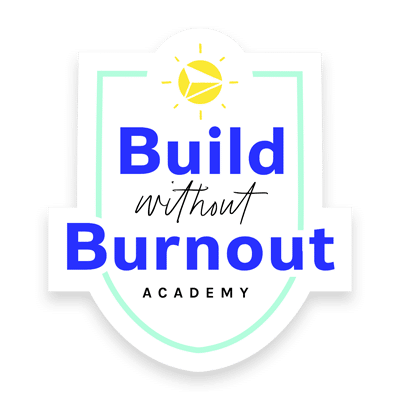
This is a six-month guided program teaching client-based business owners how to transition to digital products, without losing your sanity in the process. Get weekly course videos, monthly calls for accountability and support, plus get access to the rest of our courses and Slack community inside our Wandering Aimfully Membership.
It’s easy to get distracted with all the ideas of unrelated products to what you currently talk to your audience about, but staying focused on what your audience already expects from you will point you in the right direction. Save your “left field” product idea for later on once you get a digital product created and generating revenue.
Collecting email addresses and positive sentiments on social media can feel validating for your product idea but the BEST validation tactic is to get people to put their money where their mouths are (you know, without actually doing that because of germs). Don’t be afraid to launch a pre-order before your digital product exists. If you can get your audience to buy into the idea of the product you’ll know you’re onto something!
When all else fails, listen to your gut. Your intuition exists for a reason and often times guides you in the right direction. If you simply can’t make a decision on which product idea to choose, lay them out in front of you and let your gut decide.
The most important thing is that you stop over-thinking things and start taking action. Use one of these three tips to finally narrow in on a product idea and go all in on making that a reality.
Business is about experimentation and you won’t truly know which idea is right for you until you make a decision, build the thing and learn from the experience.
On September 24, 2008 an idea hit me that completely changed my trajectory in life and business. I was going to ask the world to pay me (a nobody living in Florida at the time) to wear a sponsored t-shirt and create content on social media. At the time there were barely any people on Twitter, Facebook was still a closed platform (you had to have a college email address), and being a “vlogger” wasn’t a thing on YouTube. But it wasn’t just my IWearYourShirt idea that kicked off on that day, it was the decision to work for myself and run my own business.
Since that day day in September of 2008, I’ve learned an immense number of valuable lessons. I’ve written two books (#1 and #2) that go into greater detail of my entire entrepreneurial adventures, but I thought it would be fun to give you an abridged version with 10 entrepreneurial lessons that may help you if you’re currently working for yourself or thinking about working for yourself.
Many times during these past 10 years I’ve tried to skip the hard work I knew it would take to launch a project, build a website, manage customers, etc. I wanted to believe the shortcuts, cheatsheets, and blueprints that other people were offering could help me skip the hard work and patience it actually requires to succeed when working for yourself. I was wrong. Every time. If you aren’t willing to do the work, in whatever shape or form “the work” takes, you will not succeed. But if you are willing to put in the hours, the effort, and push through tough/ambiguous times, you will be successful (however you define that success).
Additional reading: What It Takes To Be An Entrepreneur
It’s unbelievably easy to let our brains get caught up in the trappings of more. To crave more money, more attention, more likes, more everything. It would’ve saved me a lot of mental battles and money had I been willing to sit down and clearly define what “enough” meant to me. These days Caroline and I always define what our enough is for anything that can be measured (the amount of money we can make, the amount of subscribers we can get, etc). By drawing a clear, realistic, line in the sand of where we’ll be happy, we’re able to enjoy every part of the process and never get stuck dreaming for bigger and better.
Additional reading: Why You Should Focus on Enough Instead of More
Have you ever had these thoughts: “I don’t know why someone would buy from me” or “too many other people are already doing XYZ thing I want to do.” Those and many other assumptions will stop you dead in your tracks before you even have a chance to see if they’re correct or not. I feel very fortunate that I’m wired to question every thing in life, at every turn. Now, my family and wife may have some thoughts about how that way of thinking can be a bit of a pain in the ass, but it has served me well in business to never get stuck worrying or letting self-doubt stop me before I got going.
Any assumption you have, especially about business, should be tested with actual data and proven right or wrong. Also, if you’re sharing your ideas with friends and family, they will absolutely share their assumptions with you. Don’t let THEIR fears stop YOU.
Additional reading: Challenge All of the Assumptions, Especially Your Self-Limiting Ones
I’m a big advocate of outsourcing your weaknesses and not spending time doing things you aren’t good at or don’t want to do. However, learning the basics of HTML/CSS, SEO, marketing, sales, and accounting, can help you speak the language of the people you are outsourcing to. There are multiple times in the past decade when I blindly accepted someone’s advice thinking I could trust them on their word, only to find they did crappy work that had to be redone. Had I known the basics of what they were working on, I could have asked the right questions along the way and avoided the headaches.
You don’t need to become an expert in anything you aren’t going to use on a daily basis, but you should arm yourself with a basic knowledge so you’re not completely in the dark and having to rely on trusting strangers with your business.
Additional reading: Outsource Your Weaknesses To Run A Happier and Healthier Business
The first couple years of my entrepreneurial journey I would’ve benefited from having a mentor or a coach. Someone with experience who could’ve guided me through situations that most business owners encounter. Instead, I was too proud to ask for help (the next lesson will address this). I believed I could do everything myself and that I didn’t need any help. Wrong. When you’re working for yourself, having someone you can confide in, brainstorm with, give you time-worn advice, and set you straight when you’re veering off your path is immensely valuable. Having Caroline come into my life hasn’t just been amazing for me personally, but she’s someone I can talk to at a moment’s notice who’s smart, creative, experienced, and extremely supportive. I 100% realize you may not have a Caroline in your life (sorry!) but you should absolutely try to find a person or a community that can support you on your journey.
Additional reading: Bad Friends Are Toxic, Here’s Why You Should Reevaluate Friendships
Pride is probably one of the biggest double-edged swords for me in the past 10 years. While it’s been part of my success to put my crazy ideas out into the world, it’s also been my downfall on many occasions. My pride got me into $100,000+ in business debt. My pride burned a bunch of relationships over the years. My pride kept a project going longer than it should have. My pride has kept me trapped a few more times than I’d like to admit, and I don’t wish that for you. The best advice I can give when it comes to dealing with your pride is in Lesson #2: define your enough. By establishing clear boundaries of enough, you can keep your pride at bay.
Additional reading: It’s Okay If You’re Feeling Lost
There are lots of little moments throughout the past 10 years where I’ve put money aside and opted for being a good human over being a ruthless business owner. Whether it was as simple as giving someone a refund or spending thousands of hours replying to emails from people asking for advice, empathy can go a long way. You can’t see empathy on a Profit & Loss statement, but being an entrepreneur isn’t just about profits for me. It’s about being helpful and about passing on all the lessons I’ve learned in every aspect I can. It’s about treating people with respect and trying to give more than you get. The long-term side effect of operating with empathy is attracting a group of customers who are loyal and who feel appreciated by you.
Every idea I’ve had since 2008 has had a website. I’ve spent so much time, energy, money, and effort to make my websites welcoming, fun, and informative. But all that effort would’ve been worthless if I didn’t spend the time to promote my website and use my creativity to help people find it. Much like building the most beautiful hotel in the middle of the desert, if you don’t tell people it exists and build roads to it, no one will ever find it. I believe there is a clear path to running your own online business and helping people find whatever you’re building:
Exciting and shiny social media channels will come and go throughout your time building your own business. Being helpful and actually showing up for your customers never goes out of style. There’s no algorithm that can stop you if you’re willing to do consistent creative work.
Additional reading: The Ethical Guide To Building An Email List Without Sleazy Tactics
I bought in early on entrepreneurship. The day I stood in my closet 10 years ago and committed to starting IWearYourShirt was the day I also said, “I’d rather work for myself for the next 30-40 years than show up at a job that takes 1/3 of my life from me.” So many aspiring business owners are dreaming of a magical payday that will never come. If you simply accept the fact that working for yourself is a gift and something you can enjoy, you’ll be okay with building your next thing for 5-10 years and planning to continue to do it well after that.
I’m at year 10, and yet I feel like we just hit the reset button on the video game of our entrepreneurial lives. We have a brand new business, website, podcast, content strategy, customer base, etc, and while it can seem daunting, I also understand that I have 10 years of experience and lessons learned I get to apply to this recent reset. It’s not going to be easy, but I know we’ll avoid the missteps and traps I’ve fallen into in the past.
Find a way to enjoy the process and your impatient desire to have it all fall into place overnight will start to disappear.
In other words, be intentional about appreciating how far you’ve come. This is probably one of the most helpful thoughts you can have when working for yourself (or just being grateful for where you are in life). Is where you are at this very moment a place you could only dream of a few years ago? It’s easy to get stuck and think things aren’t perfect in your life/business, but if you look back to where you were a few years ago and realize where you are today is some semblance of a dream come true (no matter how small the dream is), take that moment to be grateful. If you aren’t where you wanted to be, what are YOU going to do to make your dream come true in the next few years?
It led me down a path that brought me to this moment and this life, and that’s pretty darn cool. Whether you’re at the beginning of your entrepreneurial journey, or like me you’ve been at it for a decade… here’s to the next 10 years!